
- Used RV Inventory
- Sell Your Used RV
- RV Financing
- Privacy Statement
- Refund Policy
- Testimonials

2020 Palomino Columbus 329DVC | $58,000

2009 Winnebago View 24P | $60,000 Charlotte, North Carolina

2021 Forest River RV XLR Nitro 35DK5 | $59,000 Atlanta, Georgia

2015 Heartland Bighorn 3010RE | $29,500 Apache Junction, Arizona

2022 Renegade Verona 40VBH | $290,000 Glenwood, Maryland

2016 Winnebago Adventurer 35P | $118,000 Boise, Idaho

2021 Mercedes Sprinter 170” Extended Wheelbase | $200,000 Denver, Colorado

2021 Forest River Wildwood 32BHDS | $32,000 Beavercreek, Ohio

2001 Monaco Dynasty Regent 40FD | $64,500 Jasper, Texas

2019 Tiffin Phaeton 40IH | $255,000 Tavernier, Florida

2013 Winnebago Adventurer 37F | $91,900 Kodak, Tennessee

2007 Newmar Dutchstar 4307 DSDP | $99,900 Pigeon, Michigan

2022 Jayco Jay Flight SLX 7 – 174BH | $20,800 Junction, Texas

2019 Winnebago Itasca Navion 24V | $99,000 Evansville, Indiana

2015 Forest River Salem Hemisphere Lite | $29,500 Calhoun, Louisiana

2022 Coachmen Leprechaun 260DSF | $86,000 Bandera, Texas

2016 Forest River Forester MBS 2401R | $69,000 Melbourne, Florida

2003 Chinook Concourse XL | $39,000 Troy, Michigan

2015 Nexus VIPER 29V | $66,000 Kenosha, Wisconsin

2007 Tiffin Allegro Bay 34XB | $45,000 Fuquay-Varina, North Carolina

2004 Chevy AstroVan AWD | $15,750 Saint Johns, Arizona

Used RVs By Owner is a “For Sale By Owner” website with no RV dealer ads to compete with.
Looking to sell a used RV? List your RV in one simple step with our secure online form , or call us and speak with a used RV listing specialist.
You can read some of our client's testimonials by clicking Here!
Looking to buy a used RV? Browse used RV listings with our user friendly search where you can search by location, class, make & model, and even price range. You can contact the owner directly by telephone or email.
New Listings

East To West Tandara
View Details

Forrest River Sunseeker 2250LE

Grand Design Solitude 390RK

Winnebago View 24P

Airstream Flying Cloud 25′

Grand Design Imagine XLS 17MKE

Forest River RV XLR Nitro 35DK5

Keystone Montana 3582RL

Heartland Bighorn 3010RE

Newmar Bay Star Sport 3306

Entegra Qwest 24R

Renegade Verona 40VBH
Search Used RVs
Spotlight used rvs.

Social Media
List Your Used RV
Advertise your Used RV now starting at $49.00!
Used RV Blog
- Champion Camping Chili
- Taking Good RV Photos
- Winter RVing Tips
Office Contact
Toll Free (844) 400-8151 [email protected]
Used RVs By Owner Lakewood, CO 80214
© 2023 Used RVs By Owner, All Rights Reserved
- Popular Professionals
- Design & Planning
- Construction & Renovation
- Finishes & Fixtures
- Landscaping & Outdoor
- Systems & Appliances
- Interior Designers & Decorators
- Architects & Building Designers
- Design-Build Firms
- Kitchen & Bathroom Designers
- General Contractors
- Kitchen & Bathroom Remodelers
- Home Builders
- Roofing & Gutters
- Cabinets & Cabinetry
- Tile & Stone
- Hardwood Flooring Dealers
- Landscape Contractors
- Landscape Architects & Landscape Designers
- Home Stagers
- Swimming Pool Builders
- Lighting Designers and Suppliers
- 3D Rendering
- Sustainable Design
- Basement Design
- Architectural Design
- Universal Design
- Energy-Efficient Homes
- Multigenerational Homes
- House Plans
- Home Remodeling
- Home Additions
- Green Building
- Garage Building
- New Home Construction
- Basement Remodeling
- Stair & Railing Contractors
- Cabinetry & Cabinet Makers
- Roofing & Gutter Contractors
- Window Contractors
- Exterior & Siding Contractors
- Carpet Contractors
- Carpet Installation
- Flooring Contractors
- Wood Floor Refinishing
- Tile Installation
- Custom Countertops
- Quartz Countertops
- Cabinet Refinishing
- Custom Bathroom Vanities
- Finish Carpentry
- Cabinet Repair
- Custom Windows
- Window Treatment Services
- Window Repair
- Fireplace Contractors
- Paint & Wall Covering Dealers
- Door Contractors
- Glass & Shower Door Contractors
- Landscape Construction
- Land Clearing
- Garden & Landscape Supplies
- Deck & Patio Builders
- Deck Repair
- Patio Design
- Stone, Pavers, & Concrete
- Paver Installation
- Driveway & Paving Contractors
- Driveway Repair
- Asphalt Paving
- Garage Door Repair
- Fence Contractors
- Fence Installation
- Gate Repair
- Pergola Construction
- Spa & Pool Maintenance
- Swimming Pool Contractors
- Hot Tub Installation
- HVAC Contractors
- Electricians
- Appliance Services
- Solar Energy Contractors
- Outdoor Lighting Installation
- Landscape Lighting Installation
- Outdoor Lighting & Audio/Visual Specialists
- Home Theater & Home Automation Services
- Handyman Services
- Closet Designers
- Professional Organizers
- Furniture & Accessories Retailers
- Furniture Repair & Upholstery Services
- Specialty Contractors
- Color Consulting
- Wine Cellar Designers & Builders
- Home Inspection
- Custom Artists
- Columbus, OH Painters
- New York City, NY Landscapers
- San Diego, CA Bathroom Remodelers
- Minneapolis, MN Architects
- Portland, OR Tile Installers
- Kansas City, MO Flooring Contractors
- Denver, CO Countertop Installers
- San Francisco, CA New Home Builders
- Rugs & Decor
- Home Improvement
- Kitchen & Tabletop
- Bathroom Vanities
- Bathroom Vanity Lighting
- Bathroom Mirrors
- Bathroom Fixtures
- Nightstands & Bedside Tables
- Kitchen & Dining
- Bar Stools & Counter Stools
- Dining Chairs
- Dining Tables
- Buffets and Sideboards
- Kitchen Fixtures
- Wall Mirrors
- Living Room
- Armchairs & Accent Chairs
- Coffee & Accent Tables
- Sofas & Sectionals
- Media Storage
- Patio & Outdoor Furniture
- Outdoor Lighting
- Ceiling Lighting
- Chandeliers
- Pendant Lighting
- Wall Sconces
- Desks & Hutches
- Office Chairs
- View All Products
- Designer Picks
- Side & End Tables
- Console Tables
- Living Room Sets
- Chaise Lounges
- Ottomans & Poufs
- Bedroom Furniture
- Nightstands
- Bedroom Sets
- Dining Room Sets
- Sideboards & Buffets
- File Cabinets
- Room Dividers
- Furniture Sale
- Trending in Furniture
- View All Furniture
- Bath Vanities
- Single Vanities
- Double Vanities
- Small Vanities
- Transitional Vanities
- Modern Vanities
- Houzz Curated Vanities
- Best Selling Vanities
- Bathroom Vanity Mirrors
- Medicine Cabinets
- Bathroom Faucets
- Bathroom Sinks
- Shower Doors
- Showerheads & Body Sprays
- Bathroom Accessories
- Bathroom Storage
- Trending in Bath
- View All Bath
- Houzz x Jennifer Kizzee
- Houzz x Motivo Home
- How to Choose a Bathroom Vanity

- Patio Furniture
- Outdoor Dining Furniture
- Outdoor Lounge Furniture
- Outdoor Chairs
- Adirondack Chairs
- Outdoor Bar Furniture
- Outdoor Benches
- Wall Lights & Sconces
- Outdoor Flush-Mounts
- Landscape Lighting
- Outdoor Flood & Spot Lights
- Outdoor Decor
- Outdoor Rugs
- Outdoor Cushions & Pillows
- Patio Umbrellas
- Lawn & Garden
- Garden Statues & Yard Art
- Planters & Pots
- Outdoor Sale
- Trending in Outdoor
- View All Outdoor
- 8 x 10 Rugs
- 9 x 12 Rugs
- Hall & Stair Runners
- Home Decor & Accents
- Pillows & Throws
- Decorative Storage
- Faux Florals
- Wall Panels
- Window Treatments
- Curtain Rods
- Blackout Curtains
- Blinds & Shades
- Rugs & Decor Sale
- Trending in Rugs & Decor
- View All Rugs & Decor
- Pendant Lights
- Flush-Mounts
- Ceiling Fans
- Track Lighting
- Wall Lighting
- Swing Arm Wall Lights
- Display Lighting
- Table Lamps
- Floor Lamps
- Lamp Shades
- Lighting Sale
- Trending in Lighting
- View All Lighting
- Bathroom Remodel
- Kitchen Remodel
- Kitchen Faucets
- Kitchen Sinks
- Major Kitchen Appliances
- Cabinet Hardware
- Backsplash Tile
- Mosaic Tile
- Wall & Floor Tile
- Accent, Trim & Border Tile
- Whole House Remodel
- Heating & Cooling
- Building Materials
- Front Doors
- Interior Doors
- Home Improvement Sale
- Trending in Home Improvement
- View All Home Improvement
- Cups & Glassware
- Kitchen & Table Linens
- Kitchen Storage and Org
- Kitchen Islands & Carts
- Food Containers & Canisters
- Pantry & Cabinet Organizers
- Kitchen Appliances
- Gas & Electric Ranges
- Range Hoods & Vents
- Beer & Wine Refrigerators
- Small Kitchen Appliances
- Cookware & Bakeware
- Tools & Gadgets
- Kitchen & Tabletop Sale
- Trending in Kitchen & Tabletop
- View All Kitchen & Tabletop
- Storage & Organization
- Baby & Kids
- Housekeeping & Laundry
- Pet Supplies

- View all photos
- Dining Room
- Breakfast Nook
- Family Room
- Bed & Bath
- Powder Room
- Storage & Closet
- Outdoor Kitchen
- Bar & Wine
- Wine Cellar
- Home Office
- Popular Design Ideas
- Kitchen Backsplash
- Deck Railing
- Privacy Fence
- Small Closet
- Stories and Guides
- Popular Stories
- Renovation Cost Guides
- Fence Installation Cost Guide
- Window Installation Cost Guide
- Discussions
- Design Dilemmas
- Before & After
- Houzz Research
- View all pros
- View all services
- View all products
- View all sales
- Living Room Chairs
- Dining Room Furniture
- Coffee Tables
- Home Office Furniture
- Join as a Pro
- Interior Design Software
- Project Management
- Custom Website
- Lead Generation
- Invoicing & Billing
- Landscape Contractor Software
- General Contractor Software
- Remodeler Software
- Builder Software
- Roofer Software
- Architect Software
- Takeoff Software
- Lumber & Framing Takeoffs
- Steel Takeoffs
- Concrete Takeoffs
- Drywall Takeoffs
- Insulation Takeoffs
- Stories & Guides
- LATEST FROM HOUZZ
- HOUZZ DISCUSSIONS
- SHOP KITCHEN & DINING
- Kitchen & Dining Furniture
- Sinks & Faucets
- Kitchen Cabinets & Storage
- Knobs & Pulls
- Kitchen Knives
- KITCHEN PHOTOS
- FIND KITCHEN PROS
- Bath Accessories
- Bath Linens
- BATH PHOTOS
- FIND BATH PROS
- SHOP BEDROOM
- Beds & Headboards
- Bedroom Decor
- Closet Storage
- Bedroom Vanities
- BEDROOM PHOTOS
- Kids' Room
- FIND DESIGN PROS
- SHOP LIVING
- Fireplaces & Accessories
- LIVING PHOTOS
- SHOP OUTDOOR
- Pool & Spa
- Backyard Play
- OUTDOOR PHOTOS
- FIND LANDSCAPING PROS
- SHOP LIGHTING
- Bathroom & Vanity
- Flush Mounts
- Kitchen & Cabinet
- Outdoor Wall Lights
- Outdoor Hanging Lights
- Kids' Lighting
- Decorative Accents
- Artificial Flowers & Plants
- Decorative Objects
- Screens & Room Dividers
- Wall Shelves
- About Houzz
- Houzz Credit Cards
- Privacy & Notice
- Cookie Policy
- Your Privacy Choices
- Mobile Apps
- Copyright & Trademark
- For Professionals
- Houzz vs. Houzz Pro
- Houzz Pro vs. Ivy
- Houzz Pro Advertising Reviews
- Houzz Pro 3D Floor Planner Reviews
- Trade Program
- Buttons & Badges
- Your Orders
- Shipping & Delivery
- Return Policy
- Houzz Canada
- Review Professionals
- Suggested Professionals
- Accessibility
- Houzz Support
- COUNTRY COUNTRY
Local Furniture Stores in Elektrostal'
Location (1).
- Use My Current Location
Popular Locations
- Albuquerque
- Cedar Rapids
- Grand Rapids
- Indianapolis
- Jacksonville
- Kansas City
- Little Rock
- Los Angeles
- Minneapolis
- New Orleans
- Oklahoma City
- Orange County
- Philadelphia
- Portland Maine
- Salt Lake City
- San Francisco
- San Luis Obispo
- Santa Barbara
- Washington D.C.
- Elektrostal', Moscow Oblast, Russia
Professional Category (1)
- Accessory Dwelling Units (ADU)
Featured Reviews for Local Furniture Stores in Elektrostal'
- Reach out to the pro(s) you want, then share your vision to get the ball rolling.
- Request and compare quotes, then hire the Furniture & Accessories professional that perfectly fits your project and budget limits.
The best times to buy furniture in Elektrostal' to get the best deals:
- For indoor furniture, the best times to buy and save are in January, July, and during holiday weekends. Retailers often offer discounts during these periods to clear out old stock before introducing new styles in February and August. Similarly, Presidents Day and Labor Day weekends are great for sales.
- Outdoor furniture is more affordable during the summer months, especially around the 4th of July when many retailers offer discounts.
If you are planning a home remodeling project and intend to buy new furniture, it’s essential to time your purchases strategically. Buying furniture too early might lead to storage issues and increased chances of damage during the remodeling process. On the other hand, waiting too long could leave you with limited options and potential delays in completing your project.
What should you know about a Furniture and Accessories Manufacturer?
Here are some basic questions to ask before visiting furniture makers or buying furniture and accessories:, business services, connect with us.
safari camper for sale

sales plan in business plan sample
How to create a sales plan: a complete guide (tips + examples).

Write a sales plan that can adjust to change, and zero in on the actions that will hit your goals.

Paul Bookstaber
Share article.
- Link Copied
There is a world where sales planning happens once a year. You draw it up in January — “Whew, I’m glad that’s done!” — and everything goes as you planned. You hit your goals.
Meanwhile, on Earth, you create a sales plan, start to act on it — and everything hits the fan. A competitor launches a new product, an analyst switches up their report, and your best sales rep quits. Now what?
Below we share tips for how to create a sales plan that can bend to change and not break. You’ll learn why a sales plan is so important, see examples of the different types, and discover how to create one that brings you closer to your big hairy revenue goals — while also driving down costs.
Make sales plans that deliver more revenue
Our Sales Planning solution can help you align your targets, budget, and headcount — with just a few clicks.

What is a sales plan?
A sales plan is a blueprint for hitting revenue targets. It begins when sales leaders define long-term company goals. Then, sales managers create an annual sales plan to achieve those goals, adjusting it as market conditions change. They make decisions around hiring, quotas, compensation, territories, and customer segments. Finally, sellers translate the annual sales plan into account plans to close individual deals.
What are the benefits of creating a sales plan?
The key benefits of creating a sales plan are about hitting your targets with the resources you already have . First, it allows you to spot the gaps in your sales process that block you from your goals and address them with the best actions. Second, it sets you up to adapt fast to changing business and market conditions.
Let’s take a closer look.
Finding the actions to achieve your goals
A sales plan lets you test and measure how different actions will affect your numbers, so you can choose the right path forward to hit your goal.
You begin by adding up the numbers you know — how much your team will likely sell (based on past performance) and how much it will cost (based on your current resources). You’ll arrive at a prediction of the numbers you’ll hit.
If the prediction falls short of your targets, a sales plan helps you test different scenarios so you can find the action that forces the equation to spit out your target number in the most cost-effective way.
What if you hire more people? Increase your quotas? Level up your enablement program to increase win rates (the number of deals that close)? A sales plan gives you the framework to crunch the numbers until you find the reality that matches your dream.
Your business is more resilient to change
The traditional sales plan is something you create once a year. An agile sales plan is something you revisit, test, and adjust continually. The benefit is that even as market conditions change or surprises happen within your company, you can study the impacts of those changes and adapt to stay on track.
The path to agility is to do away with your disconnected tools and bring all of your sales plan data into the same system — your customer relationship management (CRM) system — where you sell. With this in place, changes in the real world show up as threats to your target within your plan. You can react in real-time, studying the data, testing different scenarios, and adjusting your sales plan to get back on track.

Map a clear path to success with annual planning
Set goals, target metrics, and key responsibilities during yearly planning with sales operations. Discover how on Trailhead, the free learning platform from Salesforce.
Annual Planning with Sales Operations

Sales plan types and examples
The different types of sales plans are meant to bring together your company’s long-term vision, short-term tactics that get you there, and everything in between. Leaders set a five-year track for where the company is heading. Then, sales managers step into a new time frame — the year — with sales forecasts and territory plans that help sellers hit their numbers. They come up with capacity plans to make sure teams are running lean and mean. Finally, sellers create account plans for every deal.
Let’s take a closer look at these different types of sales plans with the examples below.
Long-Range Sales Plan
This is where leadership comes together — people like the CEO, chief revenue officer, CFO, and VP of sales — and set the long-term path for the company. They’re thinking about where the opportunities are and how to seize them. For example, they might decide to grow annual contract value (ACV) by $30 million in the next five years, while also slowing the rate of hiring — because they want to make existing sellers more productive instead.
Annual Sales Plan
The sales manager creates an annual sales plan to set immediate targets and decisions that will help the company get closer to the goals established in the long-range sales plan. This plan begins with an understanding of the team’s capacity, or how much revenue they’re likely to produce. From there, territories, quotas, and compensation plans are set to ensure that sellers hit their numbers.
If, for example, the long-range sales plan is to achieve $30 million in ACV over the next five years while also making sellers more productive. Then a sales manager might set targets of $4 million in ACV in the first year and increase the quotas that sellers carry to hit that goal rather than hire more people.
Territory Plan
Don’t just segment customers based on geography. You should also segment them based on categories meaningful to the business. For example, if you want to sell to more enterprises, you might want to segment customers based on their size, and match sellers with enterprise expertise to enterprise companies. You can also segment customers based on industry and assign them to sellers with industry expertise.
Account Plan
Now that sellers know their targets and their territories, they take on planning of their own — customer by customer — with account plans. They strategize how to bring more value to every conversation and close individual deals . They research the needs of the customer, identify obstacles that stand in the way of selling, and list action items for how to build relationships to move each deal forward. Then, they work with different people within their company to execute on their account plans. They might connect with business development representatives (BDRs) to get a foot in the door with new leads, or with solution engineers to create demos for presentations.
How to create a sales plan
To create your annual sales plan for the year and make sure it can adapt to change, bring all of your sales data into one place. Then, study how much your people can sell (based on historical data), and set targets and incentives that will make your goal a reality. Use technology that can update all your sales plan data in real-time, so you can measure the impact of change and adjust to stay on track.
Ready to create your sales plan? Here’s how to take it one step at a time.
1. Connect sales plan data with your CRM
It’s important to build your sales plan in customer relationship management (CRM) software. When you have all your sales data in one central place, updated in real-time, real world changes show up as misalignments in the data. You have visibility into changes that put your targets at risk.
Without this single source of truth, you’d be spending weeks manually pulling in data from different systems, trying to understand the impact of the disruption. With every passing day, the gap between your plan and your reality widens.
Imagine that you begin an enterprise sales push with 50 sellers in January, but two have quit by March. A CRM can send you an alert that you’re under target. That real-time data is critical if you want to adjust your plan quickly to stay on track.
2. Understand your team’s capacity (how much they can sell)
Using your CRM data, take a look at capacity — that’s how much revenue you predict your team can sell during the coming year. To calculate capacity, look at all metrics that affect sales output, including hiring data, a review of quotas and targets, and historical sales rep performance data to predict future sales.
Following the example above, you might determine that based on the previous year’s performance, each seller, on average, can bring in $120,000 worth of revenue. However, now that you’re short two sellers, you’re short $240,000 in your capacity.
3. Measure the gap between your reality and your dream
Now that you understand the reality of who’s under your roof — and how much you think your team can sell — determine the gap between your revenue predictions and your revenue targets.
For example, imagine your target from the long-range sales plan is to hit $6 million in ACV this year. With $240,000 down in your capacity, as we showed above, you’ll need to figure out how to still meet the goal.
4. Find the actions to fill the gap and reach your goal
It’s time to write your sales plan to achieve your targets. Begin with the backbone — your team — and outline what’s expected (quotas), what the rewards are (compensation), how to organise customers (segments), and how to assign the reps (territories).
Then, to close the gap and hit your targets, create “What if?” scenarios to test the impact of different possible actions. The guideposts here should be cost savings and efficiency — how to hit your target by making the most of what you have. What if you hire two more people? (Straight-forward, sure, but hardly cost-effective.) What if you assign your highest performers to more lucrative territories? What if you create an enablement program that trains your sellers in a strategic industry?
In the example above, you’re trying to find a way to add $240,000 to your capacity without adding cost. One of the scenarios you tested shows that a new enablement program might do the trick, because training your sellers to sell more effectively can help you close more and bigger deals. This can be your Plan A. But since it will require investing in a new enablement program, you might want to come up with a Plan B as well that doesn’t require additional budget. For example, you might propose increasing each seller’s quota.
5. Present your proposed actions to leadership and execute
Make your case to leadership to get the rubber stamp on your proposed best action. Show them the data in your sales plan to demonstrate why your proposed solution will hit your targets and be cost-effective at the same time.
You might make the case for Plan A: investing in a new enablement program. If leadership balks because of cost, then it’s time to roll out Plan B: Increase each seller’s quota instead. Sales reps might protest at first, but you can reframe it as an opportunity to make more money. You’re in sales, remember? Finding the positive spin is what you do.
6. Keep adjusting and stay on target even as market conditions change
Change will come — whether from outside forces (think a disruption in your customer base) or inside forces (think a pivot in your product roadmap). The mindset shift is to take your sales plan off the shelf, dust it off, and reimagine it as a living, breathing thing. It’s something you adjust continually throughout the year — with your sights pinned to your goal.
Ready to turn your sales plan into a reality?
With the steps above, you’re ready to go. Study the real-time sales plan data in your CRM, measure the impact of the change on your goals, test different possible actions, and go with the best one. This is agile sales planning. It says, “Bring it on!” to change.
Learn how thousands of sales pros are driving productivity — today

Just For You

What Is a Sales Pipeline and How Do You Build One? A Complete Guide

Your Sales Tech Stack Is About to Get a Whole Lot Smaller

Explore related content by topic

Paul Bookstaber is a writer at Salesforce. He has a decade of experience in content marketing in B2B tech. Before that, he published a magazine and ran a tabloid blog. Today, he splits his time between Florida and the Mountain West, and loves to hike, ski, and watch Bravo. He is in a polyamorous relationship with Luke and Roger, who are cats.
Want Trailblazer tips and thought leadership straight to your inbox?

Predictive Analytics: Shaping the Future with Salesforce

Understanding Process Automation: Examples and Benefits

From Service to Sales: How Field Service Can Drive Revenue Growth

7 Sales Dashboards Every Team Needs (With Examples)

Mastering Lead Management: The Ultimate Guide for Success

What is Sales Automation? A Complete Guide

What is a Sales Process?

How Will Generative AI Affect Sales Reps’ Jobs?

New to Salesforce?
- Why Salesforce
- What is CRM
- Explore All Products
- Customer Success
- Product Pricing
About Salesforce
- Security and Performance
- Salesforce.org
- Best CRM Software
- Sustainability
- Give us your Feedback
Popular Links
- New Release Features
- Salesforce Mobile App
- Business App Store
- CRM Software
- Salesforce Plus
- Salesforce for Startups
- América Latina (Español)
- Brasil (Português)
- Canada (English)
- Canada (Français)
- United States (English)
Europe, Middle East, and Africa
- España (Español)
- Deutschland (Deutsch)
- France (Français)
- Italia (Italiano)
- Nederland (Nederlands)
- Sverige (Svenska)
- United Kingdom (English)
- All other countries (English)
Asia Pacific
- Australia (English)
- India (English)
- Malaysia (English)
- ประเทศไทย (ไทย)
© Copyright 2024 Salesforce, Inc. All rights reserved . Various trademarks held by their respective owners. Salesforce.com Singapore Pte Ltd. 5 Temasek Boulevard #13-01 Suntec Tower 5 Singapore 038985
Sales | How To
How to Create a Sales Plan in 10 Steps (+ Free Template)
Published March 9, 2023
Published Mar 9, 2023
REVIEWED BY: Jess Pingrey
WRITTEN BY: Jillian Ilao
This article is part of a larger series on Sales Management .
- 1 Establish Your Mission Statement
- 2 Set Sales Goals & Objectives
- 3 Determine Your Ideal Customer
- 4 Set Your Sales Budget
- 5 Develop Sales Strategies & Tactics
- 6 Implement Sales Tools
- 7 Develop Your Sales Funnel
- 8 Create Your Sales Pipeline
- 9 Assign Roles & Responsibilities
- 10 Monitor Progress & Adjust Accordingly
- 11 Examples of Other Free Small Business Sales Plan Templates
- 12 Sales Planning Frequently Asked Questions (FAQs)
- 13 Bottom Line
Sales plans enable businesses to set measurable goals, identify resources, budget for sales activities, forecast sales, and monitor business progress. These all contribute to guiding the sales team toward the company’s overall strategy and goals. In this article, we explore how to create a sales plan, including details on creating an action plan for sales, understanding the purpose of your business, and identifying your ideal customers.
What Is a Sales Plan? A sales plan outlines the strategies, objectives, tools, processes, and metrics to hit your business’ sales goals. It entails establishing your mission statement, setting goals and objectives, determining your ideal customer, and developing your sales strategy and sales funnel. To effectively execute your sales plan, assign roles and responsibilities within your sales team and have metrics to measure your outcomes versus your goals and objectives.
Ten steps to creating an effective sales plan
Download and customize our free sales planning template and follow our steps to learn how to create a sales plan to reach your company’s revenue goals.
FILE TO DOWNLOAD OR INTEGRATE
Free Sales Plan Template

Thank you for downloading!
💡 Quick Tip:
Once you’ve created a sales plan, give your sales team the tools to execute it effectively with robust customer relationship management (CRM) software.
Use a CRM like HubSpot CRM to help your sales team collaborate on deals, develop sales reports, track deals, and create custom sales dashboards
1. Establish Your Mission Statement
A mission statement summarizing why you’re in business should be part of your action plan for sales. It should include a broad overview of your business’ products or services and your brand’s unique selling proposition. For example, you wouldn’t say, “We provide customers with insurance policies.” Instead, you might frame it as “We provide customers with cost-effective financial risk management solutions.”
It’s essential to fully understand your unique selling proposition before creating a mission statement. This allows you to learn why you’re different from competitors in your industry. It also helps you determine how your unique proposition suits a niche market better.
Steps on how to create a unique selling proposition
For instance, using the same insurance example above, you may realize specific markets are easier to sell based on that selling proposition. Therefore, it’s a good idea to narrow in on your mission statement by saying, “We provide startup businesses with cost-effective risk management solutions.”
2. Set Sales Goals & Objectives
Once you have summarized why you’re in business in a mission statement, begin setting sales goals . Typically, business goals will include one year, but may also include three- or five-year projections.
Steps on how to set sales goals
Here are a few options for how to set sales revenue goals for your business:
- Set sales amount: You may have a specific amount in mind for a sales goal. For instance, you may determine that $200,000 is a reasonable sales goal based on prior sales and your company’s ability to generate new business.
- Desired profitability: First, calculate the total anticipated expenses for the set time period to find the break-even point. From there, you can calculate how much revenue your team needs to bring in to make a certain profit margin. For example, if annual operating costs are expected to be $100,000, and you want to make a 30% profit, your sales goal is $130,000.
- Projected sales forecast: Based on an industry-standard or estimates you attained by running a sales forecast, you may find it’s better to use a projected sales forecast as your sales goal.
Pro tip: Projecting sales can be challenging without a suitable sales forecasting model. Our free sales forecast templates help you create simple, long-term, budget-based, multi-product, subscription-based, and month-to-month business sales forecasts. Some customer relationship managers (CRMs) like Freshsales have sales goal-tracking functionalities that allow you to set and assign sales goals for your team.
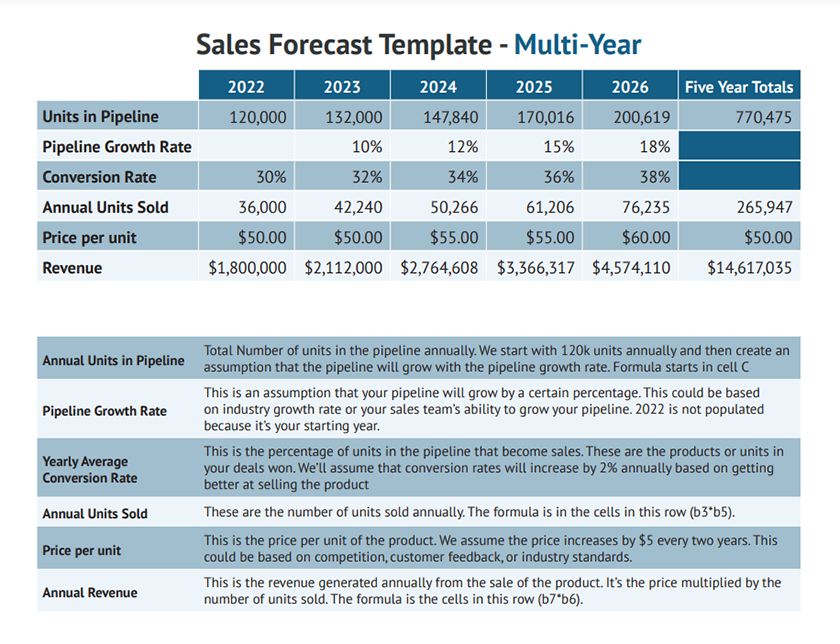
Five-year sales forecast template example (Source: Fit Small Business )
Sales goal tracking in Freshsales (Source: Freshsales )
Sales goals must reflect new business revenue and sales from existing or recurring customers. Then, you must add specific sales objectives that identify and prioritize the sales activities your team needs to complete to meet sales goals. This creates an objective way to measure success in hitting goals at all levels: organizational, sales department, team, and individual sales rep, which is an essential part of sales management .
For example, imagine your total revenue goal is $200,000 in year two and $300,000 in year three. You then add an objective, such as stating you want your business’ revenue from existing customers to grow 15% in year three. This can be measured by evaluating your percentage of revenue from existing customers in year three compared to year two.
3. Determine Your Ideal Customer
Determining the ideal customer or target market is the next step of your business plan for sales reps. It may have been accomplished when you developed your mission statement, but also when you set your sales goals and discovered how broad your market needs to be to reach them. Describing your ideal customer helps dictate who you’re selling to and your selling approach.
One way to establish your ideal customer is by creating a series of unique customer profiles . Each profile specifies key demographics, behaviors, interests, job positions, and geographic information about one of your ideal buyer types. Based on your customer profiles, you can then develop more targeted marketing strategies for lead generation and nurturing to move leads through the sales process more efficiently and close more deals.
Pro tip: Making a customer persona can be challenging, especially if it is based on the wrong data or if you just focus on the demographics. Check out our article on creating a customer persona to help you define your company’s ideal buyer types and guide your lead generation and marketing activities.
4. Set Your Sales Budget
After establishing your objectives and identifying your ideal customer personas—and before developing your actual strategies and tactics—you must identify a sales budget to work with. It should include estimated expenses for salaries, travel expenses, and the cost of any software tools or service providers used to help with sales and marketing. While these are meant to be estimates, research and due diligence should be done to avoid financial errors.
One way to set your sales budget, particularly for software tools and services you may be interested in, is to create and issue a request for proposal (RFP). Issuing an RFP allows you to post a summary of your needs to solicit proposals on potential solutions. In addition to providing accurate budget estimates from various qualified vendors and contractors, it may also help you discover cost-effective or high-performing options you were previously unaware of.
5. Develop Sales Strategies & Tactics
A sales strategy explains how you plan to outsell your competitors and accomplish your sales goals. It defines specific, detailed tactics your team will use to pursue your sales goals. These may involve using Google Ads, cold calling, and drip email marketing campaigns as part of a lead generation strategy. Available strategies differ depending on your company’s resources, skill sets, sales operation, and product or service offerings.
Strategies and tactics should be personalized for your ideal customers based on their unique interests, behaviors, and the best ways to connect with them. For example, some customer profiles show your ideal buyer generally only makes purchases based on trusted referrals. In this case, you could implement a referral strategy that provides incentives to generate more customer referrals .
Plus, different sales strategies will be needed to acquire new business vs keeping existing customers. When selling to existing customers, for example, your strategy could include cross-selling tactics where additional products are recommended based on prior purchases. The short-term cross-selling tactics could require customer service reps to send 30 emails per week recommending a complementary product to existing customers.
For a new business strategy, sales reps might rely on emotional selling methods when using cold calling as a tactic. Instead of product features, cold calling scripts would be geared to evoke feelings that lead to buying decisions. Tactics could reflect the objective of having reps make 15 cold calls each week. They could use a script that opens with a story about how a purchase made a customer feel or how someone felt because they didn’t purchase the product.
Pro tip: Ensuring your strategies are properly executed requires excellent sales leadership and a healthy environment for sales reps to operate in. Our how-to guide for building a positive sales culture shows you how to create an environment that promotes high job satisfaction, low employee turnover, and profitability.
6. Implement Sales Tools
Your sales strategy template should reference the software, hardware, and materials you use to manage the sales operation and make each team member more efficient. One of the most notable tools to include is the customer relationship management (CRM) system . It allows your team to organize contact information, streamline sales tasks, and facilitate communication with customers and leads.
HubSpot CRM , for instance, makes it easy to organize information about leads, contacts, and deal opportunities. Additionally, from a HubSpot CRM lead profile, you can initiate a conversation with that contact by calling, emailing, or scheduling an appointment.
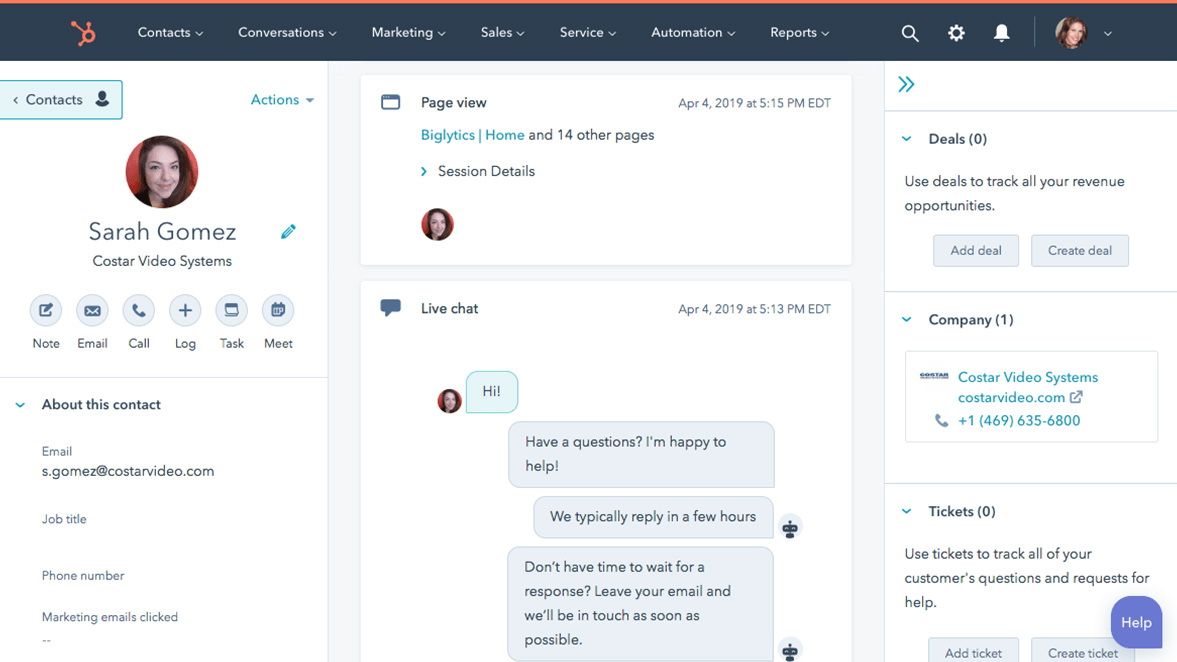
HubSpot CRM contact profile (Source: HubSpot )
CRMs are also used to monitor and report sales progress. For example, many have dashboards and functionality, such as alerts, which make it easy to identify where your team may be underperforming. These could also tell you which leads are most likely to convert and should be focused on. Sales information such as deals closed, revenue generated, and leads created can be presented in a detailed report .
These types of insights can also be shown on the CRM’s system dashboard . Pipedrive is an example of a CRM that has a customizable dashboard that displays both activity information and performance-based data. Activity data include emails sent, received, and outstanding tasks to be completed. Performance-based data, on the other hand, have deals lost or the average value of won deals.
Pipedrive’s customizable dashboard (Source: Pipedrive )
Other sales enablement tools can make your sales team more effective. These include voice-over-internet-protocol (VoIP) phone systems , lead generation platforms, email campaign tools, content creation platforms, and task automation software. These tools can be found within CRM software or through CRM integrations and standalone applications.
In addition to technology tools, sales and marketing templates should be used to streamline outreach initiatives. Scenario-based, premade sales email templates , for instance, allow salespeople to have an email already crafted for their specific situation.
Creating and storing business proposal templates in your CRM also streamlines the contact procurement and business proposal generation process . This way, whenever a prospect says they’d like to receive a quote or you’re responding to a request for a proposal, you already have a customizable template ready to go.
Pro tip: Effective cold calling scripts sales reps can use as a guide when placing calls to new leads is a tremendous sales tool to include in your action plan for sales. Get started using our guide for writing a cold calling script , which includes examples and free templates.
7. Develop Your Sales Funnel
Setting up a sales funnel within your sales strategy template lets you visualize the stages of the customer journey, from becoming aware of your business to buying from it. By creating and understanding the different statuses of your leads, you can track progress and determine how effective you are at converting leads to the next stages in the funnel.
Using a sales funnel with conversion rates also makes it easier for you to adjust your sales strategies and tactics based on how effectively you’re getting leads through the funnel. For instance, let’s say you have 100 leads in the awareness stage of the funnel. You decide to cold call 50 of them and write a sales email to the other 50 to qualify leads by setting up a product demonstration.
After each campaign, you find you were able to qualify seven of the leads that were cold-called and only two of the leads you had emailed. Based on these funnel conversion rates of 14% (7/50) from cold calling and 4% (2/50) from emailing, you would likely adjust your tactics to focus more on calling instead of emailing.
Do you need help creating a sales funnel for your business? Our guide to creating a sales funnel explains the step-by-step sales funnel creation process and provides free templates and specific examples.
8. Create Your Sales Pipeline
Once your sales process’ sales funnel stages are identified, develop the sales pipeline stages . These stages include your team’s sales activities to move leads through the funnel. For example, you need to get a lead from the sales funnel stage of brand awareness to show interest in learning more about one of your services. To do this, you could add a sales pipeline activity like setting up a demo or presentation appointment through a cold call.
Adding your sales pipeline to your sales strategy is essential because it describes all the activities your sales reps need to do to close a sales deal. CRM systems like Freshsales allow you to create and track the pipeline stages for each lead or deal within the lead record.
Funnel view of Freshsales’ deal pipeline (Source: Freshsales )
Listing each pipeline stage also helps you identify tools and resources needed to perform the activities for each stage. For example, if you use phone calls to initiate contact with or introduce a product to a lead, you could develop outbound sales call scripts for your team.
After the initial contact by phone, you may use email to follow up after a call and then nurture leads throughout the sales process. As part of your follow-up, create and automate a sales follow-up email template to get them to the next pipeline stage.
The sales funnel shows where a lead is in the sales process. The sales pipeline, on the other hand, lists activities needed to drive leads to the next stage in the sales funnel. Both should be used in your sales strategy when defining the repeatable steps required to generate leads and close deals. Check out our article to learn how to create a winning sales process with insights on both creating a sales process and measuring its success.
9. Assign Roles & Responsibilities
Regardless of the size of your business or sales operation, your business plan for sales reps should include the role and responsibility of each person in the sales team. Each role should have a name, such as someone being a sales development representative (SDR). There should also be a summary of their responsibilities, such as “the SDR is responsible for setting up sales appointments using the activities listed in the sales pipeline.”
Measuring the performance of any sales position is simple through key performance indicators (KPIs). Specific KPIs should be used to measure performance for each role and should be included in your plan. Below are some examples of KPIs that can be used by the members of the sales team and their respective responsibility:
- Sales development representative: Responsible for introducing products and services, qualifying leads, and setting up appointments for the account executive. Performance is measured by calls placed, emails sent, and appointments generated.
- Account executive: Responsible for nurturing qualified leads, delivering the sales pitch , sending quotes, and closing deals. Performance is measured by business proposals sent, the average time in the proposal consideration stage, deals closed, and deal closing rate.
- Customer service representative: Responsible for managing customer needs, handling billing, and managing service tickets by assisting customers. Performance is measured by customer satisfaction, retention rates, and total tickets resolved.
- Sales manager: Responsible for the entire sales operation or team for a specific region or product/service line. Performance is measured by job satisfaction rates of sales reps, pipeline and funnel conversion rates, team sales deals closed, and team revenue growth.
While assigning roles in your plan, a sales rep’s territory could be based on geography, industry, potential deal size, or product/service line, creating more specialization for better results. Our six-step process on proper sales territory management is an excellent resource for segmenting, creating, and assigning sales territories.
This section of the business plan is also a prime spot for individually setting sales quotas for each rep or team needed to hit your organizational sales goals. Sales quotas should be a specific KPI for that sales role and be set based on the experience, skill level, and resources of that individual or team. These quotas should also be based on your organizational, department, and team goals and objectives.
10. Monitor Progress & Adjust Accordingly
Once the strategic business plan is in motion, monitor its progress to make any required adjustments. For instance, while your sales operation is running, you may find certain sales tactics are working better than expected, and vice versa. Your sales goal template should account for using that tactic more, as well as any new sales tools, budgetary changes, new roles, and possibly even a new sales goal.
As in the earlier example, if you found that cold calling was significantly more effective than emailing, reduce or abandon the email method in favor of cold calling. You could also invest in sales tools especially useful for cold calling, such as power dialing using a voice-over-internet-protocol (VoIP) phone system, or hire additional staff to place calls. All of these will be part of your updated business plan.
Pro tip: Focusing on the big picture by creating, executing, and adjusting a strategic business plan is one of the most critical traits of an effective sales leader. For more insights on what it means to be a sales leader and how to become one, check out our ultimate guide to sales leadership .
Examples of Other Free Small Business Sales Plan Templates
Apart from our free downloadable sales strategy template, other providers have shared their version of a free strategic sales plan examples. Click on our picks below to see if these templates fit your business process better:
HubSpot’s free sales planning template helps users outline their company’s sales strategy. It contains sections found in most sales plans, as well as prompts for you to fill out your company’s tactics and information. These include company history and mission, team structure, target market, tools and software used, positioning, market strategy, action plan, goals, and budget.

HubSpot sales strategy template (Source: HubSpot )
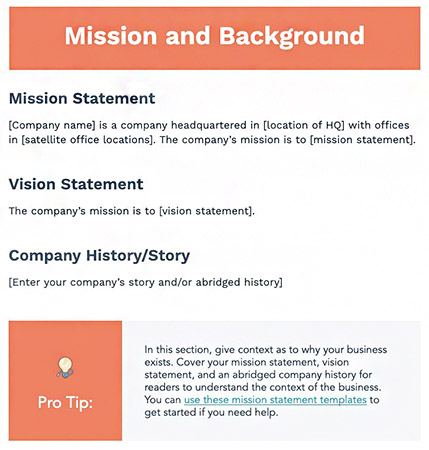
HubSpot’s sales goals template with the mission, vision, and story of the company (Source: HubSpot )
Visit HubSpot
Asana’s free sales plan template helps organizations analyze their current sales process, establish their sales objectives, identify success metrics, and plan actionable steps. The sales business plan template is embedded within Asana’s platform, automatically integrating aspects such as goals and measuring them against results or sales performance.
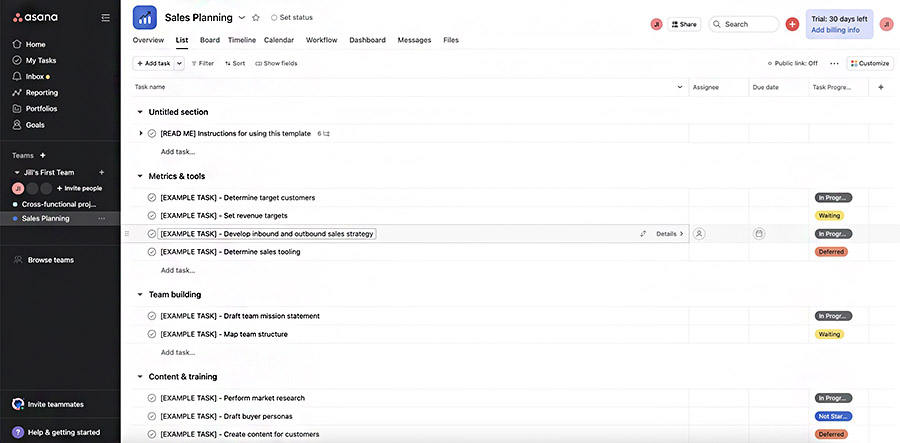
Asana sales plan example (Source: Asana )
Visit Asana
Sales Planning Frequently Asked Questions (FAQs)
What is sales planning.
Sales planning is creating a document that outlines your sales strategy, objectives, target audience, potential obstacles, and tools to achieve goals within a specified period. This may include your daily, monthly, quarterly, yearly, and long-term revenue objectives.
What is included in a sales plan?
A sales strategy plan template typically includes the following key elements:
- Target customers, accounts, or verticals
- Stock-keeping units (SKUs)
- Revenue targets or forecasts
- Strategies and tactics
- Pricing and promotions
- Deadlines and directly responsible individuals (DRIs)
- Team structure and coordination
- Market conditions
What are the different types of strategic sales planning?
The type of strategic planning for sales that you choose for your team ultimately depends on different factors. These include your revenue goals, available resources, the ability and bandwidth of your sales team, and your personal commitment to your plans. Once you have determined the details of these factors, you can choose from these types of strategic sales planning:
- Revenue-based sales action plan template: This is ideal for teams aiming for a specific revenue goal. It focuses on in-depth sales forecasting, improvement of conversion rates, and closing more deals.
- Sales business plan based on the target market: This plan is best for businesses that cater to several markets that are different from each other. In this situation, you must create separate sales goal templates for enterprise companies and small businesses.
- Sales goals plan: This focuses on other goals such as hiring, onboarding, sales training plans, or sales activity implementation.
- New product sales business plan: This plan is developed for the launch and continued promotion of a new product.
Bottom Line
While any business can set bold sales goals, creating a sales plan outlines how your team will achieve them. By following the best practices and 10-step process laid out above, your sales goal template defines what your sales process will look like. It will help establish baselines for accountability and identify optimal strategies, tactics, and the tools needed to make your team as efficient as possible.
About the Author

Jillian Ilao
Jill is a sales and customer service expert at Fit Small Business. Prior to joining the company, she has worked and produced marketing content for various small businesses and entrepreneurs from different markets, including Australia, the United Kingdom, the United States, and Singapore. She has extensive writing experience and has covered topics on business, lifestyle, finance, education, and technology.
Join Fit Small Business
Sign up to receive more well-researched small business articles and topics in your inbox, personalized for you. Select the newsletters you’re interested in below.
How to Create a Sales Plan: Tips, Examples & Free Sales Plan Template
Tactics and strategies are great. But when you create a sales plan, you set a clear path to success, with each step mapped out ahead of you.
The Internet is full of people who will tell you all about the success they’ve found from their strategies, whether it's personalizing a newsletter subject line or changing the color of the 'Buy Now' button.
But, news flash—these tips and tricks aren’t actual sales strategies .
To create real, lasting growth for you and your company, you need to create your own grand strategy. And that starts with a solid sales plan .
So, what’s your plan? How do you build it (and stick to it)?
We’re about to take a deep dive into sales plans. By the end of this guide, you’ll be completely equipped to win the fight for business growth. And we can't recommend it enough—grab our free sales plan template here in the Sales Success Kit today:
GET THE SALES SUCCESS KIT →
What is a Sales Plan? (And What Makes for Successful Sales Planning?)
Armed with the information you'll compile within your sales plan, you can quickly identify any upcoming problems, sales droughts, or opportunities—and then do something about them.
If done correctly, the right sales plan template empowers you to spend even more time growing and developing your business, rather than responding reactively to the day-to-day developments in sales.
Sound exciting? Let’s jump right in.
Download Your Free Sales Plan Templates Today
Want to build your own sales plan template that'll clarify your business plan and accelerate your growth? Grab the Sales Success Kit , including...
...and more to help you set up strategic sales planning and quotas for your team.
Want to stand out in the competitive market? Explore the insights of challenger selling .
What’s in a Sales Plan? 6 Elements Every Sales Plan Needs
In basic terms, a sales plan template includes:
- Sales forecasting and goal-setting
- Market and customer research
- Prospecting and partnerships
Each part of the sales plan naturally works itself into the next, starting with your high-level goals, then considering market factors, and finally looking at who you know, and how to find more prospects to help hit your sales goals .
Here are the key elements to include in your plan:
1. Mission Statement
What gets your sales reps out of bed in the morning? What’s the clear mission that pushes your team to keep fighting for that win?
Your mission statement is a concise statement of the ‘big picture’—the main idea and goal you want to achieve. Think about your company mission and how the sales team forms part of that overarching goal.
2. Sales Goals and Revenue Targets
A sales plan must include achievable sales goals and the targets your sales reps will be working to reach. Use previous years' results to tell you what's reasonably possible for your team to do. Include specific metrics and KPIs , how these are performing currently, and what you plan to do to improve them.
This may also include information about your product’s pricing , planned discounts, and how your team can focus on the right customers to get the most revenue possible. Link these sales goals to the business goals your company is working to achieve.
3. Analysis of the Target Market
Your plan should clearly identify your ideal customer profile and information about the target market and demographic you plan to sell to. Are you breaking into a new market? Are you targeting small business or enterprise customers ? Give a concise description of your target audience and the stakeholders you’ll need to sell to.
4. Sales Strategy Overview and Methods to Reach Target Customers
This should include a brief overview of the customer journey , pain points , and how your salespeople will engage and follow up with new prospects throughout their journey to purchase. You'll likely outline specific sales activities you'll focus on, such as improving referral numbers, testing new cold-calling email strategies, or dipping your toe in social selling.
You may also include information about the marketing strategy and lead generation methods used to gather new leads and how sales managers will support the team.
5. Use of Resources and Sales Tools
How much does it cost your team to close a new deal? What is your budget for the sales team, or for sales tools ?
Inside your plan, list the resources you have available to you, and how you plan to use them during the year. This includes monetary resources, as well as human resources.
Next, show how your resources will be used. For example, how much will you spend on sales tools? Which CRM software is your team depending on? Briefly explain how you plan to use each tool and why you’ve allocated resources in that way.
6. Sales Team Structure
The structure of your sales team includes which reps are available during what times of the year, their specialties and skills, and where they focus in the sales process .

Also, include information about the sales managers, their teams, and the incentives you offer your reps.
The Benefits of Sales Planning: Why You Need a Sales Plan
Creating a sales plan from scratch can be daunting, even with the right sales planning template. So, why should you have your sales strategy written down and ready to act on?
Let’s talk about the benefits of sales planning to attract new business and grow your market share.
Clear, Time-Bound Goals Help You Reach Revenue Targets
There’s a reason they say, “A goal without a plan is just a wish.”
If you want your sales team to execute on and accomplish your sales goals, you need to have a plan in place. When targets are linked to specific timeframes and actions, your whole team will see how their individual work is involved in reaching your sales goals.
Prioritize Time and Resources
Without a specific action plan in place , your team won’t be able to prioritize their time with the right sales tactics and strategies to hit their targets.
With a clear outline of the tactics that bring the most significant ROI for your team, each rep can get the best results for the time they spend selling.
Clear Action Plan to Reach Your Goals
With an action plan in place, each team member knows what they’re supposed to be doing, and why they’re doing it. This keeps them motivated and helps them see how their individual efforts make a difference.
4 Types of Sales Plans (How to Choose Which Planning Style is Right for Your Sales Team)
It’s difficult to templatize a good sales plan since every plan is unique to the business and team it applies to. So, what are some examples of the types of sales plans you might create, and how can you choose between them?
- Revenue-based sales plan: If you’re aiming for a specific revenue goal, this type of sales plan will be focused on in-depth sales forecasting and specific actions to improve conversion rates and close more deals.
- Sales plan based on the target market: If you’re selling to vastly different markets, you may want to create a different sales plan based on the market you’re targeting. For example, your sales plan for enterprise companies would differ from your sales plan for selling to SMBs.
- Sales goals plan: A plan that’s focused on goals (other than revenue) may include hiring and onboarding, sales training plans, or plans to implement a new type of sales activity into your process.
- New product sales plan: When launching a new product, it’s a good idea to develop a specific business plan around its launch and continued promotion. This plan may include finding and contacting strategic partners, building a unique value prop in the market, and creating new sales enablement content for the team to use when selling this product. This type of sales plan can also apply to launching new features in your SaaS product.

How to Choose the Right Sales Planning Style
Ultimately, this will depend on factors such as:
- Your revenue goals
- The resources at your disposal
- Your sales team’s abilities and bandwidth
- Your personal commitment to seeing this plan through
When you’ve determined who is involved in sales planning, how committed they are, and the resources you can use to make this plan happen, you can start building your own sales plan.
9 Steps to Create a Sales Plan to 10x Your Sales Team’s Results
It may seem like a lot of work to develop a sales plan at this point. But once you do, you’ll be in a place to take your sales (and brand) to the next level.
Let’s break down this process, step-by-step, so you can start achieving greater results.
1. Define Your Sales Goals and Milestones
With a sales plan, we begin at the end: an end goal.
Start by choosing the sales metrics that matter most to your overall business. This could be:
- Annual or monthly recurring revenue (ARR or MRR)
- Retention or churn rates
- Average conversion time
- Average conversion rate
- Customer lifetime value (CLV)
It doesn’t matter so much which metric you choose —the important point is that it can tell you whether your work has succeeded.
Next, look at last year’s forecast and results . Were you being realistic? How did sales revenue increase annually? How does that compare your company to the industry standards? Use this information to determine what realistically you can bring in based on the size of the market, your company goals, and the experience and resources available to your sales team .
After setting clear sales goals, it’s time to set milestones . This involves breaking that big number down into smaller expectations with strict deadlines. These should challenge and motivate your sales team , without being so difficult they kill morale.

Lean on your sales team during this process. After all, they’re in the trenches with you and probably have the best knowledge about your customers. Learn about what they do during the workweek to close deals. Ask how much they’re currently doing, and how much bandwidth they have to do more. This will give you a real, frontline take on what goals and milestones to set in your sales plan template.
Finally, create specific targets with clear deadlines . For example, to achieve a sales goal of increasing revenue by 15% YOY, you might set the milestone of increasing your customer base by 20%, or increasing sales by 50% for a specific product.
Brought together, these milestones inform and support your overall sales plan, giving you a clear, actionable workflow to hit your overall goals for the year.
2. Clearly Define Your Target Market or Niche
You need to know the market you’re in and the niche you’re going to occupy so you can properly position your business for growth.
What’s a business niche? It’s more than just what your business specializes in—a niche is the space your business occupies, with your products, content, company culture, branding, and message. It’s how people identify with you and search you out over the competition.
As serial entrepreneur Jason Zook explains: “ When you try to create something for everyone, you end up creating something for no one. ”
Don’t do that.
Instead, start by looking at a niche and asking yourself these questions:
- How big is the market?
- Is there a built-in demand for what you're selling?
- What’s your current market position?
- Who are your competitors? What are their strengths, weakness, opportunities, and threats?
If you’re stuck, start by going back to your own strengths . List out your strongest interests and passions. Pick a field where the odds are already in your favor—where you have a proven track record, more expertise to offer, an extensive contact base, and people who can provide you with intros.
These kinds of strategic advantages will help you clarify your buyer persona and amplify the results of your planning.
Start with one product in one niche—you can always branch out to a complementary niche later. Sell beautiful, handcrafted tea cups? How about a booming doily business? Or customizable teaspoons?
A niche doesn’t limit you. It focuses you.
3. Understand Your Target Customers
Chasing the wrong customers will only waste your time and money, so don't allow them to sneak into your sales plan.
Your best customers are the ones that are successful with your product and see the ROI of it. Talk to them, and find out what they have in common.
While defining ideal customers depends on your company and market, here are some basic characteristics you’ll want to identify:
- Company size (number of employees, number of customers, yearly revenue)
- Size of the relevant department
- Geographical information
- Job title of your POC
- Buying process
- The goal they’re trying to achieve with your product or service
Also, don’t forget to think about whether they will be a good ‘fit’. If this is a long-term relationship you’re developing rather than a one-night stand, you want to ensure you speak the same language and share a similar culture and vision.
Use this information to build out an ideal customer profile . This fictitious organization gets significant value from using your product/service and provides significant value to your company. A customer profile helps you qualify leads and disqualify bad-fit customers before you waste time trying to sell to them.

Once you know the type of company you want to target with your sales team, it’s time to get inside their head. Start by hanging out where they hang out:
- Are they on social media? What’s their network of choice?
- Are they members of any Facebook or LinkedIn groups?
- Can you answer industry questions for them on Quora or Reddit?
- What podcasts do they listen to or what resources do they read?
Get in your customers’ heads and you’ll be in a much better position to sell to them.
GET THE IDEAL CUSTOMER PROFILE KIT →
4. Map Out Your Customer’s Journey
The next part of an effective sales plan must address how that ideal customer becomes your customer. Do this by mapping out their journey, including actions and events during the different stages of the sales funnel :
- Consideration
Conduct a customer survey , or chat directly with your current, happy customers to gather valuable sales planning insights. Ask them:
- When you became a customer, what did you want our product to do for you?
- What features were important to you? Why?
- What was your budget?
- How were you solving this problem before using our product?
To fully understand their journey as a customer, you can also ask about past buying experiences:
- When was the last time you bought something similar?
- Was that a good or bad experience? Why?
- What was the decision-making process like?
- How did you evaluate different offers?
- Which factors made you choose that particular solution?
Once you’ve identified the awareness, interest, and consideration stages, let your prospects and new customers build the rest of their roadmap by asking them: ‘what’s next?’
"What needs to happen to make you a customer?"
If, for example, they say they’ll have to get approval from the VP of Finance. Ask:
"Ok, and let's say he agrees that we're the right fit, what's next?"
We call this the virtual close , a way to put your prospect in a future-thinking state of mind that makes them imagine buying from you. Asking this question to several high-quality prospects will tell you those final few steps in the customer journey until they’ve signed on the dotted line.
Finally, piece together the post-sale journey. Once a prospect becomes a customer, what’s next? How do you enable them to use your product and be successful with it? What happened to create your most loyal customers? Understanding this piece of the sales process is essential to managing and increasing customer retention .
5. Define Your Value Propositions
You know your customers. You know their journey. Now, define where you fit in by looking at your competitive advantage . Fully articulating what sets you apart from the competition is a crucial element of your sales plan template.
Start by asking a few simple questions:
- Why do customers buy from us?
- Why do customers buy from our competitors and not us?
- Why do some potential customers not buy at all?
- What do we need to do to be successful in the future?
Remember that customers buy benefits, not features. When describing your value proposition , it’s easy to get caught up in talking about you. What you’ve made. What you do. Instead, flip the script and talk about what your product will do for your customers . A strong competitive advantage:
- Reflects the competitive strength of your business
- Is preferably, but not necessarily, unique
- Is clear and simple
- May change over time as competitors try to steal your idea
- Must be supported by ongoing market research
For example, the competitive advantage of help desk software has nothing to do with its social media integrations and real-time ticket tracking. It’s the fact that it allows its customers to focus on creating a great customer experience.
Here’s the point: Focus on value, not features in your sales plan template.

Your competitive advantage will inform everything your company does moving forward, from marketing to product development. It’s a great example of where sales can influence the development of a product and the direction of a business.
6. Organize Your Sales Team
The way your sales team is organized can enable them to better serve their customers and bring new revenue into your business faster.
Here are three basic structures for your sales team :
- The island: Individual reps work alone.
- Assembly line: Each sales rep is assigned a specialized role such as lead generation, SDR (qualifier), Account Executive (closer), or Customer Success (farmer).
- Pods: Each sales rep is assigned a specialized role in a pod, or group, that’s responsible for the entire journey of specific customers.
Think about the strengths and weaknesses of your sales team members, and how they will truly thrive as part of the team.
7. Outline the Use of Sales Tools
Now it’s time to think about the tools you’re using. Building out your sales stack takes time and effort, but listing out that stack in your sales plan will help you avoid getting caught up with new tech that may or may not help your sales team.
Basically, you’ll need tools for these areas to cover all aspects of the sales process:
- CRM software (like Close )
- Lead generation and prospecting tools
- Internal communication software
- Engagement and outreach tools
- Documentation software
- Sales enablement stack
Think about how all of your sales tools work together through integrations and where automation comes into play to save your team time, and how you'll drive CRM adoption across your team members.
8. Build a Prospecting List
A prospect list is where we take all the theory and research of the last few sections of our sales plan template and put them into action.
At its core, a prospect list is a directory of real people you can contact who would benefit from your product or service. This can be time-consuming, but it's essential for driving your sales plan and company growth.
First, use your ideal customer profile to start finding target companies:
- Search LinkedIn
- Check out relevant local business networks
- Attend networking events and meetups
- Do simple Google searches
- Check out the member list of relevant online groups
Target up to 5 people at each organization. Targeting more than one individual will give you better odds of connecting by cold email outreach as well as a better chance that someone in your network can connect you personally.
Remember, this isn’t just a massive list of people you could sell to. This is a targeted list based on the research you’ve done previously in your sales plan.
Once you have your list, keep track of your leads and how you found them using a sales CRM. This will keep historical context intact and make sure you don’t overlap on outreach if you’re working with teammates.
9. Track, Measure, and Adjust As Needed
Just because you’ve made a solid sales plan template to follow, doesn’t mean you get to sit back and watch the cash roll in.
Remember what Basecamp founder Jason Fried said about plans:
“A plan is simply a guess you wrote down.”
You’re using everything you know about the market, your unique value, target customers, and partners to define the ideal situation for your company. But yes, try as we might, very few of us actually see anything when we gaze deep into the crystal ball.
Instead, remember that your sales plan is a living, breathing document that needs to account for and adapt to new features, marketing campaigns, or even new team members who join.
Set regular meetings (at least monthly) to review progress on your sales plan, identify and solve issues, and align your activities across teams to optimize your plan around real-world events and feedback. Learn from your mistakes and victories, and evolve your sales plan as needed.

Create a Strategic Sales Plan to Grow Your Business
You’ve just discovered the basics—but I’ll bet you’re ready to go beyond that. Here are some final ideas to take your sales plan from a simple foundation to a strategic, actionable one.
Avoid Moving the Goalpost
Avoid making adjustments to the goals outlined in your sales plan—even if you discover you’ve been overly optimistic or pessimistic in your sales planning. When you're developing your very first sales plan template, it's natural to be wrong in some of your assumptions—especially around goals and forecasting .
Instead of letting it get you down, remember your plan serves as a benchmark to judge your success or failure. As you see places where your assumptions were wrong, carefully document what needs updating when it's time to revise your sales plan.
Invite Your Others to Challenge Your Sales Plan
Never finalize a plan without another set of eyes (or a few sets.) Get an experienced colleague—an accountant, senior salesperson, or qualified friend—to review the document before solidifying your sales plan.
Your sales team is another strong resource for reviewing your sales plan. Ask their opinions, give them time to think about how it relates to their daily work, and agree on the key points that go into your sales plan.
Set Individual Goals and Milestones for Your Sales Team
We talked about creating milestones for your business, but you can take your sales plan to the next level by setting individual milestones for your sales team as well.

These individual goals need to consider the differences in strengths, weaknesses, and skills among your salespeople.
For example, if someone on your team is making a ton of calls but not closing, give them a milestone of upping their close rate . If someone’s great at closing but doesn’t do much outreach, give them a milestone of contacting 10 new prospects a month.
Doing this will help your individual reps build their skills and contribute to their company and career growth.
Ready to Hit Your Sales Goals?
In most sales situations, the biggest challenge is inertia. But with a solid, detailed sales plan and a dedicated team with clear milestones, you’ll have everything you need to push through any friction and keep on track to hit your goals!
All jazzed up and ready to put together your own sales plan? Download our free Sales Success Kit and access 11 templates, checklists, worksheets, and guides.
They're action-focused and easy to use, so you can have your best sales year yet.
Actionable sales advice
Get actionable sales advice read by over 200,000 sales professionals every week.

Our Recommendations
- Best Small Business Loans for 2024
- Businessloans.com Review
- Biz2Credit Review
- SBG Funding Review
- Rapid Finance Review
- 26 Great Business Ideas for Entrepreneurs
- Startup Costs: How Much Cash Will You Need?
- How to Get a Bank Loan for Your Small Business
- Articles of Incorporation: What New Business Owners Should Know
- How to Choose the Best Legal Structure for Your Business
Small Business Resources
- Business Ideas
Business Plans
- Startup Basics
- Startup Funding
- Franchising
- Success Stories
- Entrepreneurs
- The Best Credit Card Processors of 2024
- Clover Credit Card Processing Review
- Merchant One Review
- Stax Review
- How to Conduct a Market Analysis for Your Business
- Local Marketing Strategies for Success
- Tips for Hiring a Marketing Company
- Benefits of CRM Systems
- 10 Employee Recruitment Strategies for Success
- Sales & Marketing
- Social Media
- Best Business Phone Systems of 2024
- The Best PEOs of 2024
- RingCentral Review
- Nextiva Review
- Ooma Review
- Guide to Developing a Training Program for New Employees
- How Does 401(k) Matching Work for Employers?
- Why You Need to Create a Fantastic Workplace Culture
- 16 Cool Job Perks That Keep Employees Happy
- 7 Project Management Styles
- Women in Business
- Personal Growth
- Best Accounting Software and Invoice Generators of 2024
- Best Payroll Services for 2024
- Best POS Systems for 2024
- Best CRM Software of 2024
- Best Call Centers and Answering Services for Busineses for 2024
- Salesforce vs. HubSpot: Which CRM Is Right for Your Business?
- Rippling vs Gusto: An In-Depth Comparison
- RingCentral vs. Ooma Comparison
- Choosing a Business Phone System: A Buyer’s Guide
- Equipment Leasing: A Guide for Business Owners
- HR Solutions
- Financial Solutions
- Marketing Solutions
- Security Solutions
- Retail Solutions
- SMB Solutions

Online only.

How to Write a Sales Plan

Table of Contents
Every business needs a business plan as well as more detailed road maps that offer guidance to each department working toward that common goal. As the revenue-generating engine of your company, the sales department should be a top priority for this type of document, aptly named the “sales plan.” This guide introduces the concept of a sales plan and gives you all the guidance you need to create a sales plan that works for your business.
A sales plan details the overall sales strategy of a business, including the revenue objectives of the company and how the sales department will meet those goals. This may also include revenue goals, the target audience and tools the team will use in their day-to-day. In addition, the sales plan should include examples of the hurdles and pain points the team might encounter, as well as contingency plans to overcome them.
“[A sales plan] is essential to support the growth of an organization,” said Bill Santos, vice president of the ITsavvy Advanced Solutions Group. “A sales plan helps individual reps understand the priorities of the business as well as the measurements by which they will be evaluated.”
Business plans vs. sales plans
Business plans and sales plans are closely linked. A sales plan, though, should outline the actions that the sales department will take to achieve the company’s broader goals. A sales plan differs from a business plan, though both work toward the same end.
“A business plan is a ‘what’ [and] a sales plan is a ‘how,'” said James R. Bailey , professor of management and Hochberg Professional Fellow of Leadership Development at the George Washington University School of Business. “Business plans are where a firm wants to go. A sales plan is a part of how they can achieve that. A business plan is direction; a sales plan is execution.”
For example, a software company that developed a new mobile application might state in its business plan that the app will be installed by 1 million users within a year of launch, while the sales plan describes how that will actually be achieved.
How to write a sales plan
Every sales plan should suit the individual needs of a different company, so they come in all shapes and sizes. There is no one-size-fits-all sales plan; the one you create will be unique to your business. With careful planning, you’ll have a much clearer vision of what you need to accomplish and a road map for how to get there.
Chris Gibbs, vice president of global sales at Centripetal Networks, named some additional items that every sales plan should include.
- Targeted accounts: Assign each salesperson a few key accounts to focus on, and grow from that base.
- Targeted verticals: Sales teams might focus on specific market segments or verticals, such as a particular industry.
- SKUs: Salespeople should emphasize certain SKUs or inventory items rather than get lost in a broad catalog of merchandise to sell.
- Sales and marketing coordination: Sales and marketing teams should work together to create promotions to help generate sales.
- Product road maps: Every company has a road map, and each product should have a road map that shows the plan and direction for a product offering over time to chart out when a product will launch and when it might sunset or be replaced by a newer model.
- Forecasts: Sales forecasting is projecting sales volumes and expectations by comparing them historically to sales of previous years, and then conducting market comparison to determine where sales will fall against the competition.
“Sales plans are extremely important to ensure there is cohesiveness between product teams, sales and marketing,” Gibbs said. “In addition, they’re important for ensuring that timing of new products and/or new version releases coincide with sales objectives and forecasts.”
What are the steps to create a sales plan?
A sales plan is necessary for businesses of every size, from an individual entrepreneur to a Fortune 500 company. When you’re ready to actually write your sales plan, follow these steps:
1. Define the objectives.
Clearly outlining your goals and stating your objectives should always be the first step in creating a sales plan or any other business venture. You should include the expected sales volume and any markets or territories you expect to reach.
For example, let’s say you own a retail store selling household goods and electronics. If your purpose is to establish yourself as a trusted local retailer, ask yourself the following questions:
- If so, are they purchasing anything or just browsing?
- Was it word of mouth?
- Was it through marketing efforts, such as email marketing, direct mail or social media?
- How many are new customers?
- How many are repeat customers?
- Where do you want your sales to come from?
- What are some external and internal factors that could impact your sales? These include industry trends and economic conditions.
When you can precisely state your key objectives, you are setting yourself up to plan later steps around achieving your goals.
2. Assess the current situation.
The next step is to create an honest overview of your business situation in relation to the goal you set in the first step.
Review your strengths and assets. Take a look at your resources and how you can apply them to your goal. This can include personal relationships and competitive advantages like new products or services.
For example, if your goal is to enhance your relationship with your customers, you’d need to ask yourself some questions to examine your current situation:
- What is your current relationship with your customers?
- Where did most of your sales come from?
- Where would you like to expand your sales?
When examining your strengths and opportunities, conduct a SWOT analysis to get a clearer picture of where your business stands.
3. Determine and outline the sales strategies.
Sales strategies are the actual tactics your team will use to reach customers. They can include marketing channels as well as procedures for lead generation and client outreach employed by your salespeople.
Here are two examples of potential sales strategies:
- Use your POS system to retain customer information so you can track current and new customers.
- Employ email marketing, text message marketing , social media, outbound call center services and direct mail marketing campaigns.
4. Define roles for the sales team.
Each member of the sales team should be assigned clear roles, whether they vary from person to person or everyone performs the same functions.
Defining the sales direction of the team is crucial, as it shows the focus of the company and helps the team target and execute sales most effectively.
The plan of attack for the sales team should be communicated clearly by leadership, whether it is from team leaders or the CEO.
5. Inform other departments of sales objectives.
A sales plan shouldn’t just update a company president or C-suite; it should inform the whole organization of the sales team’s objectives.
Clearly outline your plan for the rest of the company to help them understand the goals and procedures of the sales team. Other departments become more efficient when interacting with the sales team and clients. This also conveys a certain level of quality and professionalism to the clients about the company.
6. Provide tools for the sales team.
Provide the tools each member of the sales team needs to achieve the stated goals, such as customer relationship management (CRM) software. The best CRM software is customizable to meet a company’s needs, making it much easier for your team to use the software and work efficiently.
7. Detail how the department will track progress.
Offer strategic direction and insight on how progress will be monitored. Having a quarterly review to assess whether the company is on target is just as important as the plan itself.
Markets change, and so should your sales plan. Keeping it up to date will help you capitalize on the market and achieve your goals. Tracking progress is made easier by the tools you use to collect data. That data will then have to be analyzed and presented in a way which all departments can understand and use for future growth.
Key elements of a sales plan
Every sales plan should also include the following elements.
Realistic goals
You need to set achievable goals . Challenge your sales team, but don’t push too hard. Bailey said that these “deliverables” are among the key points to include in a sales business plan.
“Deliverables need to be as specific as possible and moderately difficult to achieve – specific inasmuch as being measurable in a manner that is uncontested [and] moderately difficult inasmuch as making sales goals too difficult can lead to failure and discouragement.”
Midpoint goals also help build morale and keep the team working toward a larger goal. Instead of having one giant goal, creating smaller goals to achieve along the way will keep your team focused.
Set milestones that give you the opportunity to regularly determine whether you are on track to achieve your sales goals or need to make adjustments.
Sales tools
Tracking sales throughout the term is helpful, and you can employ tools to keep track of each team member as well as the department overall. It also helps establish a culture of accountability among salespeople.
“Tools can help, especially project management and CRM software,” Santos said. “Having a weekly cadence of update and review is also important, as it sends a message that ownership and updates are important.”
Clear expectations and a defined commission structure
Assign goals and responsibilities to each team member to make expectations clear. This is true whether or not each team member has the same goals.
“We meet with each individual to come up with a plan that works for them so that they can reach their goals,” said Leah Adams, director of client success at Point3 Security. “We measure results based on numbers. Each team member has his own plan and how they’re going to get there.”
It’s also necessary to spell out the commission structure in full detail.
“The only real difference is how sales count,” Bailey said. “In petroleum-based products … a few big clients are necessary. Compensation needs to be structured not just in contract value, but in graduated terms: Above $1 million, commissions move from 5% to 9%, and so forth. In smaller-volume enterprises, commissions might be front-loaded with higher percentages early, then graduated down. You have to reward what you want.”
Training programs
Along the way, some training might be necessary to maintain the momentum.
“What’s important to us is that we’re teaching these individuals to be the best salesperson they can be,” Adams said. “We help them do that by constantly training them and giving them knowledge of what’s going on in our industry. Everything stays on track because each member of the team knows their individual goal; though each person has a number, they also know the ultimate goal is for the entire team to hit.”
Adams said that an effective CRM keeps things organized and helps delegate tasks and responsibilities on a schedule that uses the company’s lead information.
Key steps to follow when devising a sales plan
Here are some best practices for creating a sales plan:
- Refer to the business plan. The sales plan should directly address the objectives of the business plan and how those objectives can be achieved.
- Advance clear objectives. The clearer the objectives are, the easier it will be to reach your goals.
- Reference prior sales data. Chart sales over the previous few terms, and project the trend for the current term. New businesses can create sales projections based on expectations.
- Outline the commission structure. This will help motivate your team and help you calculate anticipated costs.
- Be clear about how progress is measured. There should be no dispute about this. If larger clients carry more weight than lower-volume buyers, that should be stated upfront.
The benefits of a sales plan
A sales plan keeps the sales department on track, considering the details of how they must operate to hit their targets and achieve company objectives. Because the sales team is the primary driver of revenue, it is an incredibly important document. [Related article: Adopting a CRM? How to Get Buy-in From Your Sales Department ]
“It’s extremely important to have a sales plan in place, almost a must,” Adams said. “Without this plan, it’s almost impossible to get through the year and hit the company’s sales goals.”
It’s not uncommon to encounter obstacles along the way, however. A good sales plan accounts for that.
“Almost always, you’ll run into the speed bumps along the way, but with a plan in place, it makes it a whole lot easier to navigate through it all,” Adams said. “The sales plan allows you to adjust when necessary so the goal can still be hit. I strongly believe a plan allows you to stay in control and reduce the risk while being able to measure the team’s results along the way to that finish line.”
A solid sales plan helps you deal with unexpected events and acts as a benchmark for where your company is and where you want it to go.
Sales plan templates
Sales templates are helpful in that many of them are based on tried-and-true formats that have been used by businesses across several industries. They can also provide structure so that it is clear to each employee what their role and responsibilities are.
Create your own sales plan by downloading our free template .
“A template helps plan each individual’s daily activities in a structured way,” Adams said. “If you know what each person is doing daily, it’s easier to help correct what’s going wrong. It helps with things like conversion rates, etc. Yes, these templates can be customized in any way a team’s manager sees fit, based on how he believes the team will perform better.”
Sales plans should be unique to the company; however, there are key components they should always include. Because there is somewhat of a formula, you can use a template.
Templates are extremely helpful, Gibbs said. “It creates uniformity for the team, as well as a yearly or quarterly sales plan to present to senior management.”
Gibbs added that templates can easily be customized to meet the needs of a particular business or sales team.
Keeping your team on track with a sales plan
Planning is vital for any business, especially when dealing with sales targets. Before selling your product or service, you must outline your goals and ways to execute them. Essentially, a sales plan enables you to mitigate problems and risks. When there is a clear plan of action, you will know how to proceed in order to attain your goals.
Enid Burns contributed to the writing and reporting in this article. Source interviews were conducted for a previous version of this article.

Building Better Businesses
Insights on business strategy and culture, right to your inbox. Part of the business.com network.
How To Build a Strategic Sales Plan + 10 Examples
- March 28, 2024
Every sales team has some sort of plan, even if it’s just “sell more of the product/service that you’re employed to sell.”
A sales plan is a portfolio that includes a layout of your processes, target audience, objectives and tactics. It’s used to guide your sales strategy and predict cost and returns.
Yet without a codified sales plan, it can be difficult to give a sales team the motivation and purpose they need to successfully engage customers and continue to generate revenue.
Not having a sales plan that’s written down and signed off on by stakeholders can lead to confusion around what sales reps should and shouldn’t be doing , which can be demotivating.
It might seem daunting or time-consuming to put together an entire sales plan, but it doesn’t need to be. Here’s how to create a thorough sales plan in 10 simple steps.
What Is a Sales Plan?
A successful sales plan defines your target customers, business objectives, tactics, obstacles and processes. An effective plan will also include resources and strategies that are used to achieve target goals. It works similarly to a business plan in the way it’s presented, but only focuses on your sales strategy.
A sales plan should include the following three components:
- Ideas: If you use specific business methodologies, you may choose to outline key principles and examples of them in action within your sales plan. An example could be conversation tactics when pitching your product to your target customer.
- Processes: In order to streamline productivity and business strategy, you’ll want to make sure your processes are defined within your sales plan. Your sales team should be able to refer to the sales plan when they’re in need of direction.
- Tools and tactics: The most effective sales plans include not only high-level business strategies, but also step-by-step approaches for your sales team to utilize. These tools can include key conversation pieces for your sales reps to use when pitching a product or content to close out a deal.
Solidifying a sales plan is crucial for a strong business model. Taking the time to narrow in on the components above will set you and your business up for success down the road.
Sales Planning Process
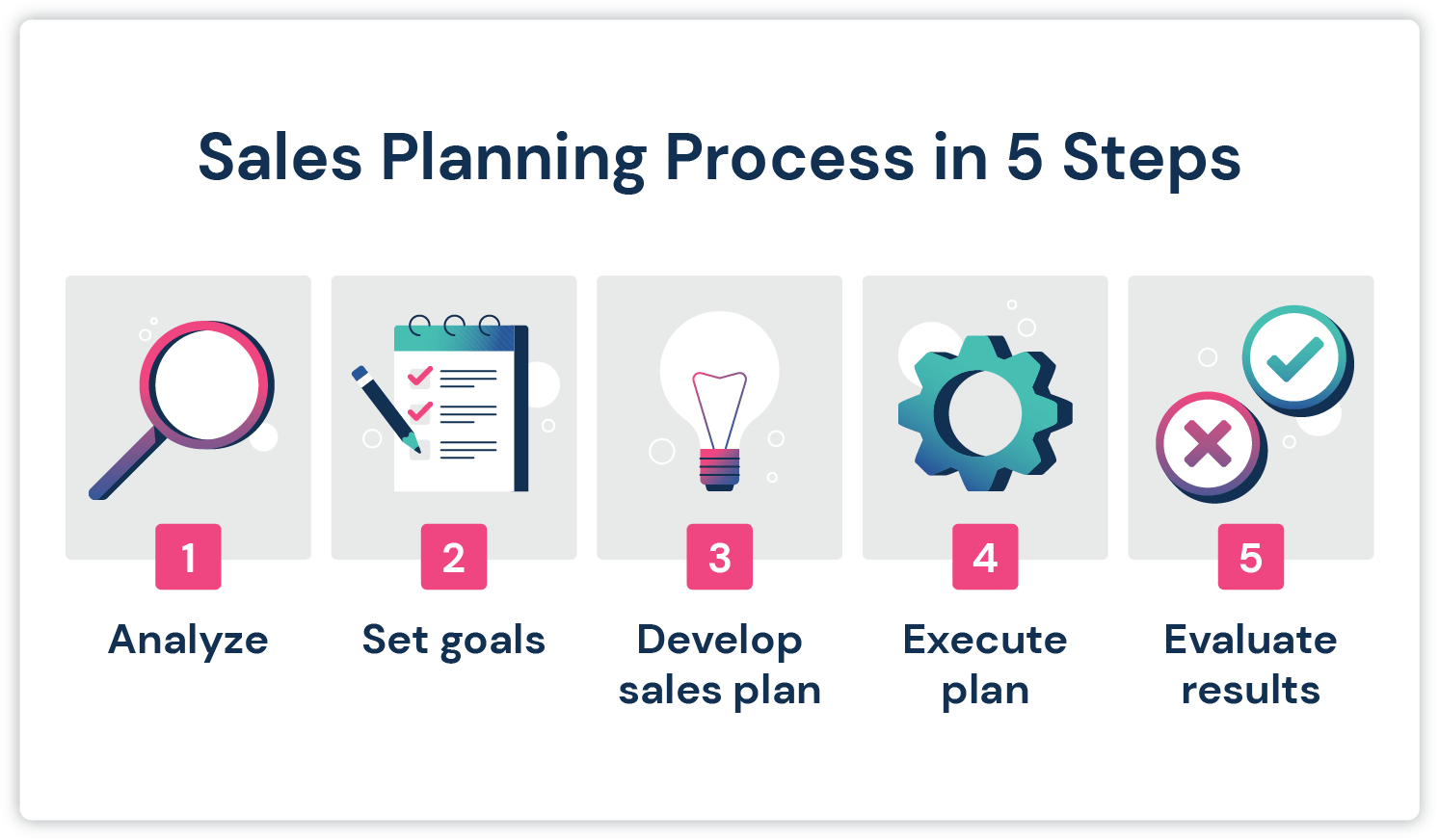
It’s important to keep in mind that sales planning isn’t just about creating a sales plan document. A sales plan should be a go-to item that’s used every day by your team, rather than sitting on your desk collecting dust. Creating an effective sales plan requires high-level strategy.
You should:
- Decide on a timeline for your goals and tactics
- Outline the context
- Write out the company mission and values
- Describe the target audience and product service positioning
- Include sales resources
- Draw out an overview of concurrent activities
- Write an overview of your business road map
- Outline your goals and KPIs
- Outline an action plan
- Create a budget
Below we dive into each of these steps to create your ideal sales plan.
1. Decide on Your Timeline
Setting goals and outlining tactics is not going to be productive if you’re not working toward a date by which you’ll measure your efforts.
Determining the timeline of your sales plan should therefore be your number one consideration. When will you be ready to kick-start your plan, and when is a reasonable time to measure the outcomes of your plan against your SMART goals?
Remember that you need to give the plan a chance to make an impact, so this timeline shouldn’t be too restrictive. However, you also want to make sure that you’re flexible enough to adjust your plan if it’s not producing the desired results.
Most sales plan timelines cover about a year, which may be segmented into four quarters and/or two halves to make it a little more manageable.
2. Outline the Context
Use the first page of your sales plan to outline the context in which the plan was created.
What is the current state of the organization? What are your challenges and pain points? What recent wins have you experienced?
Do you have tighter restrictions on cash flow, or does revenue appear to be growing exponentially? How is your sales team currently performing?
While you’ll discuss your business plan and road map later in the document, you can also outline the long-term vision for your business in this section. For example, where do you want to see the business in five years?
Tip: Comparing the current situation with your vision will emphasize the gap between where you are now and where you need to be.
3. Company Mission and Values
It’s essential that you put your mission and values at the heart of your business. You need to incorporate them into every function – and this includes your sales plan.
Outlining your mission and values in your sales plan ensures that you remember what the company is striving for, and in turn helps ensure that your approach and tactics will support these objectives.
Remember: A strong brand mission and authentic values will help boost customer loyalty, brand reputation and, ultimately, sales.
4. Target Market and Product/Service Positioning
Next, you’ll need to describe the market or markets that you’re operating in.
What is your target market or industry? What research led you to conclude that this was the optimal market for you?
Who within this industry is your ideal customer? What are their characteristics? This could be a job title, geographical location or company size, for example. This information makes up your ideal customer profile .
If you’ve delved further into audience research and developed personas around your target market, then include them in here, too.
5. Sales Team and Resources
This step is simple: Make a list of your sales resources, beginning with a short description of each member of your sales team.
Include their name, job title, length of time at the company and, where appropriate, their salary. What are their strengths? How can they be utilized to help you hit your goals?
You should also include notes around the gaps in your sales team and whether you intend to recruit any new team members into these (or other) roles.
Tip: Communicate the time zones your team members work in to be mindful of designated work hours for scheduling meetings and deadlines.
Then, list your other resources. These could be tools, software or access to other departments such as the marketing team – anything that you intend to use in the execution of your sales plan. This is a quick way to eliminate any tools or resources that you don’t need.
6. Concurrent Activities
The next step in creating your sales plan involves providing an overview of non-sales activities that will be taking place during the implementation of your sales plan.
Any public marketing plans, upcoming product launches, or deals or discounts should be included, as should any relevant events. This will help you plan sales tactics around these activities and ensure that you’re getting the most out of them.
7. Business Road Map
For this step, write up an overview of your business’s overall road map, as well as the areas where sales activities can assist with or accelerate this plan. You’ll need to collaborate with the CEO, managing director or board of directors in order to do this.
In most cases, the business will already have a road map that has been signed off on by stakeholders. It’s the sales manager’s job to develop a sales plan that not only complements this road map, but facilitates its goals.
Tip: Highlight areas of the road map that should be touchpoints for the sales team.
Ask yourself what your department will need to do at each point in the road map to hit these overarching company goals.
8. Sales Goals and KPIs
Another important part of the sales plan involves your sales goals and KPIs.
Outline each goal alongside the KPIs you’ll use to measure it. Include a list of metrics you’ll use to track these KPIs, as well as a deadline for when you project the goal will be achieved.
It’s vital to make these goals tangible and measurable.
A bad example of a goal is as follows:
Goal 1: Increase sales across company’s range of products and services.
A better goal would look something like:
Goal 1: Generate $500,000+ in revenue from new clients through purchases of X product by X date.
9. Action Plan
Now that you’ve laid out your goals, you need to explain how you will hit them.
Your action plan can be set out week by week, month by month, or quarter by quarter. Within each segment, you must list out all of the sales activities and tactics that you will deploy – and the deadlines and touchpoints along the way.
Tip: Organize your action plan by department – sales, business development and finance.
While this is arguably the most complex part of the sales plan, this is where sales leaders are strongest. They know which approach will work best for their team, their company and their market.
Budgets vary from team to team and company to company, but whatever your situation, it’s important to include your budget in your sales plan.
How are you going to account for the money spent on new hires, salaries, tech, tools and travel? Where the budget is tight, what are your priorities going to be, and what needs to be axed?
The budget section should make references back to your action plan and the sales team and resources page in order to explain the expenditures.
6 Strategic Sales Plan Examples
You can create different types of strategic sales plans for your company, depending on how you want to structure your sales plan. Here are a few examples.
Customer Profile
A customer profile outlines your ideal customer for your service or product. It will usually include industry, background, attributes and decision-making factors.
Creating a customer profile helps narrow in on the target customer your sales team should focus on while eliminating unproductive leads.
Buyer’s Guide
A buyer’s guide is an informational sheet that describes your company’s services or products, including benefits and features. This document is useful both for your sales team but also for a potential customer who requires more information on the product before purchasing.
30-60-90-Day Plan
This plan is organized based on time periods. It includes outlines of goals, strategy and actionable steps in 30-day periods. This is a useful sales plan model for a new sales representative tracking progress during their first 90 days in the position or meeting quotas in a 90-day period.
This type of sales plan is also ideal for businesses in periods of expansion or growth. It’s helpful to minimize extra effort in onboarding processes.
Market Expansion Plan
A market expansion plan clarifies target metrics and list of actions when moving into a new territory or market. This sales plan model is typically used with a target market that resides in a new geographical region.
You’ll want to include a profile of target customers, account distribution costs and even time zone differences between your sales representatives.
Marketing-alignment Plan
Creating a marketing-alignment sales plan is useful if your organization has yet to align both your sales and marketing departments. The goal of the sales plan is finalizing your target customer personas and aligning them with your sales pitches and marketing messages.
New Product/Service Plan
If your organization is launching a new service or product, it’s best to create a sales plan to track revenue and other growth metrics from the launch. You’ll want to include sales strategy, competitive analyses and service or product sales positioning.
Sales Plan Template
4 additional sales plan templates.
Here are some additional templates you can use to create your own unique sales plan.
- Template Lab
- ProjectManager
5 Tips for Creating a Sales Plan
Now that you’ve seen and read through a few examples and a sales plan template, we’ll cover some easy but useful tips to create a foolproof sales plan.
- Create a competitive analysis: Research what sales strategies and tactics your close competitors are using. What are they doing well? What are they not doing well? Knowing what they are doing well will help you create a plan that will lead to eventual success.
- Vary your sales plans: First create a base sales plan that includes high-level goals, strategies and tactics. Then go more in depth on KPIs and metrics for each department, whether it’s outbound sales or business development .
- Analyze industry trends: Industry trends and data can easily help strengthen your sales approach. For example, if you’re pitching your sales plan to a stakeholder, use current market trends and statistics to support why you believe your sales strategies will be effective in use.
- Utilize your marketing team: When creating your sales plan, you’ll want to get the marketing department’s input to align your efforts and goals. You should weave marketing messages throughout both your sales plan and pitches.
- Discuss with your sales team: Remember to check in with your sales representatives to understand challenges they may be dealing with and what’s working and not working. You should update the sales plan quarterly based on feedback received from your sales team.
When Should You Implement a Strategic Sales Plan?
Does your organization currently not have a sales plan in place that is used regularly? Are you noticing your organization is in need of structure and lacking productivity across departments? These are definite signs you should create and implement a sales plan.
According to a LinkedIn sales statistic , the top sales tech sellers are using customer relationship management (CRM) tools (50%), sales intelligence (45%) and sales planning (42%) .
Below are a few more indicators that you need an effective sales plan.
To Launch a New Product or Campaign
If you’re planning to launch a new service or product in six months, you should have a concrete marketing and sales strategy plan to guarantee you’ll see both short- and long-term success.
The sales plan process shouldn’t be hasty and rushed. Take the time to go over data and competitor analysis. Work with your team to create objectives and goals that everyone believes in. Your sales plan should be updated formally on a quarterly basis to be in line with industry trends and business efforts.
To Increase Sales
If your team is looking to increase revenue and the number of closed sales, you may need to widen and define your target audience. A sales plan will help outline this target audience, along with planning out both sales and marketing strategies to reach more qualified prospects and increase your sales conversion rate.
Now that you’ve seen sales plan examples and tips and tricks, the next step after creating your sales plan is to reach those ideal sales targets with Mailshake . Connect with leads and generate more sales with our simple but effective sales engagement platform.

- Content Marketing
- Practical Prospecting Podcast
Continue reading

Accelerate: Sales Landscape in 2024

How to Create a Social Selling Strategy in 2024

13 Must-Have Sales Certifications for Your Team in 2024
Grow your revenue faster, automate all your sales outreach with mailshake..

- Mailshake Blog
- Cold Email Masterclass
- Cold Email Academy
- Prospecting Podcast
- Accelerate Newsletter
- Follow-Up Strategy
- Email Analyzer
- Live Training
- Data Finder
- LinkedIn Automation
- AI Email Writer
- Email Deliverability
- Lead Catcher
- Chrome Extension
Integrations
Generate Leads
Find quality leads and discover new lead sources
- Email Finder
- LI Prospect Finder
- Email Verifier
Close Deals
Automate outreach with personalized emails to grow sales
- Drip Campaigns
- Email Deliverability Check
- Email Warm-up
- Gmail Email Tracker
Manage Sales
Keep your lead base organized and your clients buying
Snovio Academy
Expert-led crash courses on growing sales.
Case Studies
Stories of growth from real businesses who use Snov.io
News, analysis, growth tips, tutorials and more
Sales Cheats
First-aid solutions to the most common sales problems
Help Center
Find answers to all your Snov.io questions with detailed guides
Beginner-friendly articles on all things sales and marketing
Security Center
See which audits and certifications ensure top-level protection of your data
Sync Snov.io with over 5,000 of your favorite tools and apps
- Pipedrive Integration
- Hubspot integration
Integrate Snov.io features directly into your platform
How To Create A Sales Plan: Steps, Templates, And Examples

Want your sales to skyrocket?
You’ll need a strategy. And for the sales success, nothing works better than a strategic sales plan. The key concern, of course, is how to design a plan that impacts sales.
We’ve collected the necessary steps and sales plan examples so that you can promptly create a document that’s right for your organization.
Advantages of a sales plan.
- Strategic steps to create an efficient sales plan
- Strategic sales plan templates
What sales plan to choose?
Let’s deal with the definition and sales plan elements first.
A sales plan is a strategy document that lays out a company’s plan for improving sales results over a particular period.
Its components may differ. But they all focus on the business’ growth: profit plans, sales strategies, analytics, target market, existing sales force potentials, and much more. +
To make things easier, we narrowed them down to 9 main elements that lead to smooth selling. But feel free to use as many of them as you like.
1. Revenue targets and business goals
Without goals, you won’t know if your sales strategy was successful, right? This is the part where you can set a specific number to shoot for or create multiple goals for your sales team.
If you are in doubt about what to include, here are some examples to spark a thought:
- Specific sales numbers;
- Number of new clients you want to convert;
- Number of existing customers you plan to nurture and retain;
- Sales goals around a new product or service you are offering.

If you write an annual sales plan, you can briefly recap the previous year, its goals, scope of work, and results. Identify the mistakes and actions that led to positive results and draw a lesson from them.
3. Your ideal customer profile and their user journey
Ask yourself a question: who do you want to attract and convert? Demographics, purchasing habits, and other factors will help you create your buyer persona .
But you shouldn’t stop here. It’s useful to outline the customer journey of your clients and suggest ways to improve their experience at every step of the sales funnel.
4. Customer segmentation and tactics to work with each segment
In this section, you can describe all segments of the leads you get from your channels and ways to communicate with them to boost profit generation. If new segments might appear in the future, describe them as well.

Research market trends that can strongly affect your sales and suggest ways to use them to boost your performance.
Without a budget set in place, you risk spending more resources than you intended to. Think of the team size and operational tools you need to process and close the deals.
7. Strategies and tactics
Suggest the best approaches for your company and describe their implementation.
8. Action plan for individuals and teams
Here, you can determine the roles and responsibilities of specific staff members, assign tasks, and set deadlines for them.
9. Performance criteria and analytics benchmarks
Describe the tracked metrics and systems that help monitor them.
You might now think, “That’s too many components to describe, do I need a sales plan at all?” Yes, you do. Let us explain why.
Of course, a sales plan promotes self-discipline and diligence, but it also ensures that your sales don’t dry up over time. Which means it’s not optional.
We all tend to talk a lot, but without a plan, your goals might never turn into reality. So, the first advantage of a sales plan is that it helps you realize all of your greatest ideas.
Besides, with it, you can determine the demand for your solution and identify new product areas to predict the growth of your business. It’s also a great tool in analyzing your rivals and competitive advantage to distinctly position your company in the market and specify your product niche.
Without the sales plan, it would be hard to choose strategies and metrics for your sales team. And, as a result, it would be more difficult to measure your progress, optimize your performance over time, and motivate stakeholders.
Here are all the benefits summarized:

8 strategic steps to create an efficient sales plan
If you only start in sales and have neither sales planning experience, nor previous statistics, the following extensive guide will help you organize your work at every step, be it a small startup or a big corporation.
Each aspect of the sales plan moves gradually into the next, beginning with the team’s high-level objectives, then considering market conditions, checking your existing audience, and discovering more leads to help you meet your sales demands.

1. Set sales goals and metrics
Your sales plan structure needs an end goal . Identify what you can yield based on the size of the market, skills, and tools available to your sales team.
The biggest mistake you can make here is to set unrealistic goals. Yes, we know, you might be over-optimistic. But if you assume, for example, that the market’s going to go down and you’re going to lose a certain share, it won’t make any sense to forecast an increase in sales, right?
Another piece of advice is to ask your sales team what they think your goals should be. These people closely work with your clients and have the best understanding of them. Ask their opinion, give them enough time to think it over, and then discuss it together. Or, you can get a more experienced person to analyze the plan and help set metrics before approving it.
Remember, your goals must be SMART !

What metrics should you track while analyzing the success of your sales department? There are plenty of them to monitor:
- Sales growth
- Sales target
- Current opportunities
- Product performance
- Sales to date
- Quote-to-close
- Lead conversion rate
- Sell-through rate
It would be great for a team to have all the metrics displayed on one clear, intuitive dashboard . You can include screenshots of such dashboards in your sales plan for a more effective demonstration. For this task, such free tools as PowerPoint, Google Sheets, or Excel can be of great help. Or you can use any other software, as in the example:

“But what if it turns out I was wrong in some of my assumptions around the sales plan objectives?”
Don’t worry. If you’re developing a template for the first time, this is perfectly normal. But what’s essential is that you’ll be able to learn what needs to be improved when it’s time for the next version of your sales plan.
2. Set deadlines and milestones
It will take a while to achieve your goals, so why not split them into smaller sized milestones with deadlines to track the progress? These targets are extremely convenient in checking if your sales plan is on the right track.
Use last year’s statistics . Observe how sales earnings improved and compare your company to the market criteria. Again, talk to your sales team about their work, how they generate leads, and how they convert them into clients. What is the current conversion rate? How many deals do they expect to close in the future? This will show you what objectives to set.
Your milestones need to be precise with definite deadlines . For instance, you might want to increase your client base by 25% or boost your revenue by 40% for a specified product by the end of Q3. No matter what the milestone is, set clear objectives and a tough deadline.
This is not it. It’s better to also set personalized milestones for your sales professionals, considering differences among your employees.
For example, if somebody on your team is sending a lot of emails but not getting deals, give them the task of increasing the number of their closed deals. If someone’s awesome at closing deals but doesn’t do much outreach, give them the task of generating at least 20 new leads a month.

Oh, and set the budget as well! It usually includes:
- Sales training
- Salary and commission
- Tools, software, and resources
- Travel costs
3. Study market
You now know what you want. It’s high time to define the market niche you’re in so that you can accurately position your business to achieve the best results.
What’s a market niche? It’s what your company specializes in and also the place your business occupies, not only with your solution but also with generated content, corporate culture, and branding. It’s the way your audience identifies with you and recognizes you among competitors.
To analyze your niche, answer the following questions:
- How big is your potential market?
- Is there an inherent demand for your product?
- What’s your market situation today? ( SWOT analysis will be awesome here)
- Who are your competitors? (Again, SWOT analysis)

The key here is to find what your competitive benefit is:
- Why do clients decide to purchase from you?
- Why do customers buy from your rivals and never from you?
- How come some prospective leads do not purchase at all?
- What must you do to achieve success with time?
Keep in mind that clients purchase advantages, not characteristics. Whenever explaining your value proposition , it’s an easy task to get trapped in talking about your business too much. Put the script aside and mention exactly what your solution does for clients.
A good competitive advantage :
- Shows the competitive power of the organization
- Is ideally, although not always, unique
- Is obvious and simple
- May change over time
Your competitive advantage isn’t just a fundamental component of your sales strategy, it will determine everything your organization does, from advertising to product enhancement.
4. Build an ideal customer profile
Before you get inside your potential clients’ heads, you need to define who your target market is. Ask yourself questions:
- What do your best customers look like?
- What’s their personality like?
- What are their age, level of income, and living situation?
- What does their career journey look like?
- What industry do they belong to?
- Do they have the same pain points ?
- What are these challenges preventing them from achieving?
- What influences their decision-making?
- What content and information is most useful when communicating convincingly with them?
- What sorts of social networking platforms do they normally use?
5. Determine what systems, tools, CRMs to use
It will be hard to do everything without the right resources for the job. And that’s where CRM software and sales automation tools come in handy.
CRM is a technology for managing all business relationships and interactions with existing and potential customers within a company. It helps gather information on how many emails your team is sending, how much time they’re spending on qualifying leads, and how much revenue they are bringing in.
Meanwhile, with sales automation software, you will be able to standardize and automate the entire sales process. There are lots of professional tools for sales teams, these are just some of the examples:
- Salesforce,
- Freshsales,
- Insightly,
- Pipedrive,
- Microsoft Dynamics 365,
For example, a tool like Snov.io helps you fill your marketing funnel with quality targeted leads and close them easier. You can focus on every stage of the sales funnel and business growth: market research, lead generation, nurturing, conversion, statistics, analysis, and business forecasting for scaling and future growth.

6. Support existing customers
Don’t underestimate your current dedicated customers. References, word-of-mouth, client feedback, and existing connections are your best sources that ensure additional growth.
Check if anybody you know on social media can recommend you to one of your desired prospects. Contact loyal clients and offer them a discount or a referral bonus if they know someone who would profit from your products or services.
7. Find partners for strategic cooperation
Many entrepreneurs, startups, and big organizations might target the same types of customers. But oftentimes, they are not your competitors but rather offer services that can complement your solution (this is why they can be called CSPs or Complementary Service Providers).
You can engage with them in different ways:
- Writing for their website or blog;
- Delivering speeches at webinars or offline seminars;
- Offering valuable resources for their platforms;
- Creating a mastermind group where you can exchange contacts.
The more value you provide to your business partners and target audiences, the more connections you will have. All these services are provided for free and included as an additional investment in your sales strategy plan.
8. Keep studying your statistics, analyze, and modify your approaches
Don’t forget that your sales plan is a flexible document and needs to be regularly updated according to new market trends, outreach campaigns, features, or even staff members. Return to the document from time to time to see if your prognosis is close to reality.
Organize regular meetings to discuss progress, discover and solve problems, align the work across teams, get experience from your failures and success, and enhance your plan accordingly.
Strategic sales plan templates
If you want to find more inspiration, check out these simple yet helpful sales plan template examples.
- HubSpot Sales Plan Template
- Sales Plan by Asana
- BestTemplates Sample Sales Plan
- Venngage Online Sales Plan Maker Map
- BestTemplates Simple Plan
- Creately Sales Strategy Plan
- FitSmallBusiness Sales Plan
- BestTemplates Sales Action Plan
- TemplateLab Sales Plan Template in Microsoft Word

There might be one more question unanswered – what template to choose? It all depends on your particular business goals:
- The most common one is the 30-60-90 day sales plan with milestones that need to be achieved by each period.
- A weekly or yearly sales plan is also an option.
- You can create a sales plan for specific sales tactics , such as email drip campaigns, prescribed calls, and appointments. It sort of resembles a yearly/weekly sales plan, but it focuses on assessing and increasing gains for a single objective or task.
- In the meantime, sales professionals who manage a specific market region typically use region sales plans to present CMOs and VPs with more clarity of their sales initiatives.
Wrapping up
In many product sales circumstances, the greatest challenge is passiveness. However, with a great, step-by-step product sales plan and a passionate team with distinct milestones in mind, you’ll have everything you need to endure any resistance and carry on hitting your targets!
Leave a Reply (0) Cancel reply
Most Popular

How To Handle Sales Objections And Avoid The Backfire Effect
14 November 2023

Grow Your Business With Targeted Email Marketing
31 January 2024

How To Improve Customer Experience With Email
13 December 2022
Copied to clipboard
Thanks for subscribing 🎉
You will now receive the freshest research and articles from Snov.io Labs every month!
We've seen you before 👀
It looks like you've already subscribed to Snov.io Labs. Be patient - our next newsletter is already in the works!
Filter by Keywords
10 Free Sales Plan Templates for an Effective Sales Strategy
Praburam Srinivasan
Growth Marketing Manager
February 15, 2024
Every sales team wants to win more leads and close more deals. But how do you make that happen? With a solid sales plan, of course!
A sales plan gives your team a way to focus on your goals while taking only the necessary steps to get there. It has everything you need to win, which means it’s often a comprehensive guide—and that takes time.
And we’re guessing you’re already pressed for time. ⏲️
Fortunately, creating a plan doesn’t have to be complicated—with the right template, you can simplify the process.
That’s why we’re sharing this list of the best sales plan templates. Not only are these sales strategy templates absolutely free but they’ll also save you time so you can start closing those deals faster. ⚡
What Is a Sales Plan and Why Create One?
1. clickup sales plan template, 2. clickup sales and marketing plan template, 3. clickup sales strategy guide template, 4. clickup sales pipeline template, 5. clickup sales kpi template, 6. clickup b2b sales strategy template, 7. clickup sales calls template, 8. word sales plan template by business news daily, 9. word sales plan template by templatelab, 10. excel sales plan template by spreadsheet.com.
A sales plan is your roadmap for how to make sales effectively. Think of it in the same way that a business plan guides the strategy for your company or a marketing plan sets out how you’ll find, reach, and serve your ideal customers.

A good sales plan sets out your sales goals , objectives, and sales activities. It considers your target audience, brand, products, services, and needs—and covers which sales tactics and strategies you’ll use to close deals, as well as which metrics you’ll use to measure success.
Your sales plan is a practical plan that outlines who’s responsible for what, the resources you’ll need, and the overall goals you’re working toward. Without one, your sales team will feel lost and struggle to connect with your customer base.
With a strategic sales plan, though, the sales manager and the entire team will know exactly what you’re trying to achieve and the steps needed to get there. 📚
How to choose the best sales plan template
There are so many different sales plan templates out there. Some are designed for specific niche audiences, while others are more generic and easier to customize. How do you know which is the right template for you?
When you’re thinking about using a sales plan template, consider the following:
- Ease of use: Is the template easy to use? Will everyone in the team structure and sales planning process be able to understand it fully?
- Customization: Can I personalize the template to match my sales goals?

- Collaboration: Can my sales team work on this template together?
- Integrations: When I create a sales plan, can I integrate this template with other aspects of my sales pipeline or workflow, like task management?
- Artificial intelligence: Can I use a built-in AI writing tool or copywriting tool to help me complete the template? Are there automation features that speed up the process?
- Platform: Which sales app is this template for? Do I have it already, or should I invest in it? What’s the pricing like?
Asking yourself these questions will help you figure out what your needs are, so you can then choose a template to match.

10 Sales Plan Templates to Help You Close Your Next Deal
Now that you have a better idea of what you’re looking for, let’s explore what’s out there. Take a look at our hand-picked selection of the best sales plan templates available today for Microsoft Word and sales enablement tools like ClickUp.

Smart sales teams use a sales plan to map out their route to success. The best sales teams use the Sales Plan Template by ClickUp to simplify the process and ensure they don’t leave anything out.
This template is designed with all the structure you need to create a comprehensive sales plan that can drive results. Use this template to set SMART (specific, measurable, achievable, relevant, and time-bound) business goals; plan strategies and tactics; and organize all your sales ideas in one place.
The list-style template is split into sections that cover the executive summary all the way through to specific tactics and strategies. Beneath this, you can arrange tasks and subtasks, and see the progress at a glance. View task titles, deadlines, who’s responsible, approval status, and a visual progress bar.
Use this template if you want to consolidate all your sales tasks and initiatives in one area. Add your sales tasks and tactics, then tag team members so you can see what’s happening and hold everyone accountable. ✅
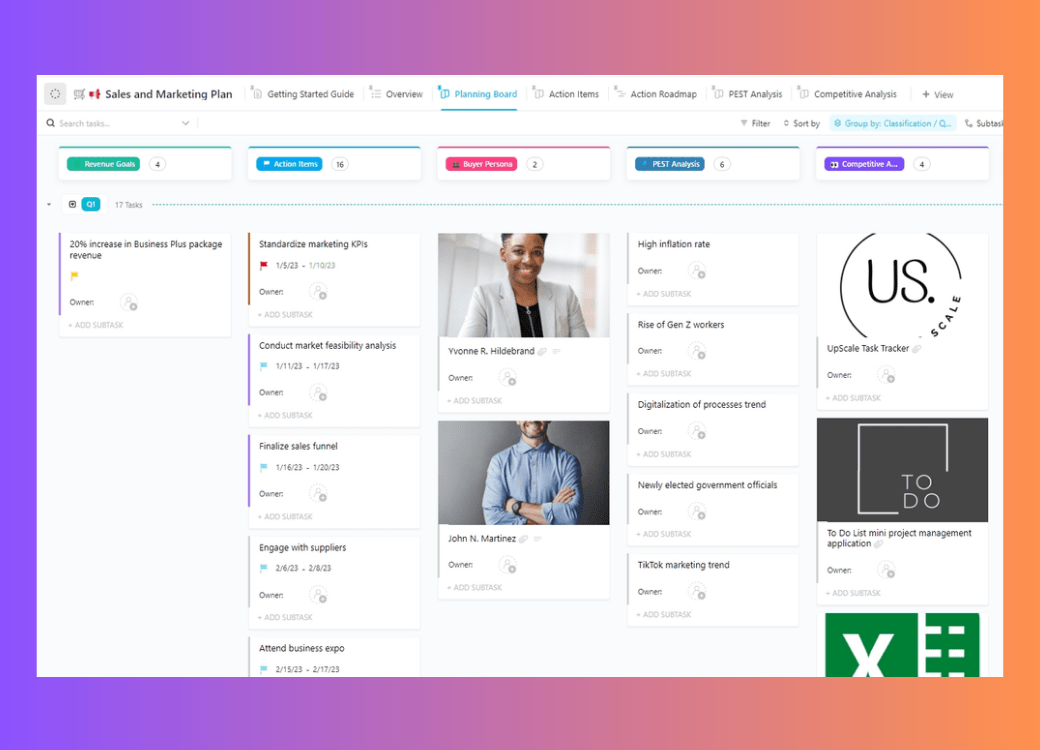
While sales and marketing teams often work independently, sometimes it’s useful to collaborate on shared goals. With the Sales and Marketing Plan Template by ClickUp , you can organize and run your sales and marketing operations from one location.
Our collaborative template makes it easy to set sales and marketing goals and objectives, visualize your tasks, work together on sales and marketing campaigns, and track your results in real-time. View the status of your sales and marketing projects, adjust your plans, and monitor your key performance indicators (KPIs)—all from one view.
This sales and marketing plan template allows you to split your tasks into sections. The examples in the template include revenue goals, competitive analysis, and action items, but you can customize these to match your needs exactly.
View tasks beneath these categories to see at a glance whether there are any roadblocks when a task is due, and who is responsible for it.
Add this template to your collection if you want to work more collaboratively with your marketing team—especially on preparing assets for sales calls or outreach programs. 📞

Before you can plan your sales tactics, you first need to decide what your overall goals are. The Sales Strategy Guide Template by ClickUp is your go-to resource for determining your approach.
This sales process template explains the benefits of having a well-defined approach and gives you a central place to create, review, and store your own. Everyone on your team can then access your sales strategy guide to help them understand what to do when prospecting and closing deals.
Our sales goals and strategy guide template is presented in a document format. Some sections and headings allow you to split your guide into different areas, making it easier to read and understand.
Use the prompts to fill out your own strategy guide details like your target market, sales strategies, and how you’ll monitor progress.
Use this sales strategy guide template to create a resource for your team. Make it the only destination for everything your sales reps need to know to execute an effective sales plan. 📝
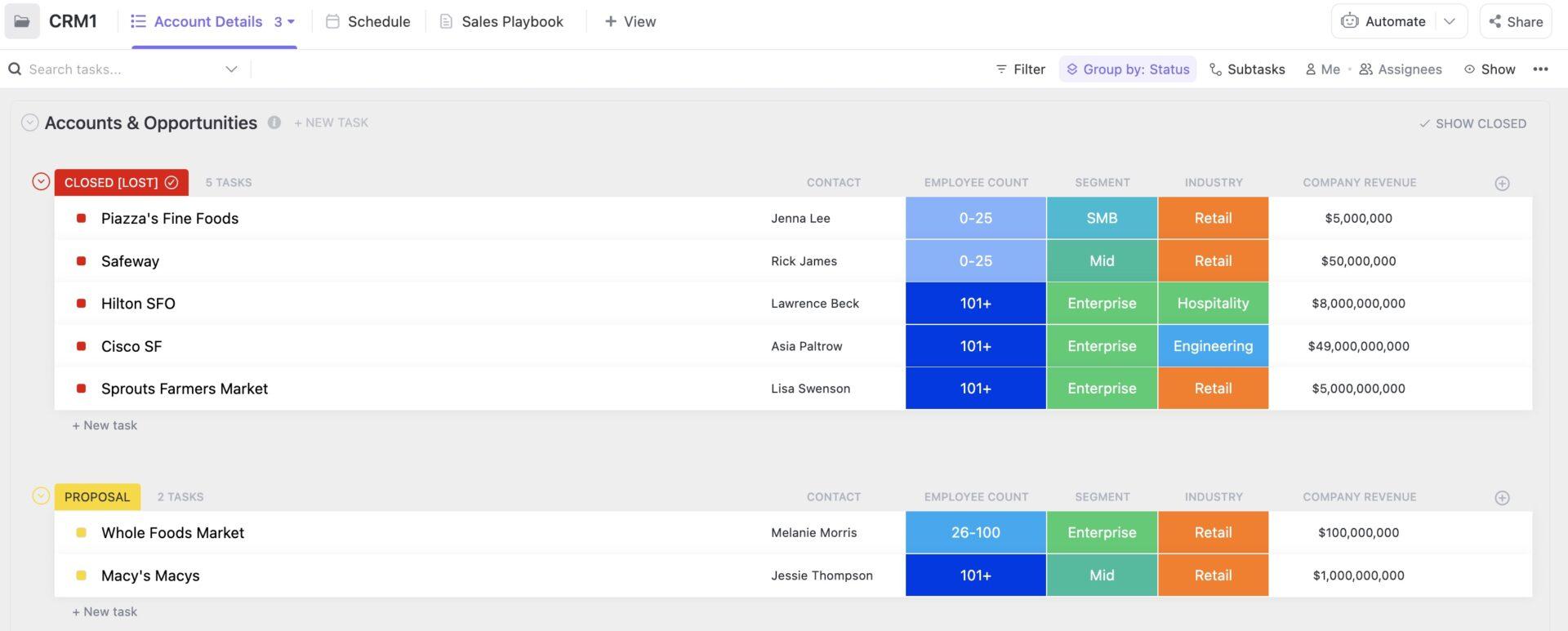
Sales strategies are a must-have for any great sales team, but beyond that, you need a way to record and monitor specific tasks or initiatives. That’s where the Sales Pipeline Template by ClickUp comes in handy whether you need a visual into sales forecasting or your specific sales goals.
This sales pipeline template gives you one place to store all your daily sales-related tasks. With this template, it’s easy to work toward your sales goals, track leads, map out each step of the sales process, and organize all your tasks in one place.
You can view a task’s title, assignee, status, due date, complexity level, start date, and department—or customize the experience with your own custom fields.

With ClickUp’s Sales KPI Template , you and your team can create and manage goals surrounding your sales initiatives. See instantly what’s in progress and when it’s due, alongside the task’s impact level.
This allows you to identify high-priority tasks to focus on and to react quickly if it looks like there’s a roadblock.
This sales KPI template includes:
- Custom Statuses: Create tasks with custom statuses such as Open and Complete to keep track of the progress of each KPI
- Custom Fields: Utilize 15 different custom attributes such as Upsell Attempts, Value of Quotes, Product Cost, No of Quotes by Unit, Repeat Sales Revenue, to save vital KPI information and easily visualize performance data
- Custom Views: Open 4 different views in different ClickUp configurations, such as the Weekly Report, Monthly Report, Revenue Board per Month, and Getting Started Guide so that all the information is easy to access and organized
- Project Management: Improve KPI tracking with tagging, dependency warnings, emails, and more
This template gives you a simple way to see which tasks are complete or in progress, so you can monitor the progress of your project and crush your sales KPIs. 📈
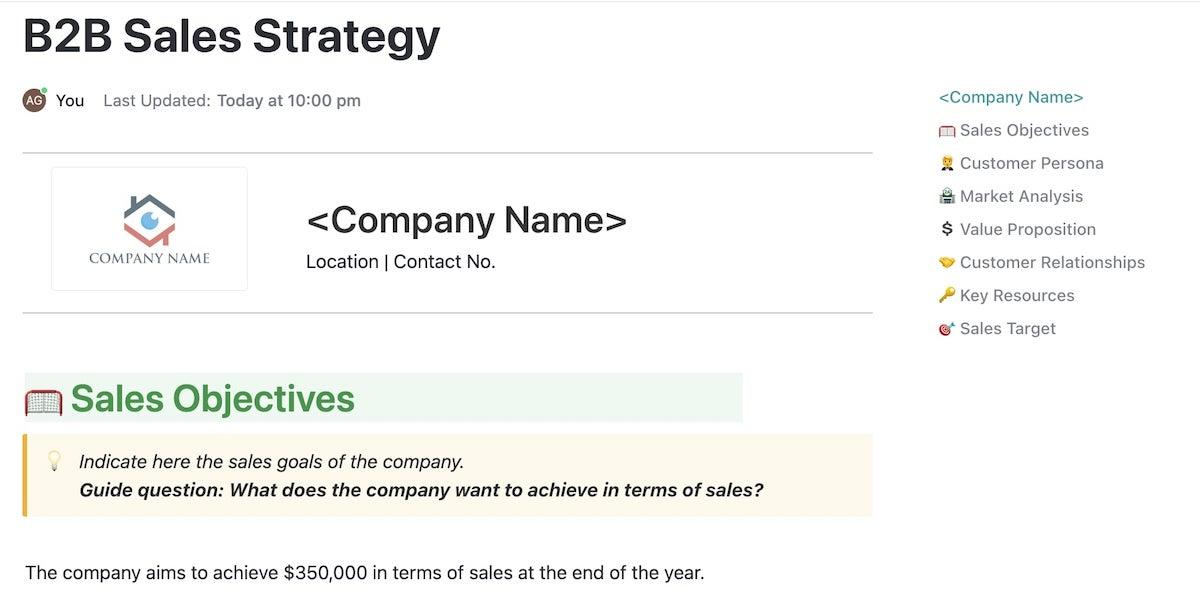
While there’s not a huge difference in the way we market to business-to-business (B2B) or business-to-consumer (B2C) customers these days, it’s still useful to have specific templates for niche needs. If you’re driving sales in the B2B space, you need the B2B Sales Strategy Template by ClickUp .
Like our first sales plan template, this one gives you space to communicate your sales objectives and revenue targets, but it also introduces other areas—like market research, stakeholder analysis, customer relationships, buyer persona, and customer pain points.
This document-style template is highly customizable so you can make it match your brand style and sales approach. Fill in each section and use the supplied prompts to complete your B2B sales strategy document even faster.
Add this template to your collection if you’re working in B2B sales and want to approach your process in a more organized way. Use the template to build a strong sales strategy, then share it with the rest of your sales team so they know how to execute against your sales and company goals. 🎯
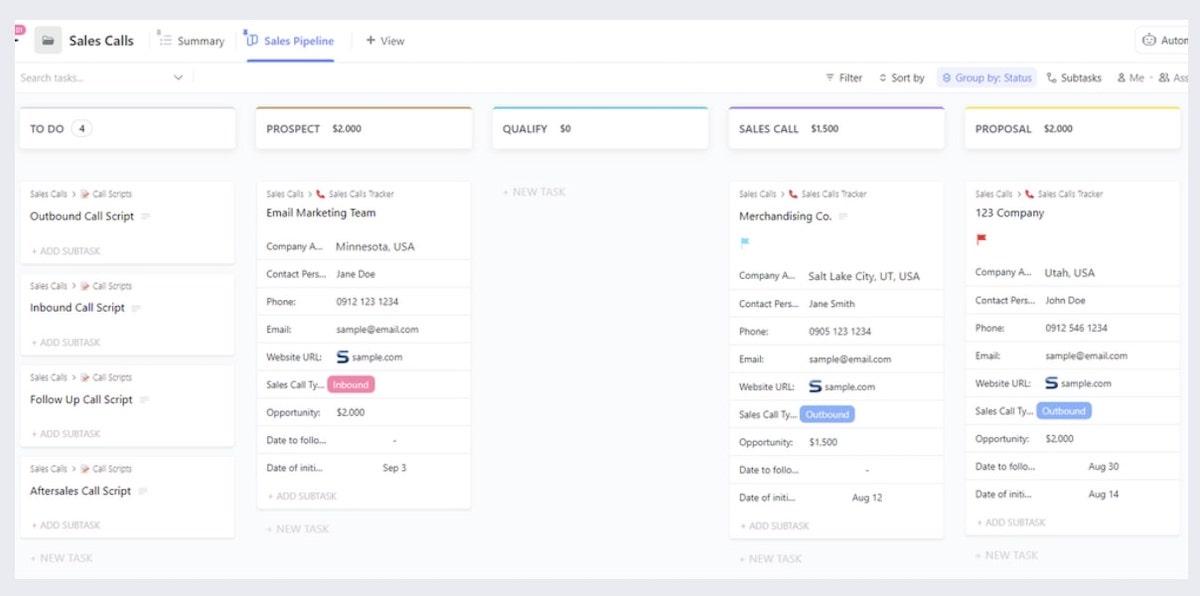
ClickUp’s Sales Calls Template is designed to streamline the sales process, from tracking contacts and calls to managing sales opportunities.
The template includes custom statuses for creating unique workflows, ensuring that every call and client interaction is accounted for. It also provides an easy-to-use Sales CRM to manage and track leads, visualize sales opportunities in the sales funnel, and keep all contacts organized.
With additional features like the Sales Phone Calls SOP Template, sales professionals can empower their teams to make every call count and close more deals. ClickUp’s Sales Calls Template is a versatile solution for sales teams, aiding in everything from daily calls to long-term sales forecasting.

We’re big advocates of using ClickUp as the go-to place to store everything about your sales workflow, but if you’re limited to using Microsoft Word or Google Docs, then this template is a great option.
This sales business plan template has sections for your executive summary, mission statement, target customers, sales targets, benchmarks, and more. Each section has useful prompts to guide you on completing your new sales plan.
Use this template if you’re tied to using Microsoft Word and want a comprehensive guide on how to create your own sales plan or sales strategy. 📄
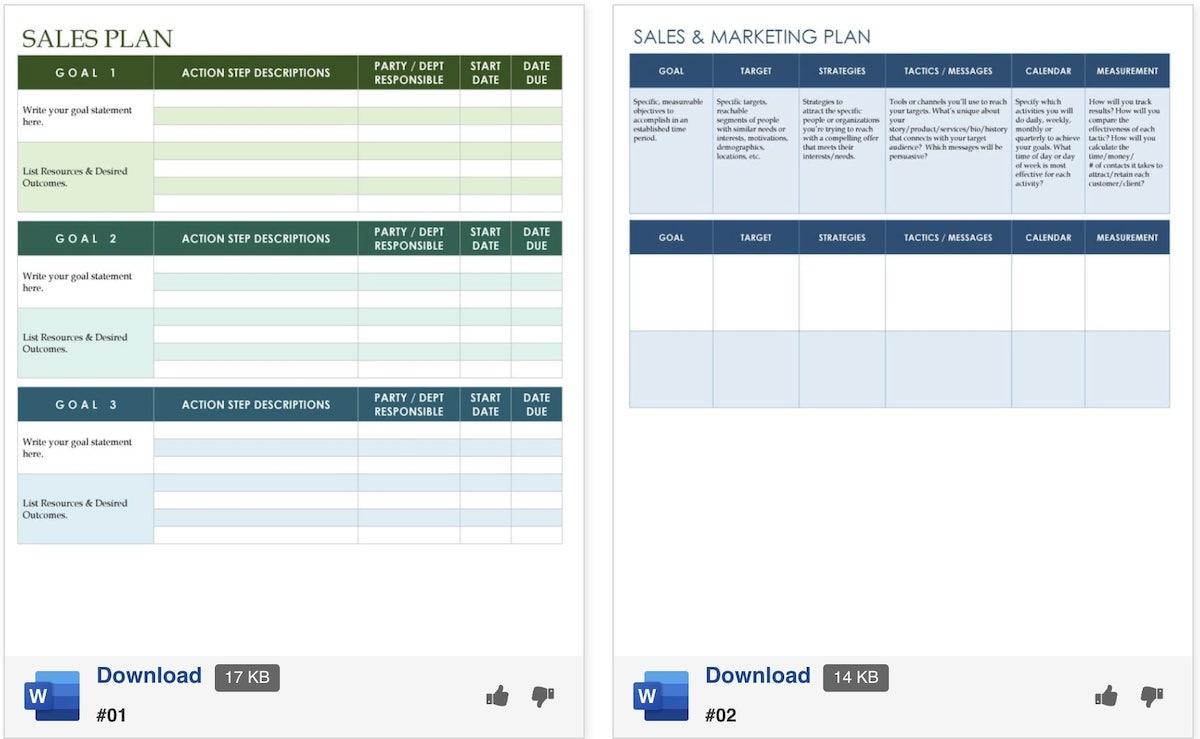
If you want a free sales plan template or want to choose from a variety of options, this collection of Word templates by TemplateLab is a good place to do that.
There’s a wide range of options available including sales process plans, lead generation plans, sales action plans, and sales report templates . Each template works with Microsoft Word, and you can customize the look and feel to match your brand or your sales goals.
Use this resource if you prefer to see a range of templates on one page, or if you’re not sure exactly what you’re looking for until you see it. You can easily set your sales goals and the action steps needed to achieve them. 📃
Successful sales strategies need to be integrated with other teams—like your marketing department—to ensure your sales objectives are clear and possibly align with the overall marketing strategy too. Choose your specific sales goals, set revenue targets, and describe everything in detail with these Word sales planning and sales process templates.
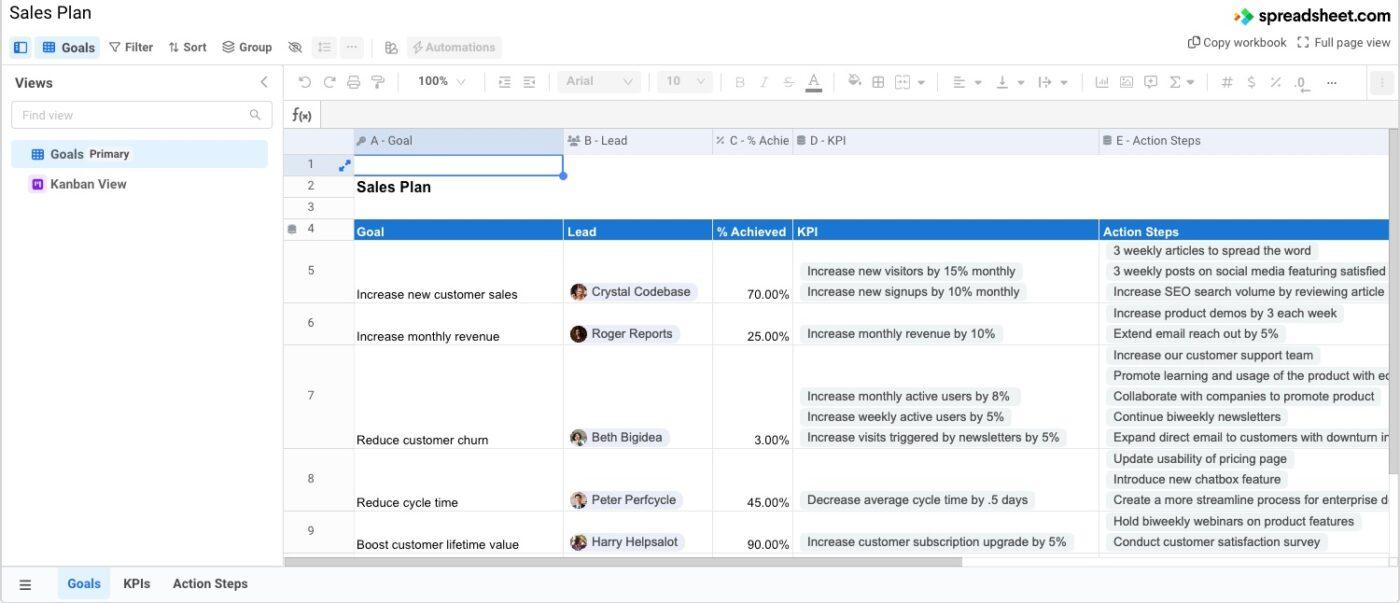
The Excel Sales Plan Template by Spreadsheet.com is a comprehensive and user-friendly tool designed to assist businesses in developing effective sales strategies and managing their sales activities.
T his template is crafted with the aim of providing a structured framework for sales planning, enabling organizations to set clear objectives, track performance, and optimize their sales processes.
Reach Sales Goals With Free Sales Plan Templates
A strategic sales plan makes it easier to achieve your goals. Give your team the guidance and support they need with the help of a well-crafted free sales plan template.
If you’re considering making even more improvements in how you work, try ClickUp for free . We don’t just have incredible sales process templates: Our range of features and AI tools for sales make it easy for you to optimize and run your entire sales funnel and CRM system from one place. ✨
Questions? Comments? Visit our Help Center for support.
Receive the latest WriteClick Newsletter updates.
Thanks for subscribing to our blog!
Please enter a valid email
- Free training & 24-hour support
- Serious about security & privacy
- 99.99% uptime the last 12 months
Strategic Sales Plan Examples: 13 Sales Plan Templates

Casey O'Connor
What Is a Strategic Sales Plan?
When you should implement a strategic sales plan, what to include in your sales plan, 13 sales plan template examples, put your sales plan into action with yesware.
A strategic sales plan is a must-have for any business looking to increase their sales, amp up their revenue, bring a new product to market, or branch into a new territory.
In this article, we’ll go over everything you need to know about strategic sales plans: what they are, when to create one, and exactly what they need to include. We’ll also show you a handful of real-life, tangible sales plan template examples and tips for implementation.
Here’s what we’ll cover:
- When You Should Implement a Strategic Sales Plan
A strategic sales plan is designed to guide a sales organization through their overarching sales strategy. It provides them with access to the resources needed to prospect, pitch to, and close new accounts.
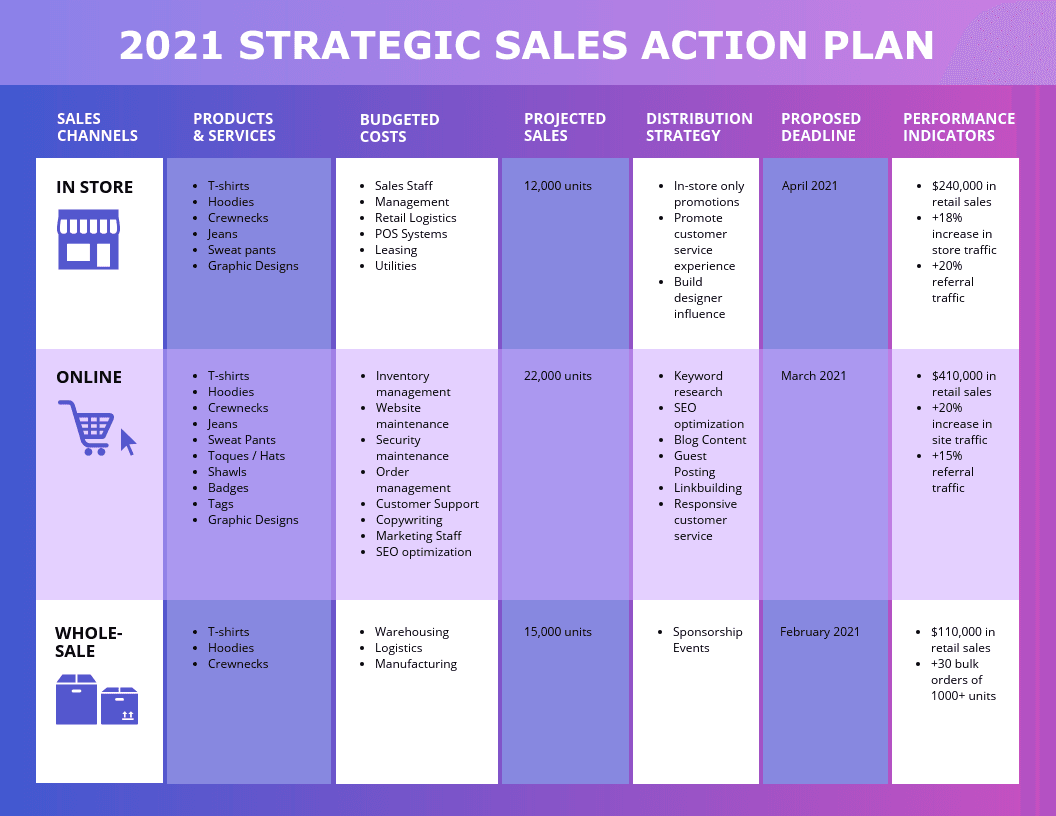
Strategic sales plans can include any combination of the following:
- Ideas: If you utilize a certain sales methodology — consultative selling or target account selling , for example — you might outline its key principles and a few tactical examples of it in action in your strategic sales plan. Your strategic sales plan should also include an overview of your target customer.
- Processes: In order for your sales team to reach maximum productivity, it’s important that your sales processes are clearly defined and standardized. Your sales team — both new hires and seasoned vets alike — should be able to refer to your sales plan for a repeatable, scalable process that’s backed by solid metrics. The processes should provide direction to sales reps that allow them to contribute to the company’s goals.
- Tools & Tactics: The best strategic sales plans are more than just high-level strategy and goals. They also include specific, step-by-step strategies that sales reps can implement in sales conversations, as well as the specific tools and content that reps need to close more deals.
Sales plans also typically spell out the organization’s revenue and overall business goals, as well as the KPIs and benchmarks that sales managers and other stakeholders will monitor to determine whether or not those goals are being met.
They should also outline management’s strategic territory design and quota expectations, with specific indicators and data to back those decisions.
Finally, these sales plans should take into account your current team’s sales capacity and specifically address the acquisition plan for any resources that are not yet available but may be necessary for future growth.
If your sales team doesn’t already have a strategic sales plan in place — that is, one that’s referenced and updated regularly and the product of careful data analysis and inter-team collaboration — you may want to consider creating one.
Research shows that the majority of the highest-performing sales teams operate under a formalized, closely monitored sales structure.
On the other hand, most underperforming sales teams lack this structure.
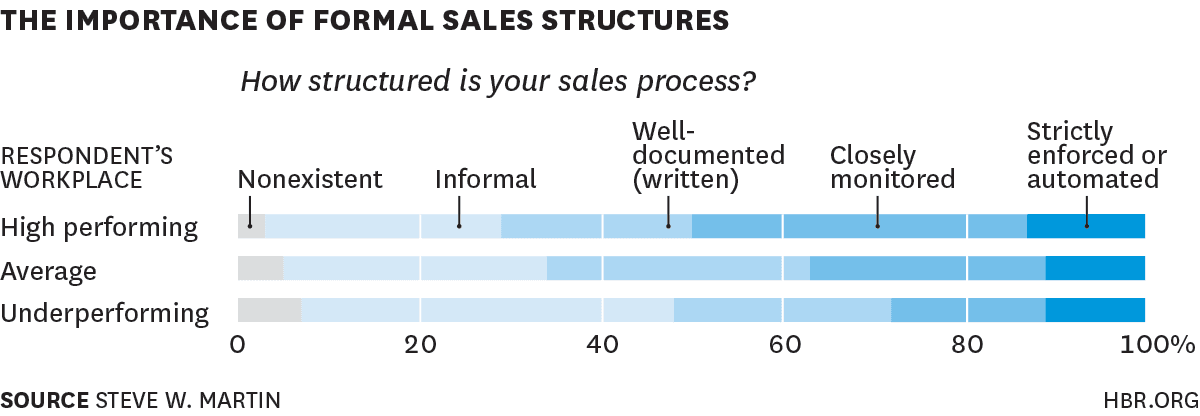
It’s clear that a well-defined sales plan is one of the prerequisites to optimized sales productivity and success; every salesforce should strive to create and adopt one if they want to meet their sales goals more efficiently.
That being said, there are a few key indicators that signal a need for more urgency in putting a strategic sales plan in place.
You’re Trying to Increase Sales
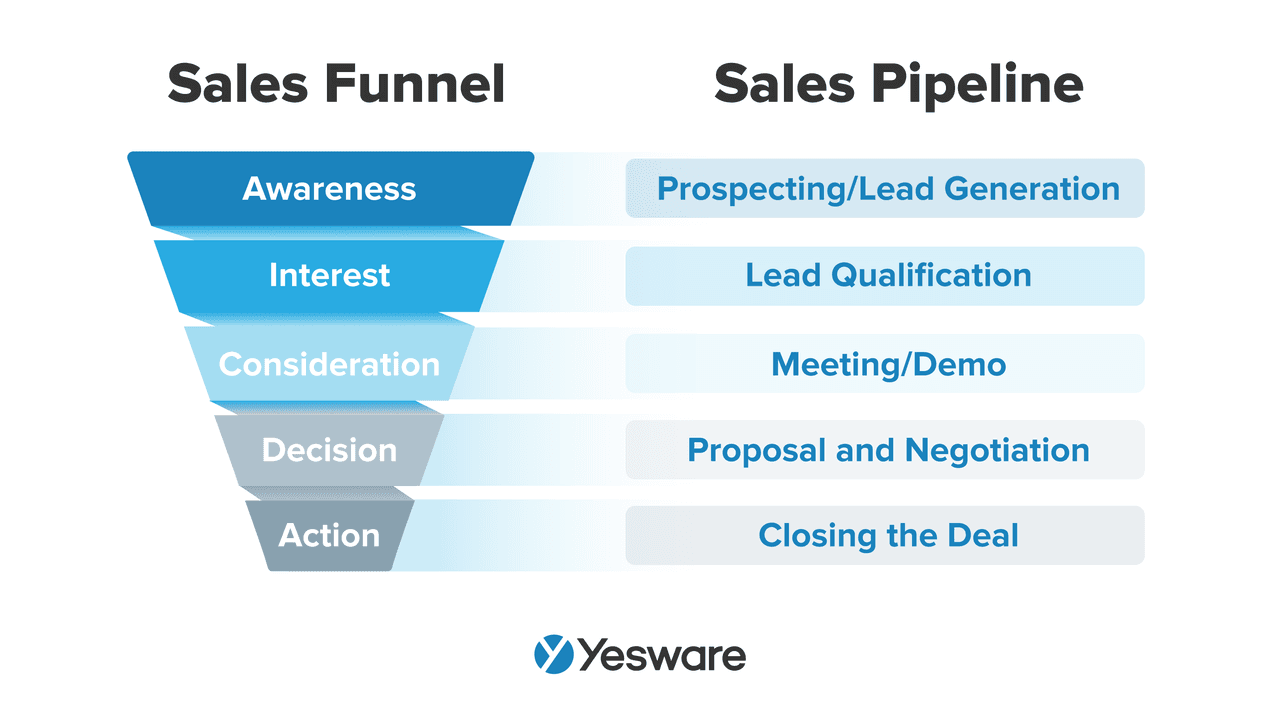
A strategic sales plan will help your sales and marketing teams align their processes so that your outreach efforts are tailored to your target audience.
You’re Looking to Amp Up Your Revenue
For startups and small businesses, attaining as many new customers as possible is usually the name of the game.
For larger or more established businesses, however, the business plan may instead emphasize revenue goals. In other words, the deal size starts to matter much more than deal volume.
A sales strategy plan can help salespeople target and nurture higher-value accounts. Sales planning can also boost your revenue by illuminating untapped potentials for revenue growth within your existing customer base through cross-selling, upselling , and referrals .
You’re Gearing Up to Launch a New Product
A sales strategy plan is crucial for businesses that are preparing to bring a new product to market.
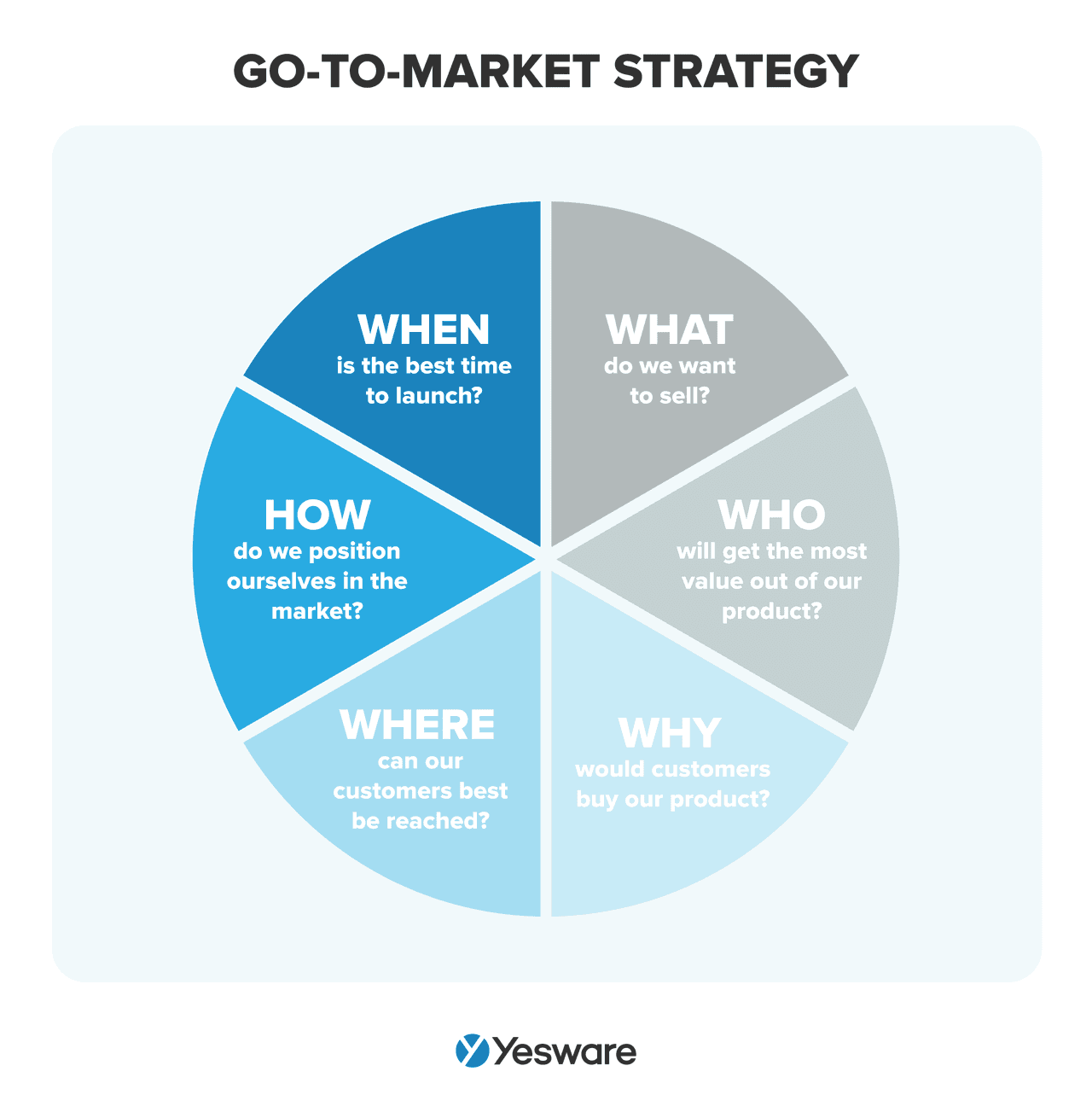
One last note: for businesses that already use strategic business planning (or for those on their way after reading this article), be sure to update your plan at least yearly. Many businesses at least review their plan, if not update it more formally, on a quarterly basis.
Ultimately, your strategic sales plan will be unique to your company and its specific goals.
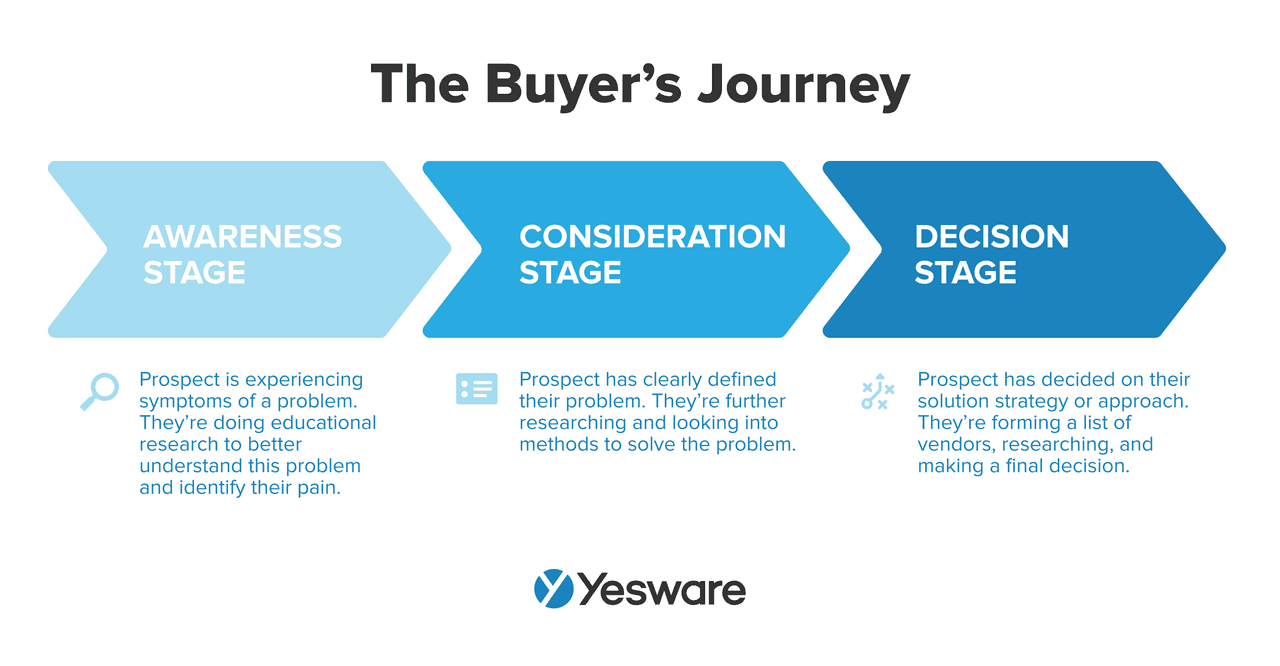
Consider including the following components in your strategic business plan.
Mission Statement
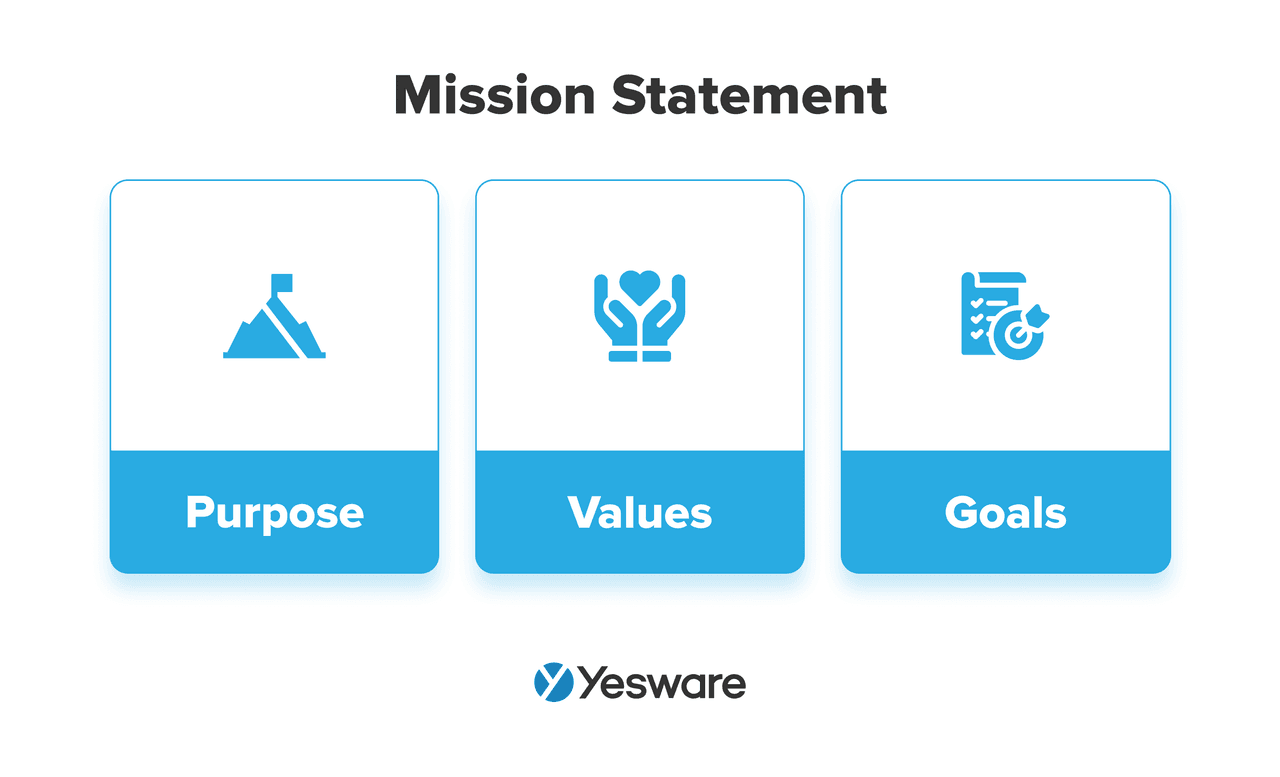
Industry & Market Conditions
Great sales planning cannot be performed in isolation. Your plan must take into account the current market conditions, including any challenges, recent disruptions, or upcoming notable events.
Organization Chart
A sales org chart can range in scope from very simple, like the one above, to more complicated. Some go as far as naming individual employees and outlining their specific responsibilities.
A detailed org chart is especially helpful for efficiently onboarding new hires.
Product Info & Pricing
No sales plan would be complete without a one-sheet that outlines the features, benefits, and value proposition of your product or service.
It’s also helpful to include information about pricing tiers, as well as any discounts or promotions available for leverage at a sales rep’s discretion.
Compensation Plan
While we have no doubt that you’ve hired only the most intrinsically motivated salespeople, remember the bottom line: cash is king.
Money is the primary motivator for most salespeople, regardless of how truly loyal and hard-working they may be.
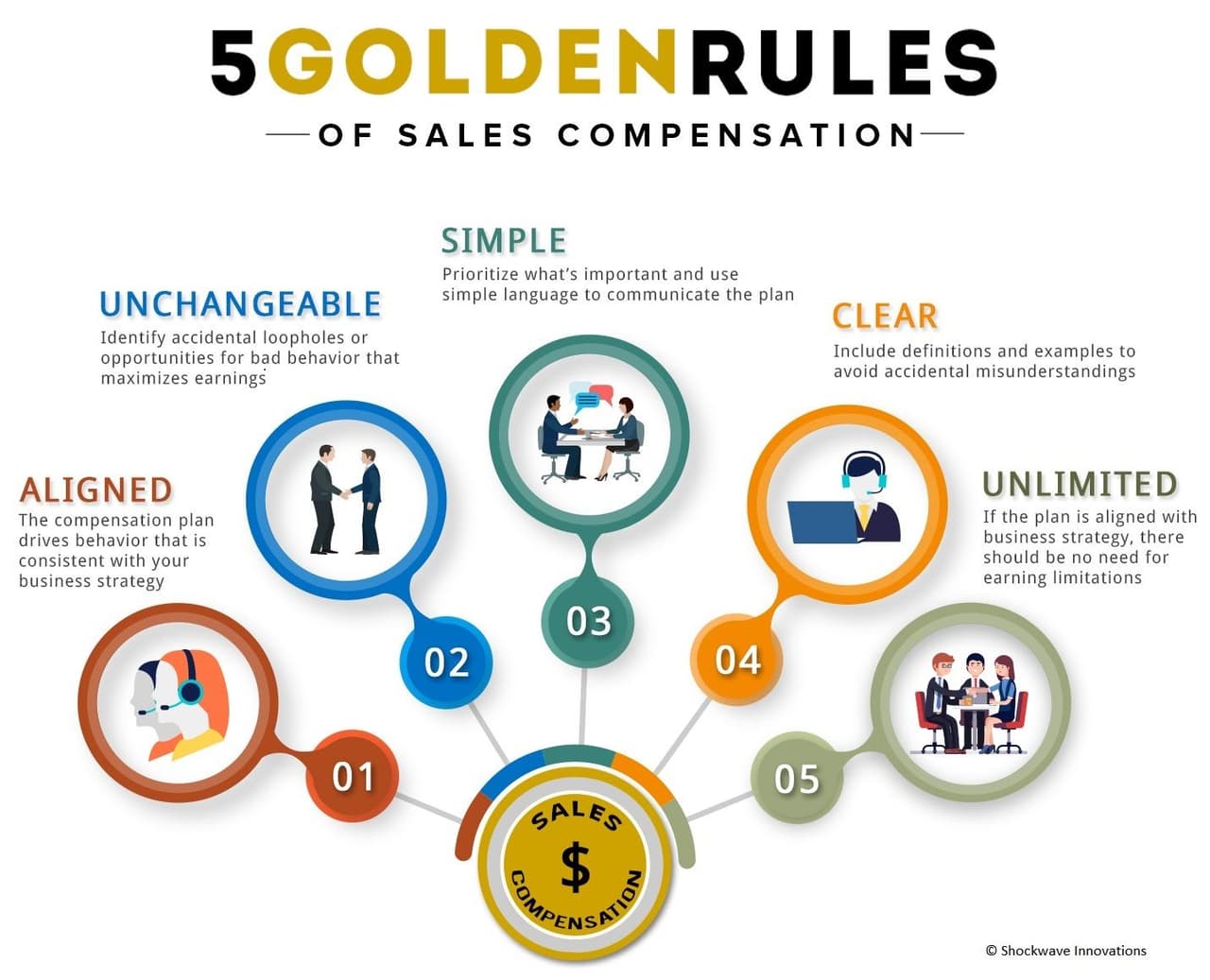
With that in mind, it’s a good idea to include your company’s compensation plan and commission structure in your sales plan. This is a surefire way to motivate your team to continuously improve their sales performance.
Target Market & Customer
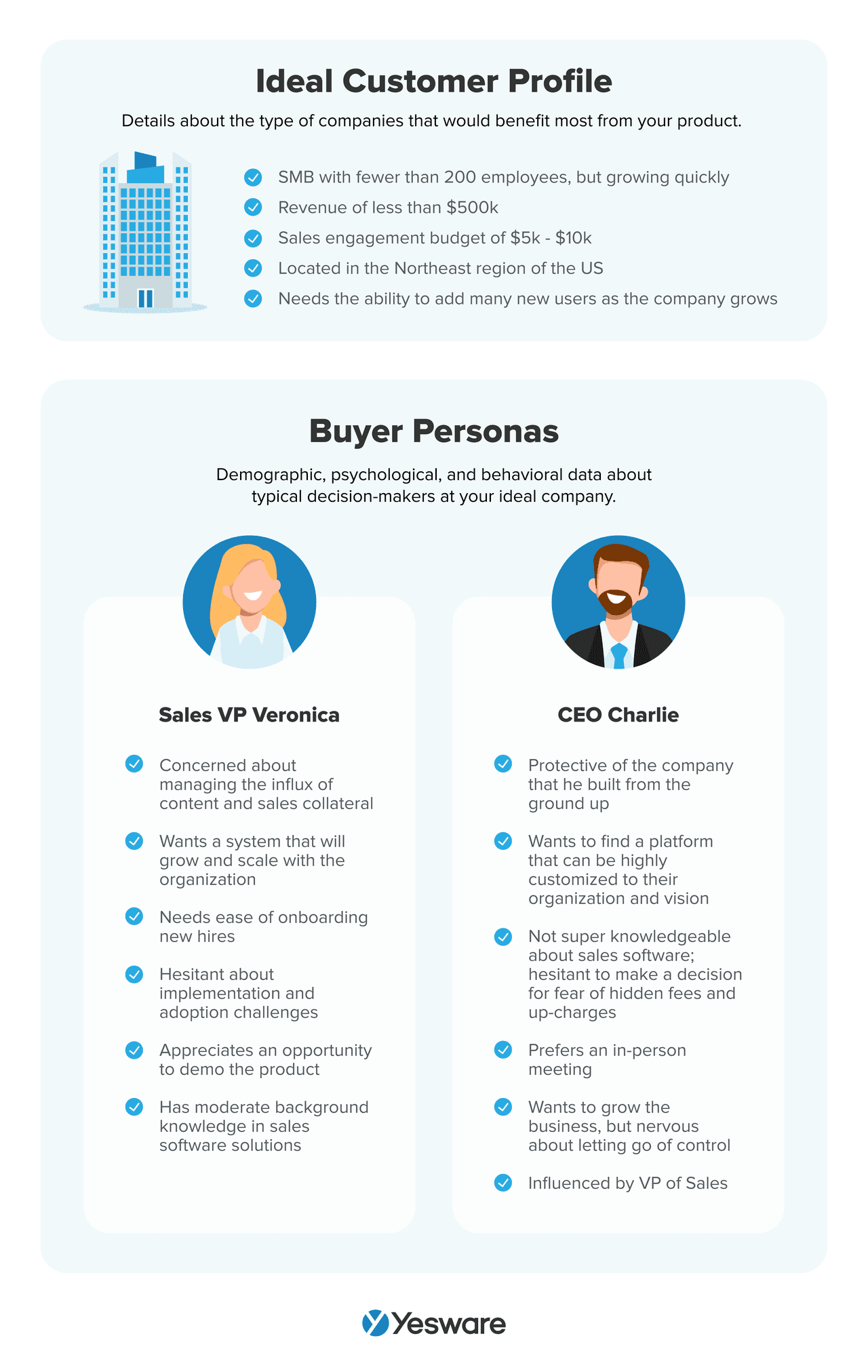
Sales Enablement
With the tremendous rise in content marketing, it can be challenging for salespeople to keep track of the various materials available for generating new business.
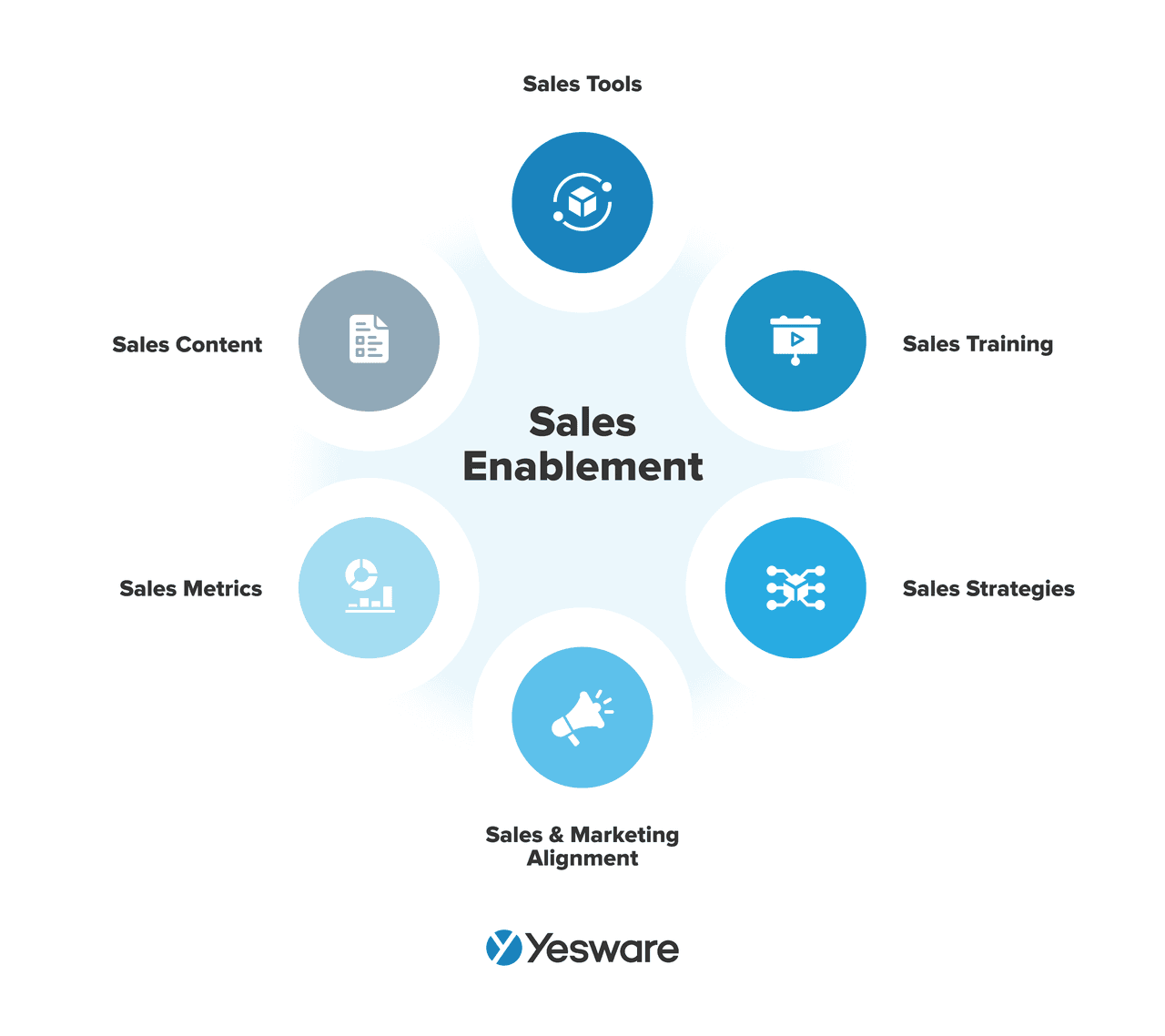
Branding & Positioning
The strategic sales plan should offer at least a high-level overview of your brand and messaging specifics, including social media presence. Take the time to optimize your company’s LinkedIn presence — it’s a goldmine of new business opportunities.
- Marketing Strategy
In today’s day and age, it’s unlikely that your sales and marketing team are working in isolation from one another. At a certain point, sales and marketing strategies start to flow together until they (ideally) perform in harmony.
Still, it’s important to outline the perspective of the marketing team within your strategic sales plan. This will help your salespeople fine-tune their sales pitch and speak more meaningfully to the needs of the customer.
Prospecting Strategy
Most salespeople report that their number one challenge in lead generation is attracting qualified leads.
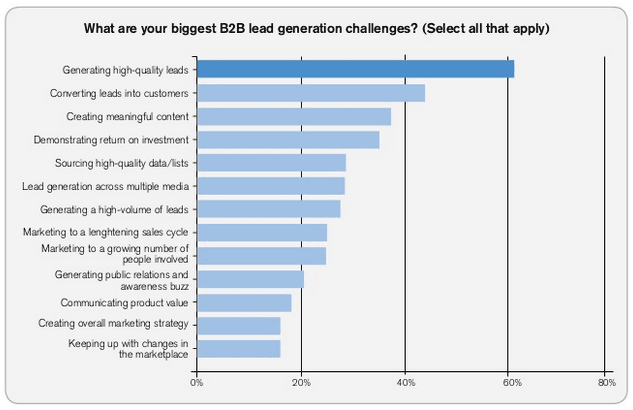
Prospecting can certainly be daunting, but it’s worth the effort to get it right. Tweak and fine-tune the process until you’re sure it’s as efficient as possible. Make sure it’s repeatable and scalable, and map it out within your sales plan.
- Action Plan
Any good strategic sales plan will also include a step-by-step section, much like a playbook. Here, you’ll outline the specific tactics and processes — including scripts, demos, and email templates — that have been proven to move prospects through the sales funnel .
Be as specific as possible here. This will act as a blueprint for the day-to-day sales activities for your team.
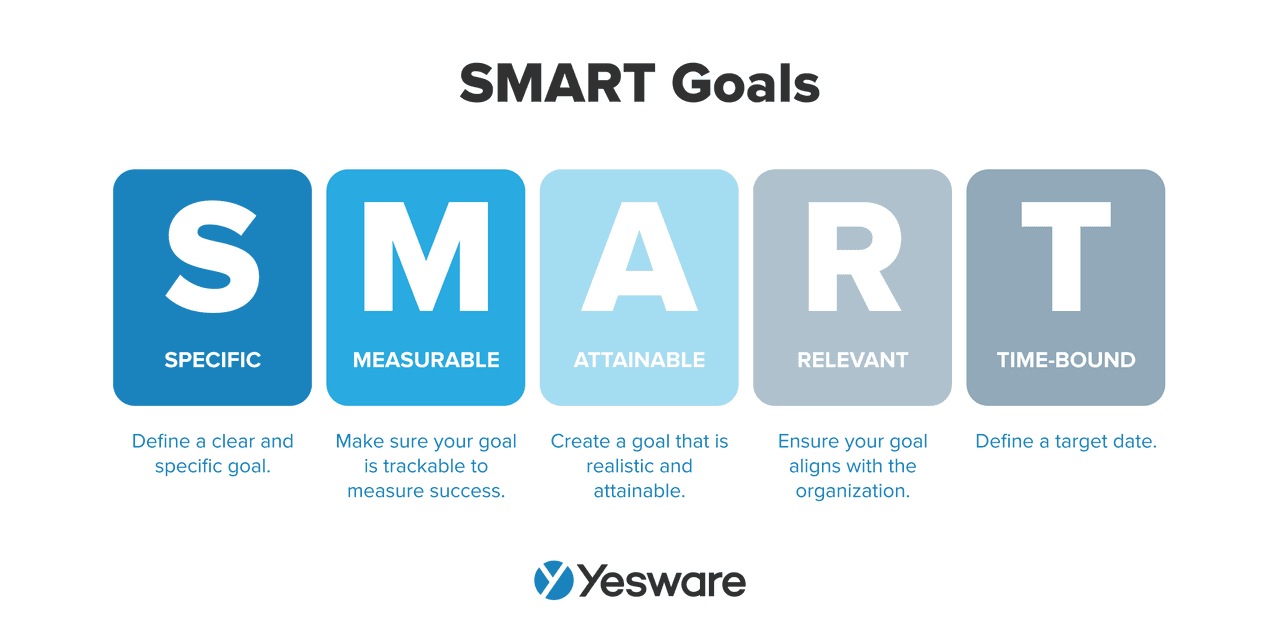
It can be tempting to leave the numbers with the finance department, but financial transparency can go a long way in creating a culture of trust among your sales team.
You don’t need to go through every line item in the spreadsheet, but it’s not a bad idea to include a high-level look at where the dollars are flowing.
KPIs, Metrics, and Benchmarks
Be sure to give your team a snapshot of how they’re currently performing, with real numbers to back it up.
By doing so, you help them self-initiate regular SWOT analysis of their own sales actions and processes. This will give them an opportunity to right the course if things aren’t going according to plan.
Tip: Looking to fuel your sales plan with data-backed findings? Grab our free ebook below.

Remember that your company’s strategic sales plan will be highly unique. It may take some time and tweaking to find the components and format that best meet the needs of your business.
Here are 13 sales plan templates to help you get started.
1. Product Launch Plan Template
Sales and marketing teams create a product launch plan when they’re preparing to launch a new product.
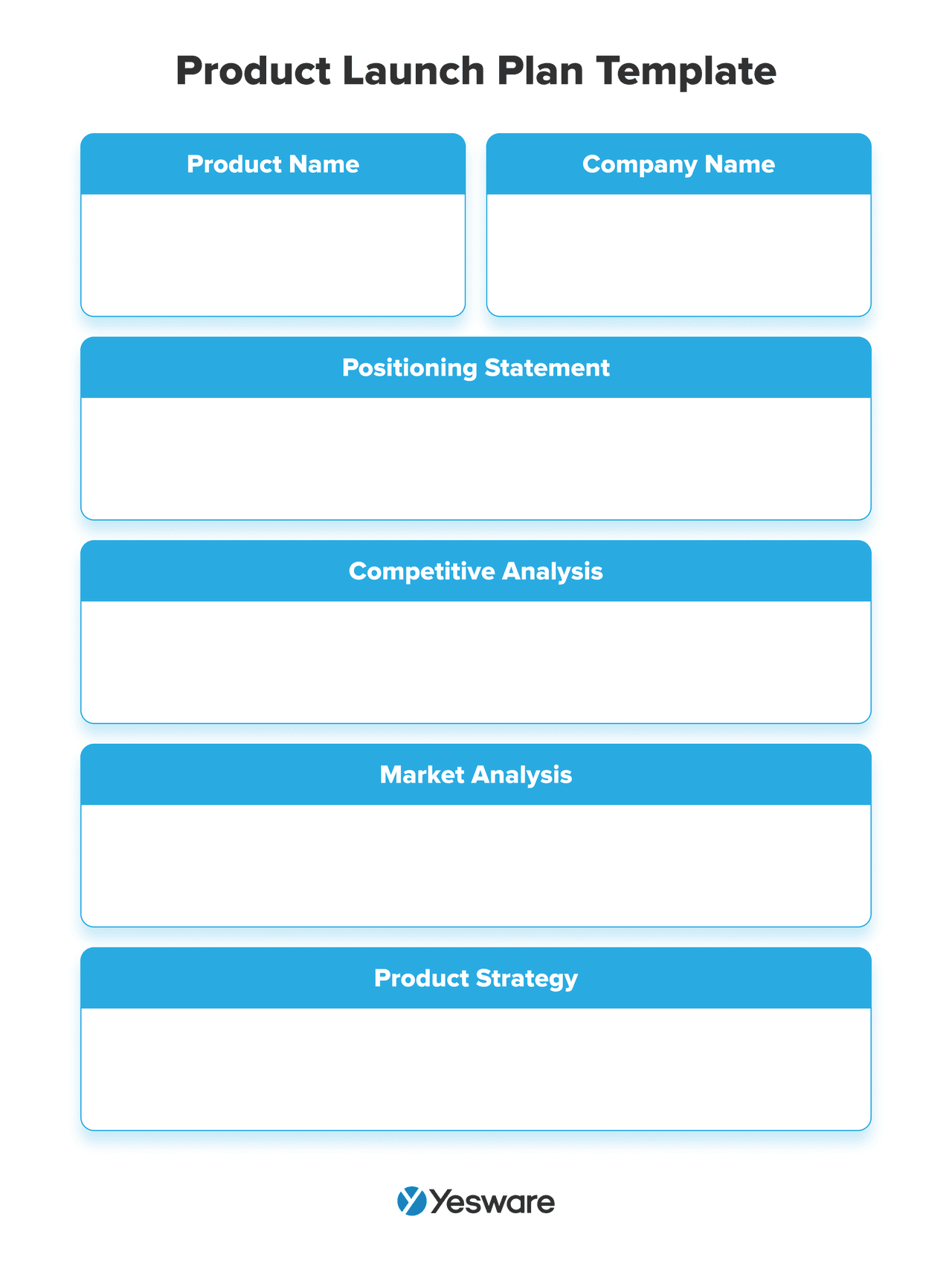
A product launch plan should include your product’s positioning statement, a SWOT competitive analysis, detailed market analysis, sales strategies and tactics, and details about the target market.
2. Ideal Customer Profile Template
One way to avoid wasting time on unproductive leads is to include an ideal customer profile (ICP) in your sales plan. Here’s a sample :
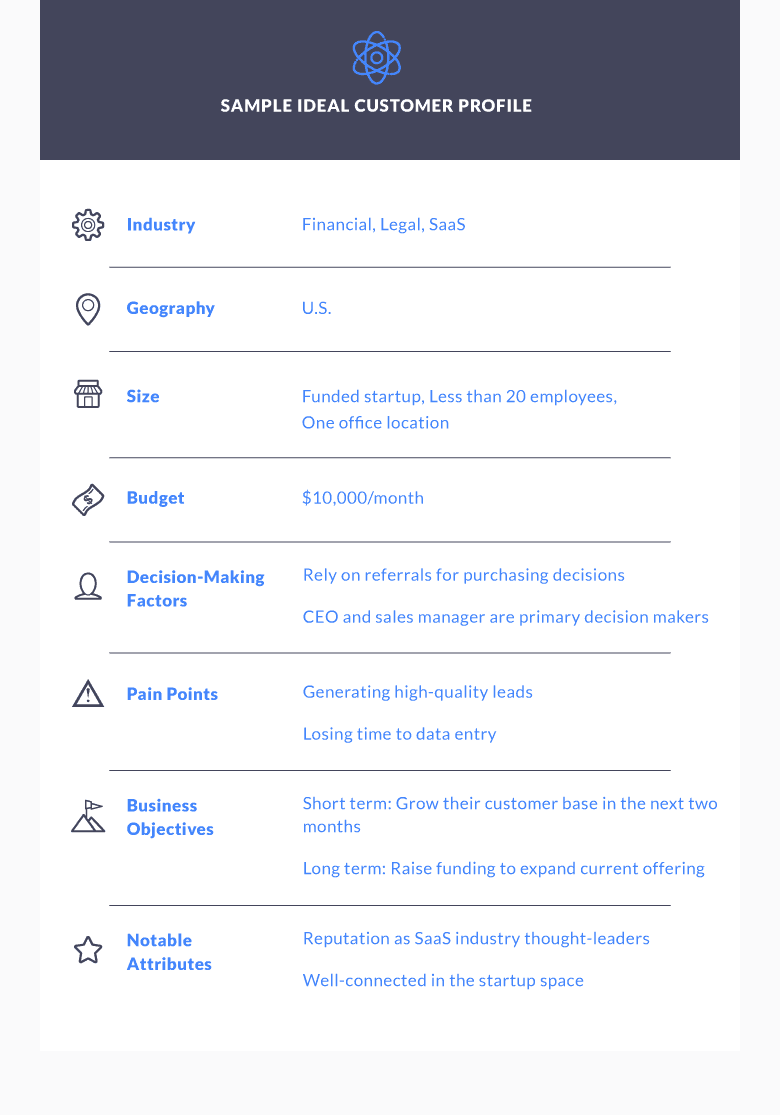
This will help ensure your prospecting campaigns are targeted and attract only the most qualified leads from the get-go.
3. Microsoft Word Sales Plan Template
Here’s a great example of a sales plan goals template , easily accessible through Microsoft Word.
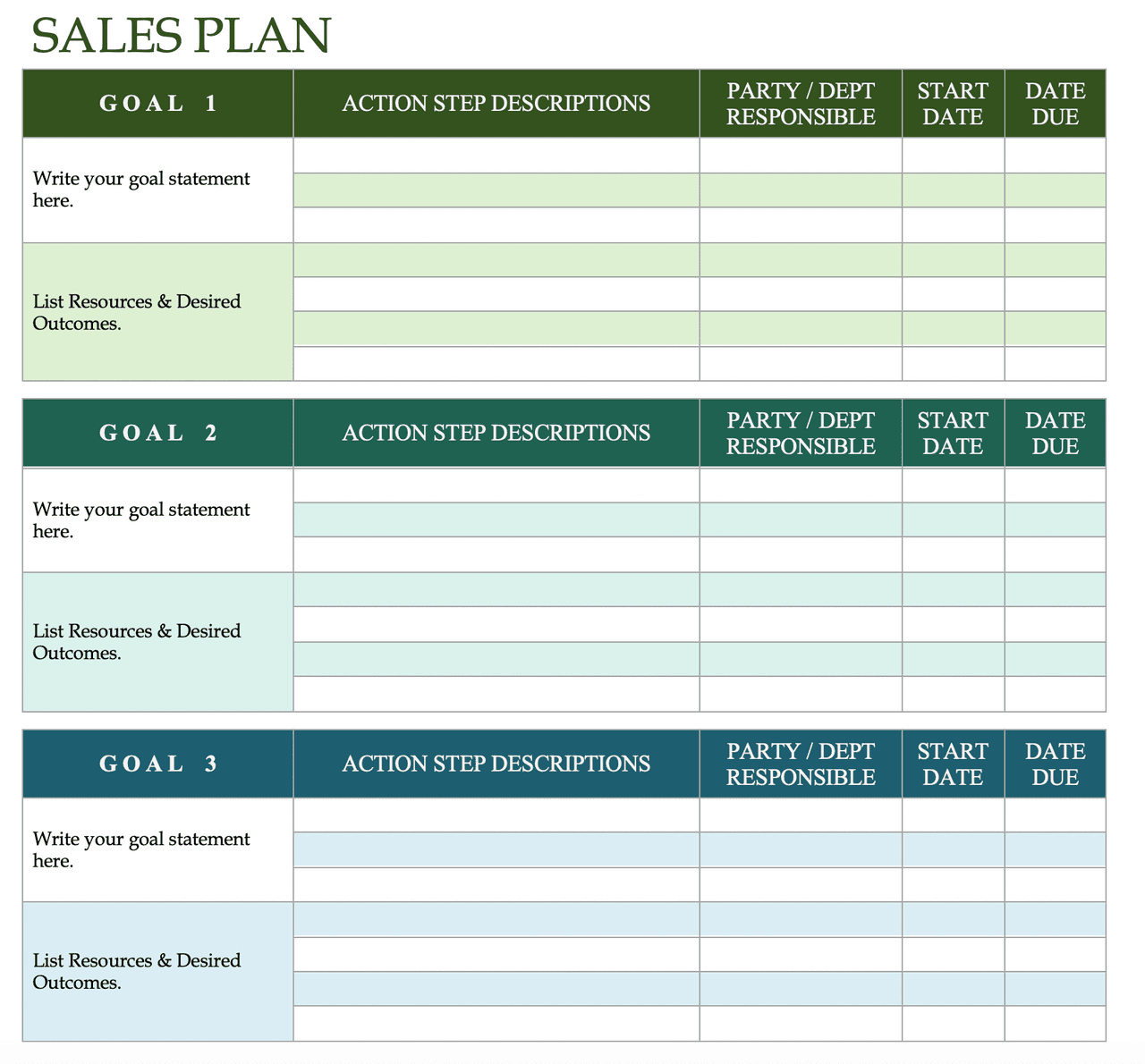
4. 30-60-90 Day Sales Plan Template
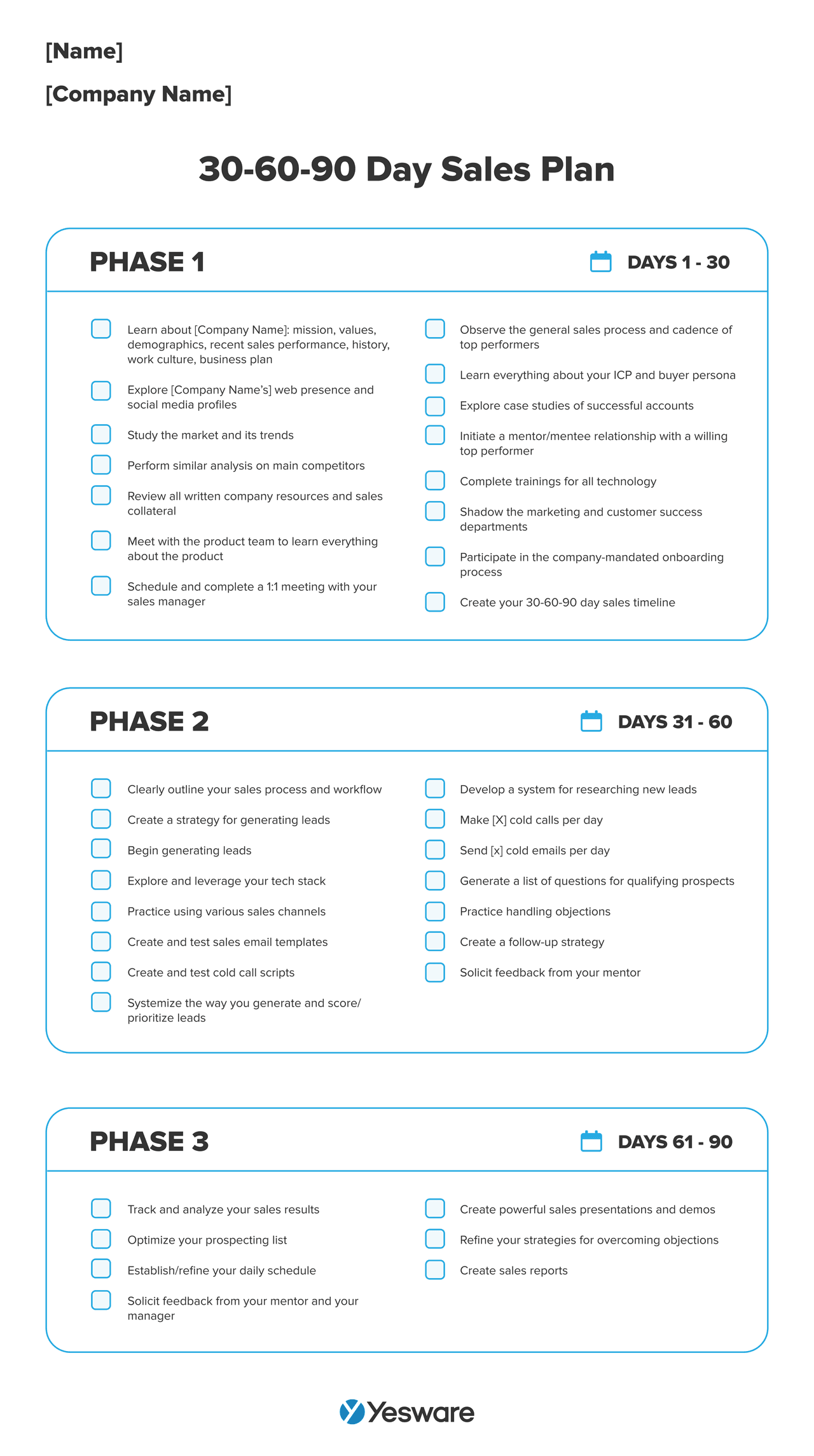
5. Buyer’s Guide Template
A buyer’s guide is a short, simple information sheet that describes your product or service, its features and benefits, and its use. Below is an example of a buyer’s guide from Wayfair .
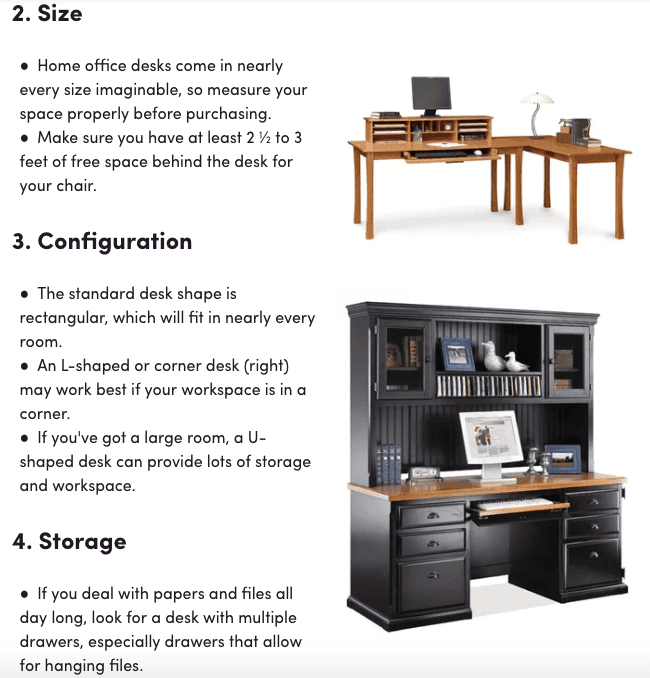
In many cases, this document is as useful internally as it is for the customer.
6. Marketing Alignment Sales Plan Template
If your company hasn’t already formally aligned sales and marketing, start with this type of sales plan template (basic example below), as most traditional sales plans already assume that these two teams collaborate regularly.
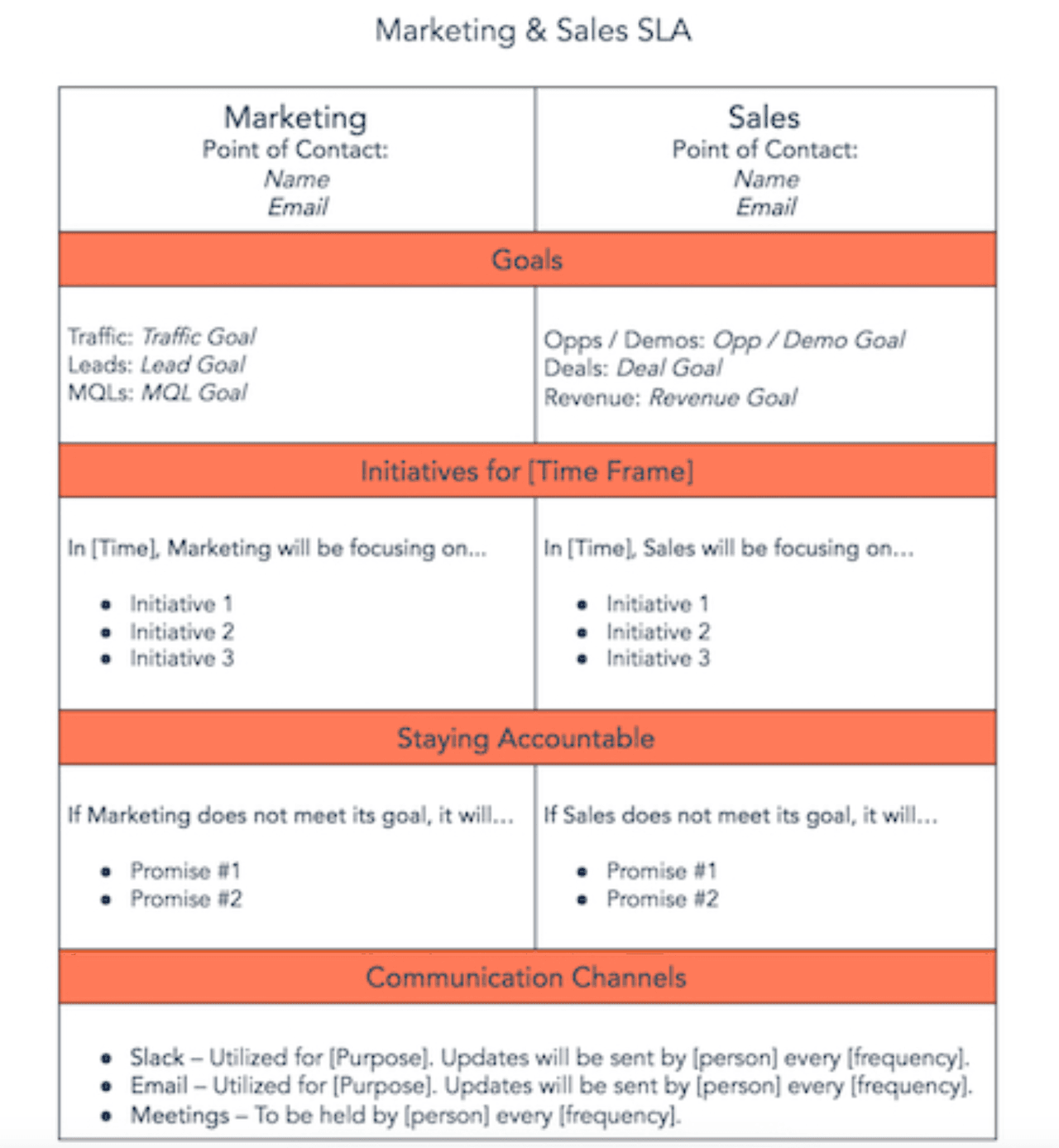
One key component of a marketing alignment sales plan template is the presence of an ideal customer profile and buyer personas.
The marketing alignment sales plan template should also focus on cohesive, on-brand messaging between marketing campaigns and sales conversations .
This type of sales plan template helps keep everyone on the same page, increases efficiency, and improves sales effectiveness.
7. Battle Card Template
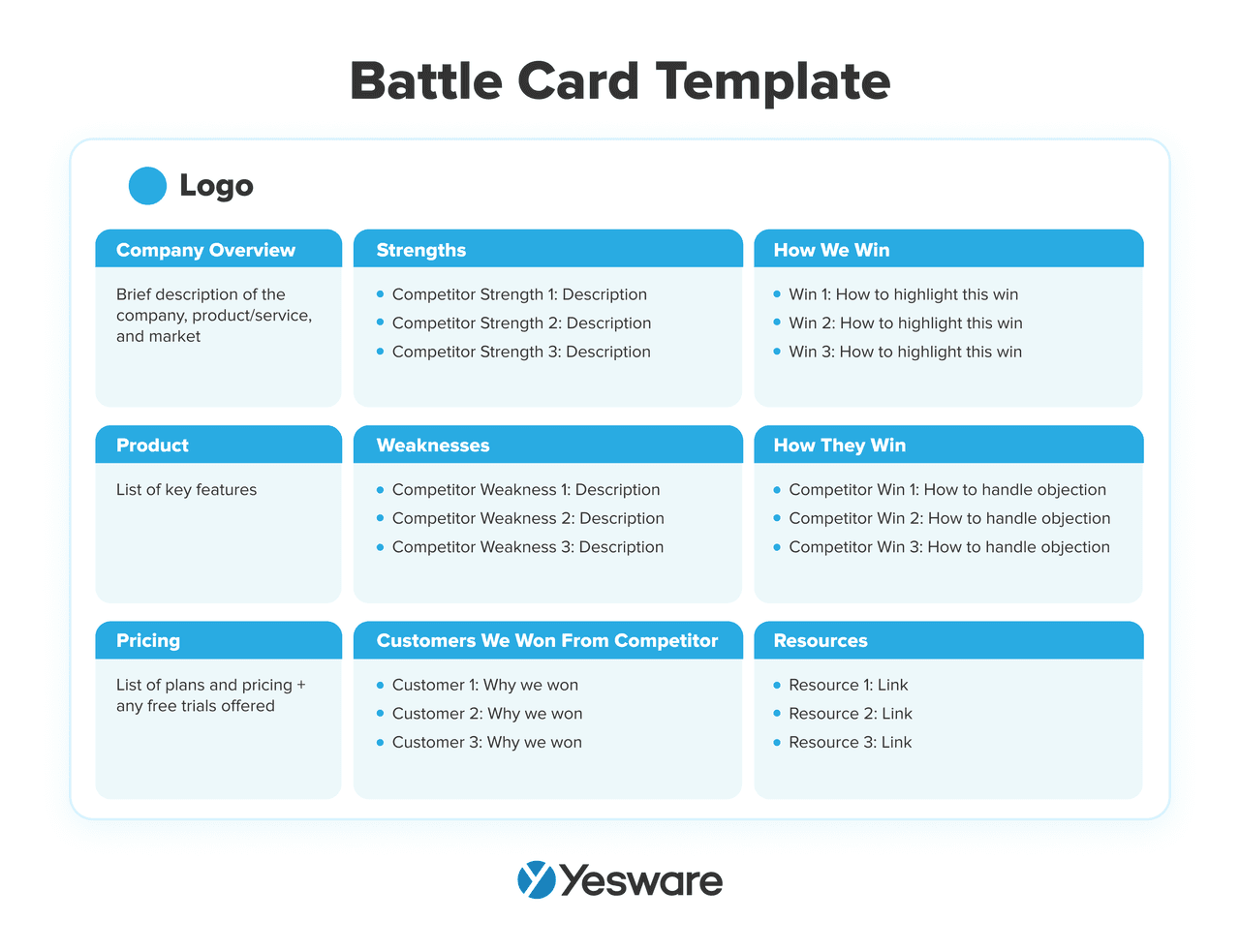
8. Territory Design Template
Well-designed sales territories see a 10% – 20% increase in sales productivity. Be low is a basic example of a territory design map.

9. Market Expansion Plan Template
A market expansion plan outlines the strategies, tactics, metrics, resources, and more that teams will use when expanding into a new market or (more commonly) a new geographical territory.
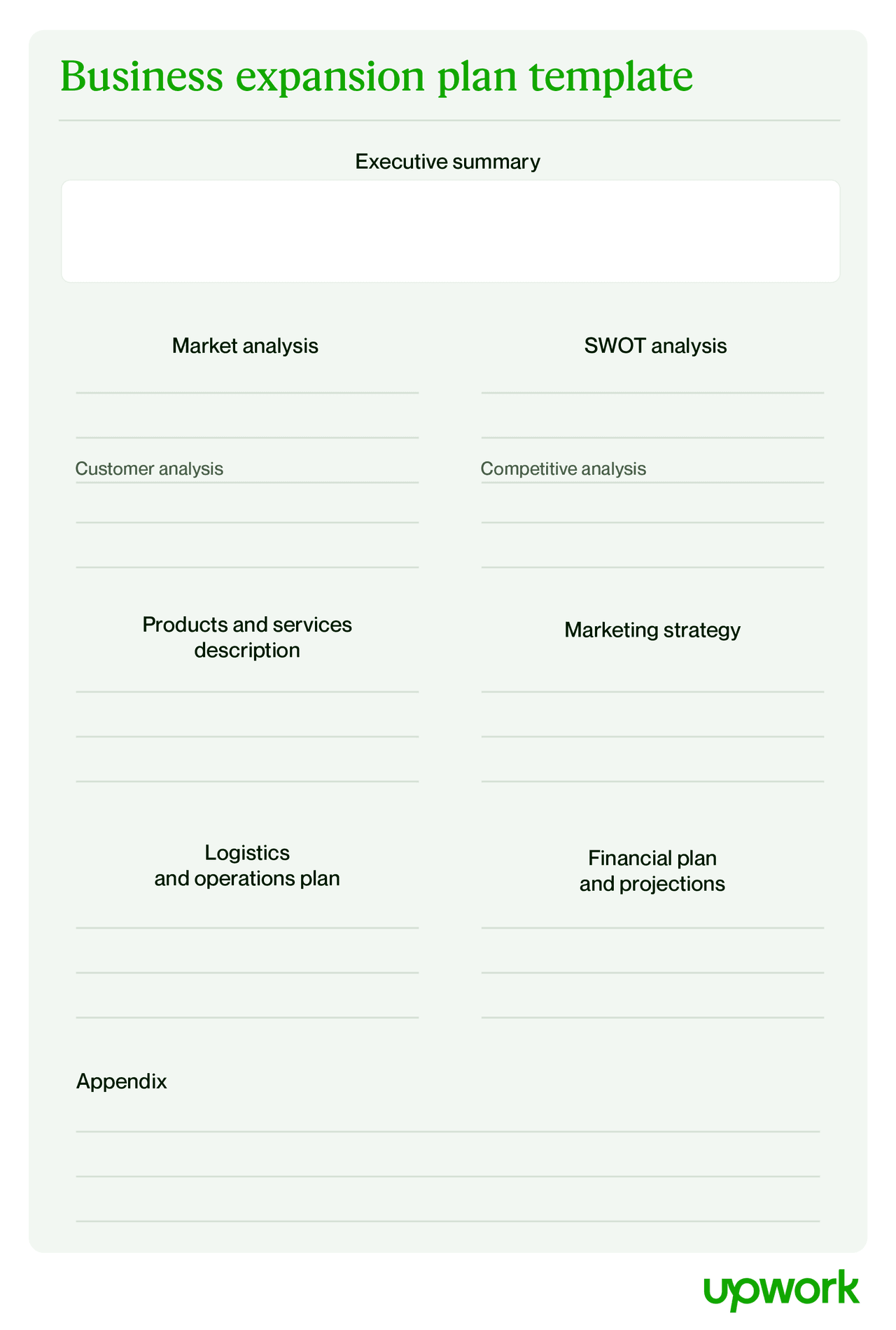
Market expansion plans also need to include details about distribution expenses and timelines, time zone variations, industry notes or important compliance information, local/cultural expectations and laws, and sometimes more.
10. Compensation Plan Template
Your compensation plan (including a specific commission structure) is one way to motivate your sales reps.
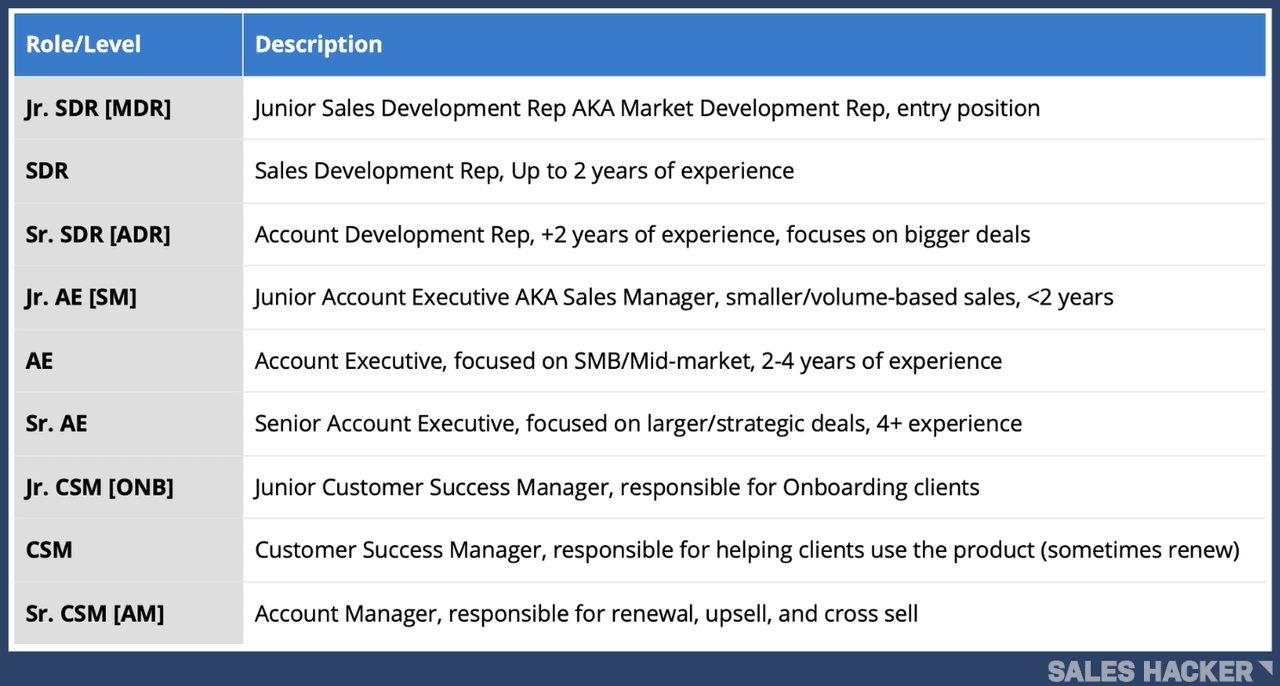
While it may seem controversial or sensitive, the compensation plan is an important component of a strategic sale plan.
11. Sales Funnel Template
The sales funnel is a visual representation of the sales process.
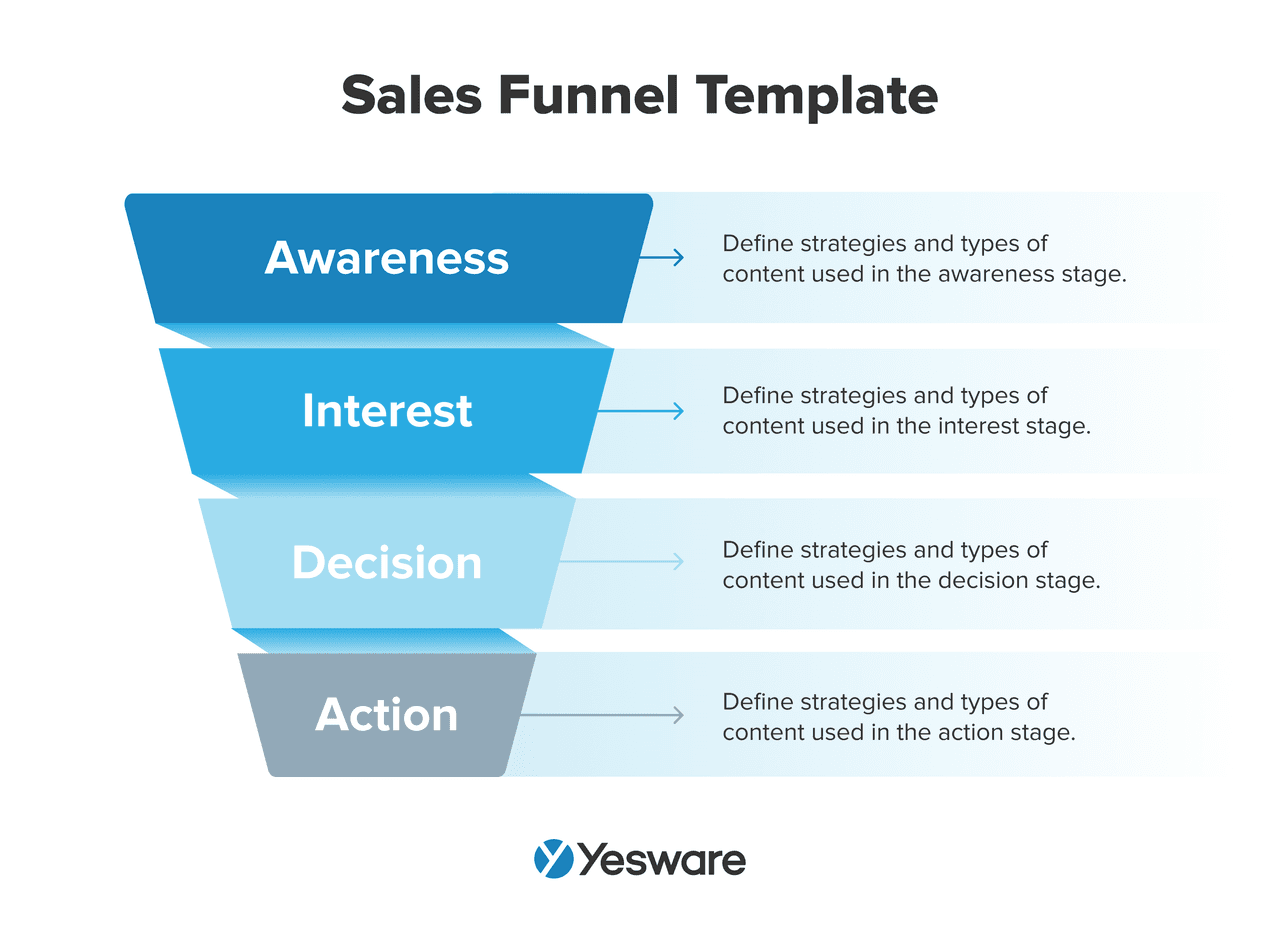
12. Marketing Plan Template
Your salespeople should be extremely familiar with the marketing strategies your company is using to attract new leads. Here’s a great example of a template you can use in your sales plan that outlines the different campaigns at work.
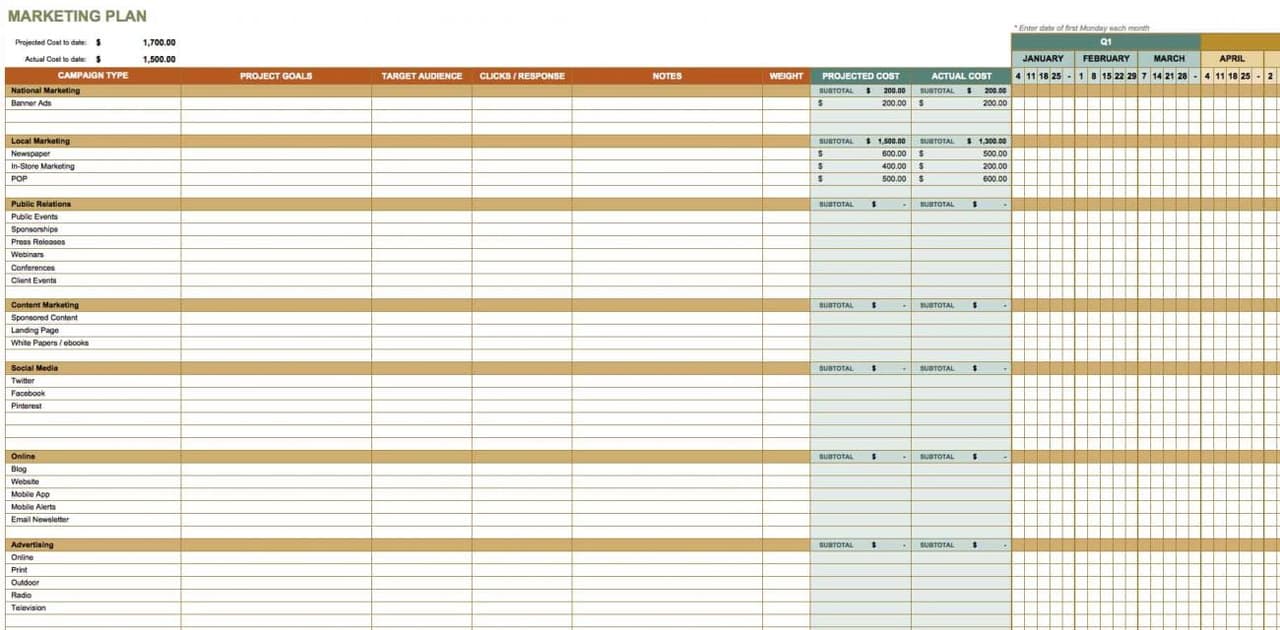
This kind of resource will help your reps know who to contact, when, and with what kind of content throughout the sales cycle .
13. B2B Sales Strategy Template
A B2B sales strategy template helps sales teams outline their goals, as well as the specific methodologies and tactics they will use to achieve them. Here’s an example :
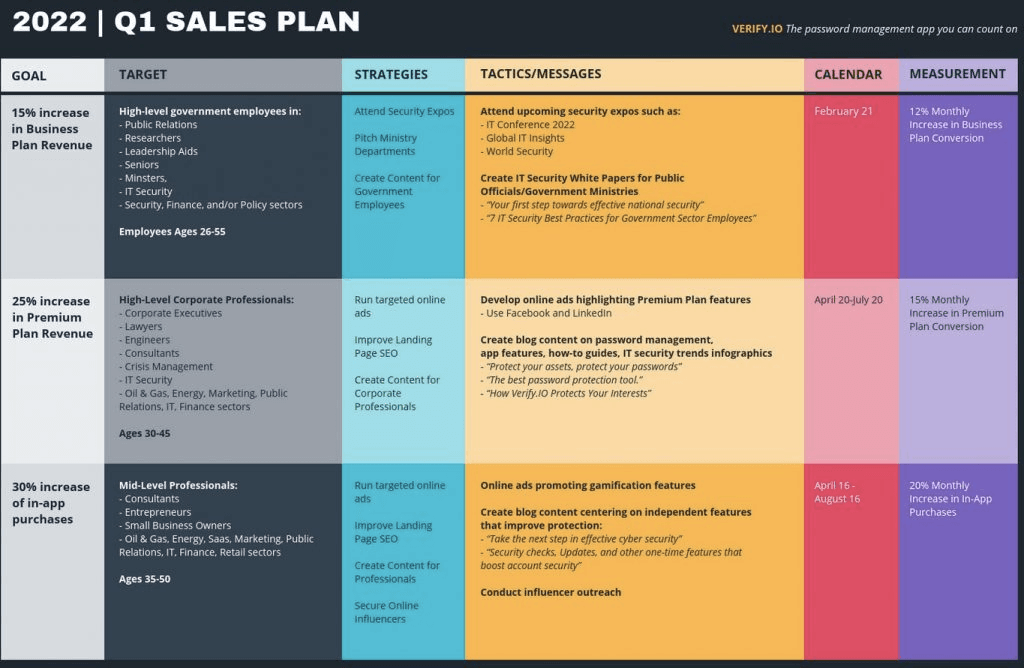
The B2B sales strategy plan will vary widely depending on your team’s specific goals and strategies, but most teams include at least the categories highlighted in the template above.
Yesware is the all-in-one sales toolkit that helps you win more business. It can be an invaluable resource for putting your sales plan into action in a way that’s streamlined, productive, and intuitive.
Communication
Yesware’s meeting scheduler tool helps you skip the back-and-forth when scheduling meetings.
Meeting Scheduler integrates with your Outlook or Gmail calendar and helps your clients automatically schedule meetings with you during times of availability. New events will automatically sync to your calendar.
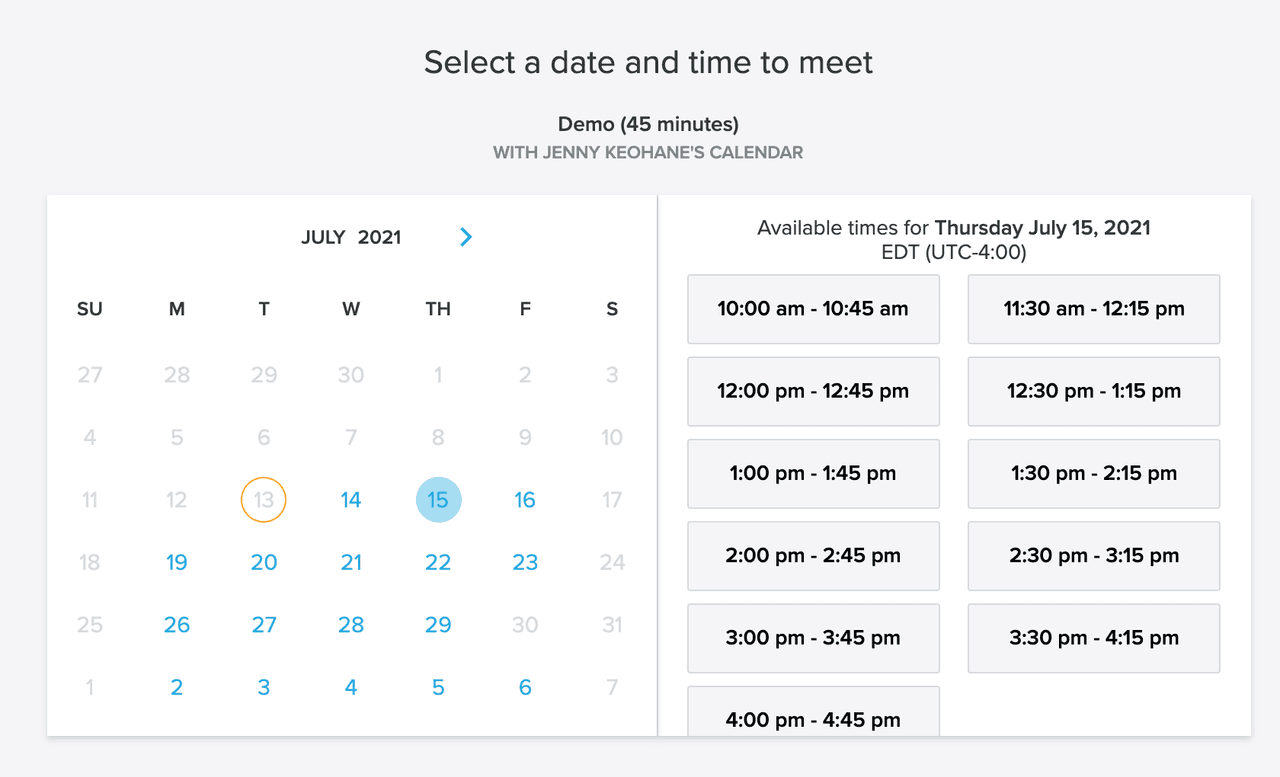
It can also create meeting types for common calls, like a 30-minute intro call or a 60-minute demo call. These templates can be automatically saved and generated with custom descriptions and agendas so everyone can come prepared.
- Prospecting
One of Yesware’s most popular features is its prospecting campaigns .
This feature enables salespeople to create automated, personalized campaigns with multi-channel touches.
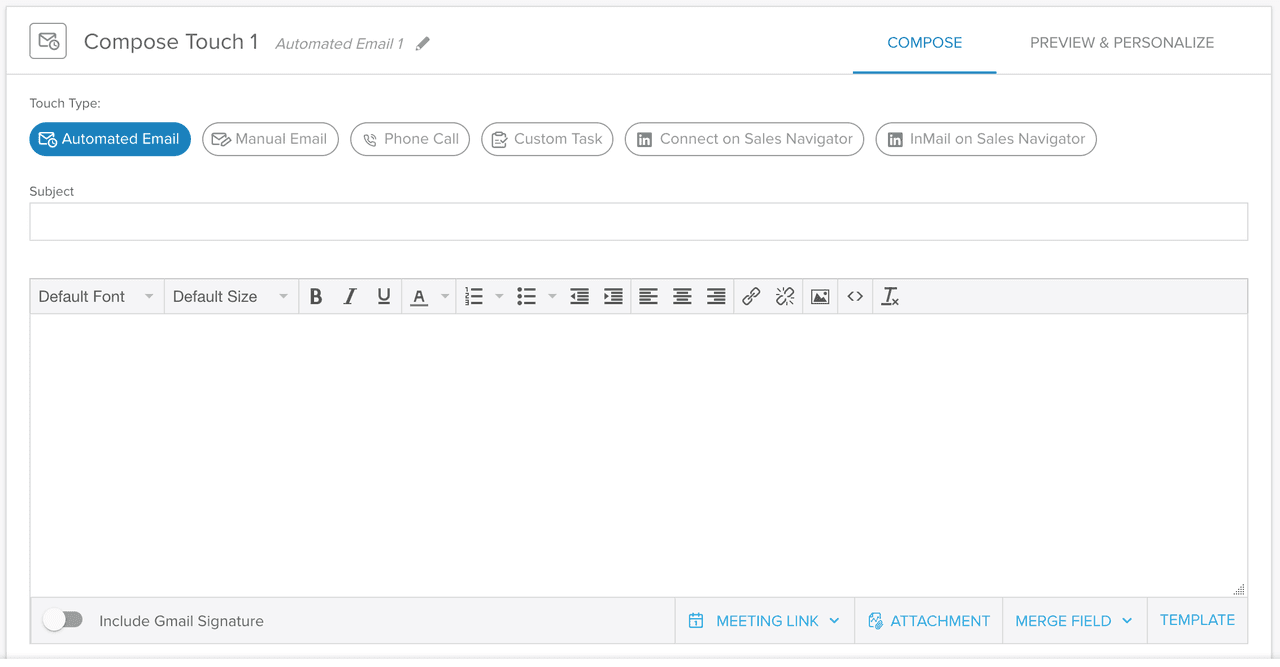
The tool tracks communication and engagement throughout the process and helps move prospects through the pipeline with little administrative effort from the sales team.
Yesware’s attachment tracking feature helps you find your winning content by tracking which attachments are most often opened and read by your prospects.
You can use these insights to sharpen your content and increase your engagement.
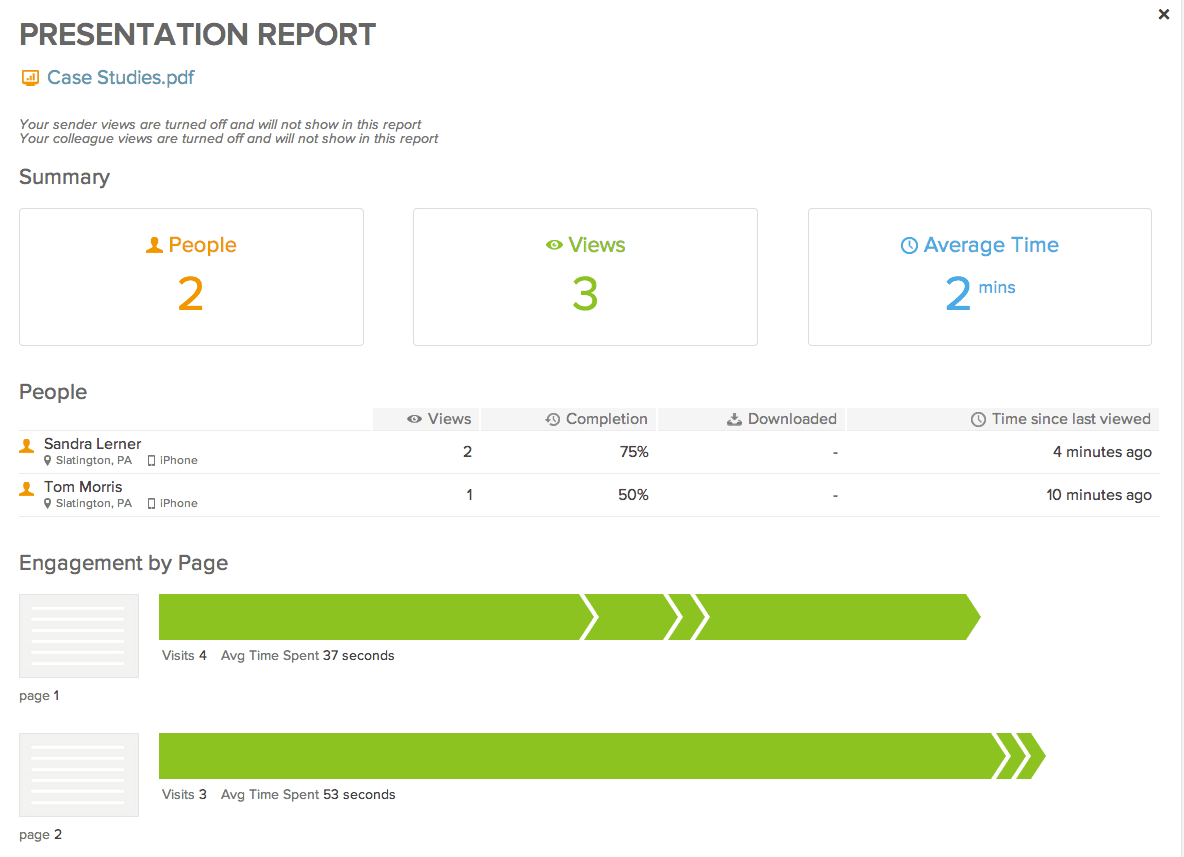
The reporting and analytics tools are also extremely valuable in optimizing your sales plan. These reports enable salespeople to use data to win more business. The feature generates daily activity, engagement data, and outcomes to show you what is/isn’t working across the board.
Try Yesware for free to see how it can help your team carry out your sales plan today.
This guide was updated on March 6, 2024.
Get sales tips and strategies delivered straight to your inbox.
Yesware will help you generate more sales right from your inbox. Try our Outlook add-on or Gmail Chrome extension for free, forever!
Hit your number every month
Works on Outlook or Gmail (+ many more integrations)
Related Articles

12 Proven Sales Approaches to Boost Performance
The 8 Best AI Sales Tools in 2024 to Increase Conversions

Small Business Sales Software for Email Outreach
Sales, deal management, and communication tips for your inbox
We're on a mission to help you build lasting business relationships.
75 Kneeland Street, Floor 15 Boston, MA 02111
[email protected]
What Is A Sales Plan? | How To Create Your Own + Sample Sales Plan Template
Find out what a sales plan is and learn how to create your own sales plan template with this guide.
RELATED: Marketing and Sales: Why They Need Each Other
In this article:
What Is a Sales Plan?
- Who Creates and Benefits from the Sales Plan?
- Why Do You Need a Sales Plan?
- Where Does the Sales Plan Fit Within Your Business?
- When Should You Create and Update Your Sales Plan Template?
- Mission, Vision, and Background
- Goals and Timeline
- Team Members
- Target Market
- Market Position
Sample Sales Plan Template
Other sales plan templates, how to write a sales plan template.
A sales plan is a strategy wherein you lay out your objectives, tactics, potential challenges, and target market . Here, you also identify what steps you’ll execute to meet your objectives.
Typically, a sales plan template has the following parts:
- Target market
- Revenue and/or volume targets
- Deadlines and Directly Responsible Individuals (DRIs)
- Team structure
What Is The Difference Between A Sales Plan And Business Plan?
A business plan describes the financial and operational objectives of a business. A sales plan is similar to a business plan, but it zeros in on the sales strategy.
In other words, a business plan outlines the goals and a sales plan specifies how to reach those goals.
Who Creates a Sales Plan ?
Sales professionals are in charge of creating sales plans. Whatever position you hold, as long as you’re working within sales, it’s essential to be familiar with how to create a sales plan.
Ideally, sales reps should have the task of creating an individual sales plan as part of their training. This will give them an idea of how to write and work with a sales plan template.
Sales executives, sales managers, and entrepreneurs all benefit from having a sales plan. This is a very useful guide for your business, department, or sales team.
Why Do I Need a Sales Plan Template?
Having a sales plan template will help you:
- Identify your business’ sales targets
- Choose sales strategies that fit your target market
- Come up with tactics that will enable your sales team to execute your strategies
- Determine the budget you need for your sales efforts
- Activate and motivate your sales team
- Evaluate your goals regularly so you can improve your approach
Your strategic sales plan will keep your business and your sales team in check. This will also serve as your benchmark to assess your goals and accomplishments.
Perhaps the most important role of a sales plan is to act as your compass in terms of meeting your prospect and customers’ needs.
Where Does the Sales Plan Fit Within a Business?
Your sales plan template can be a part of your marketing plan, or it can also supplement it. As mentioned earlier, a sales plan is similar to a business plan, but it focuses more on strategy.
These three — the business, marketing, and sales plans — all serve the purpose of directing your sales team’s efforts. You map these out during the start of the fiscal year, for instance, and then build on them throughout the year.
When Should I Create and Update My Sales Plan Template?
A lot of businesses develop and improve their sales plan template when necessary. Some do it every 6 or 12 months. Generally, you’ll update your sales plan as new information becomes available. For example, your sales team has expanded or a competitor has left the market. You and your team should treat your sales plan as a live document that you can build and adapt when needed.
RELATED: 7 Ways to Boost Sales Effectiveness
How Do I Create My Own Sales Plan?
All good sales plans have one thing in common, it’s based on real data. Before you create a sales plan do research and collect updated information to base your plan on.
Do a SWOT analysis (strengths, weaknesses, opportunities and threats) to assess your current position and incorporate your findings into your sales plan.
Once you have done your research complete your sales plan with these basic elements:
1. Executive Summary and Scope
Not everyone will read every page of the sales plan. In this section, give an overview of the document.
The aim here is to provide context for your plan. Include the most important goals and strategies as well as the time frame specified in your plan.
2. Goals and Timeline
Next, it’s time to set your sales goals, which could be revenue or volume-based. Make sure you set realistic goals so that in turn, your sales plan is doable.
When goal-setting, you need to factor in the following:
- Product price
- Total addressable market (TAM)
- Market penetration
Most likely, you’ll have more than one goal. The key is to identify which ones are high-level, and which ones will enable you to achieve those high-level goals.
As you prioritize each goal, set a timeline to achieve them. This will let you know if you’re ahead, on track, or behind in meeting targets.
If applicable, identify who the directly responsible individuals (DRIs) are. For instance, set quotas for your individual sales reps so they can all contribute to a common objective.
In some cases, identifying the DRIs will let you avoid replicating work and shifting blame, as each person has a specific task relevant to the goal.
3. Team Members
Enumerate who your team members are and what roles they have. If you’re anticipating to add to that headcount, include the following as well:
- The number of employees you want to add
- Each employee’s job title
- When you plan to onboard them in the team
4. Target Market

Knowing who your target market is for every product or service is crucial. When working on this, imagine what your ideal customer would be like.
While it’s important to have a single buyer persona, be open as well to the possibility of having different buyer personas for each product or service you offer.
Your target market can change over time as your sales strategy and business solutions evolve. As you go along, you’ll eventually learn which market fits a product or service better.
This is why it’s important to be consistent in evaluating and updating your buyer personas.
5. Resources
Your sales plan template should also include the list of resources, tools, and software your sales team will utilize to achieve your goals.
This also means including what your salespeople will use to accomplish their jobs. Some examples of these are training, sales enablement tools, and sales reports , among others.
6. Market Position
In this section, you will list down who your competitors are. Explain here how your offers compare to theirs — both the pros and cons.
You should include the pricing comparison between you and your competitors as well. Also, don’t forget to discuss the current trends in the market, and try to predict what kind of impact they will have on your business.
7. Marketing Strategy
Here you will dive further on two marketing mix elements — price and promotion. Describe your pricing strategy and go into detail on the promotions you’re planning to run.
What tactics will you implement to increase awareness for your brand and to generate leads? While you digest on this, don’t forget to figure out how this will impact your sales.
8. Prospecting

What will be your strategy when it comes to prospecting ? List down the criteria that your sales reps need to look for in leads and prospects before they reach out.
Along with this, you should also identify the sales methods your sales team will employ to close more deals.
You now have your goals, so it’s time to come up with action plans that will help you reach them. This is basically your game plan to hit the revenue targets you set.
To create an action plan, follow this simple process:
- Set an objective
- List down the tasks that will help you accomplish the objective
Lay out the costs that will come with hitting your sales goals. To make sure that your sales plan budget is accurate, compare it with your sales forecast.
Tips To Keep In Mind When Writing Your Sales Plan
- Set practical and reasonable goals.
- Look at historical performance data to help set achievable targets.
- Do in-depth research and use this to identify problems and opportunities.
- Get input from your sales team.
- Be specific and concise.
- Don’t forget to monitor the progress of your sales plan. Your plan should adapt and evolve to fit the current situation (Unexpected changes in the market, new sales members etc.)
Here’s a handy sales plan template based on the elements mentioned above. Fill in each part as a starting point in creating your own template.
Name of Company:
Prepared by:
I. Executive Summary and Scope
Write 3-4 lines to summarize the rest of the document.
II. Goals and Timeline
Sample Sales Goals and Timeline
- April 2020: $10,000
- May 2020 $10,000
- June 2020: $12,000
III. Team Members
- Name — job title
Describe the role, including tasks and expectations. Also, include information about onboarding.
IV. Target Market
Buyer Persona
Thoroughly describe who this person is — basic demographics, what their lifestyle is like, interests, etc.
V. Resources
Make a list of resources, tools, and software employees need to perform their tasks and for the team to achieve the sales goals
VI. Market Position
Competitors
Similarities and Differences Between Products/Services
Pricing Comparison
Current Market Situation
Include information about any market or industry trends that may impact you or your competitors.
VII. Marketing Strategy
Sample Pricing and Promotional Strategy:
- Pricing Strategy: Lower price from $500 to $450 on June 1.
- Sales Impact: Increase monthly sales by 10%
- Promotional Strategy: Run a customer referral incentive from June 15-30.
- Sales Impact: Increase monthly sales by 15%.
VIII. Prospecting
Identify sales methods reps will use to close deals.
Criteria to Qualify Leads:
IX. Action Plan
Objective #1:
Sample Costs:
- Salary/Commission
- Sales Tools and Resources
- Travel Expenses
If you’re stuck with your own sales plan template, try going by any of these templates:
- One-Page Sales Plan by The Balance
- Free Sales Plan Template by Fit Small Business
There is no one-size-fits-all sales plan. Take your time to identify opportunities and ways to overcome challenges.
Lastly, remember to monitor your progress and to update your strategic sales plan to optimize performance.
What challenges do you experience when creating a sales plan? Tell us in the comments section below!
- 7 Sales Techniques That Actually Work
- Asking Questions in Sales — What You Need to Know
- 6 Sales Motivation Secrets so Simple Even a Caveman Can Use Them

Researched by Consultants from Top-Tier Management Companies

Powerpoint Templates
Icon Bundle
Kpi Dashboard
Professional
Swot Analysis
Gantt Chart
Business Proposal
Marketing Plan
Project Management
Business Case
Business Model
Cyber Security
Business PPT
Digital Marketing
Digital Transformation
Human Resources
Product Management
Artificial Intelligence
Company Profile
Acknowledgement PPT
PPT Presentation
Reports Brochures
One Page Pitch
Interview PPT
All Categories
Top 10 Sales Business Plan Templates with Examples and Samples

Taranjeet Singh
A well-crafted sales business plan is essential for any company that wants to succeed. But creating a great sales plan can be time-consuming and challenging. That's where sales business plan templates come in.
Sales business plan templates provide a pre-made framework that you can design according to your plan and thus saving you time and effort. Furthermore, it helps you ensure that your plan is comprehensive and well-organized.
The best business plan ppt are 100% editable and customizable. Change the images, colors, and text to match your company's branding. You can also add or remove slides as needed.
If your requirement is to create a great sales business plan, then a sales business plan template is the perfect solution.
With the below-mentioned templates, you can quickly and easily build a plan to help you achieve your sales goals.
Let’s begin!
Template 1: Sales Plan Presentation Template
This content-ready PPT template focuses on helping businesses decide their mission, drive business growth, and cultivate repeat customers. This concise and informative PowerPoint presentation is designed to equip your sales team with necessary skills and knowledge to elevate your company’s growth. It provides you with valuable insights and strategies for achieving sales objectives, capturing new markets, and fostering customer loyalty. Elevate your sales approach with this dynamic presentation, available for download to maximize your business potential.

Download Now!
Template 2: Sale Action Plan PPT
Experience the transformative potential of our ready to use PowerPoint slide. This meticulously crafted presentation is your key to unlocking sales success. With in-depth market analysis and strategic insights, it equips you with the required tools to optimize your advertising campaigns to make sales. Seamlessly navigate market trends and consumer behavior to enhance your brand's impact. To access this invaluable resource and drive your business forward, download our PPT. Embrace the power of data-driven decision-making and elevate your sales performance.

Template 3: Sales Strategy Plan PPT
Introducing our professional and appealing curated PowerPoint template. This is a top-notch PowerPoint template to you effectively outline and convey your sales strategy. With a visually captivating layout and content that effortlessly highlights your market analysis, target audience, competitive advantages, and action plans, leave a lasting impression on your audience. Unlock the power of persuasive presentations and grow your business to unparalleled heights. Download now!

Template 4: Sales and Marketing Plan for Business Growth PPT
This PPT delves into crucial topics of sales such as, goals, targets, strategies, measurement, and tactics. This dynamic presentation provides you with a roadmap to propel your business toward success. By defining clear objectives, identifying the target audience, devising practical strategies, measuring performance, and implementing tactical approaches, this plan ensures a comprehensive approach to sales and marketing. Download this insightful resource now to gain valuable insights and actionable steps to accelerate your business growth.
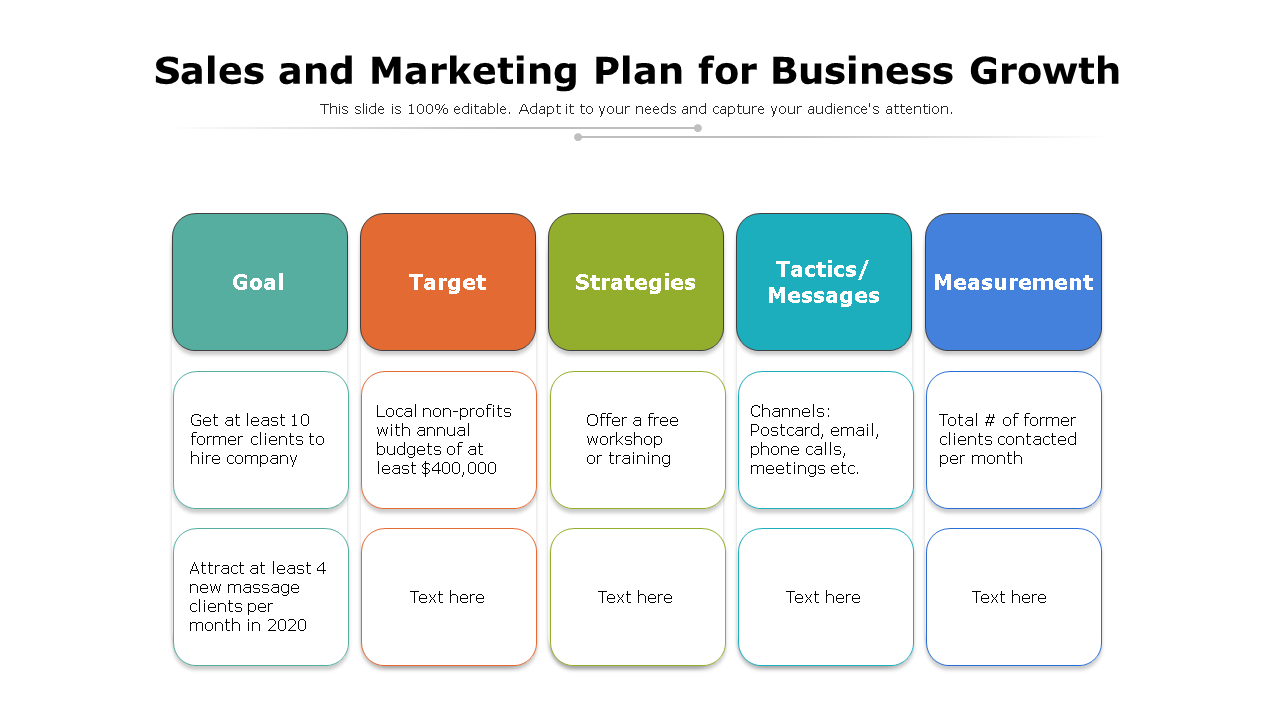
Template 5: Business Sales Growth Strategy Plan Model PPT
Leverage the power of our PPT, covering key topics such as products, strategy, customers, geographical segments, and distribution channels. It consists of different segments and tools to help you identify growth opportunities, develop strategies to capture them, and track your progress. It is a valuable resource if you want to increase your sales. Download this template today and embrace the path to sustainable growth.
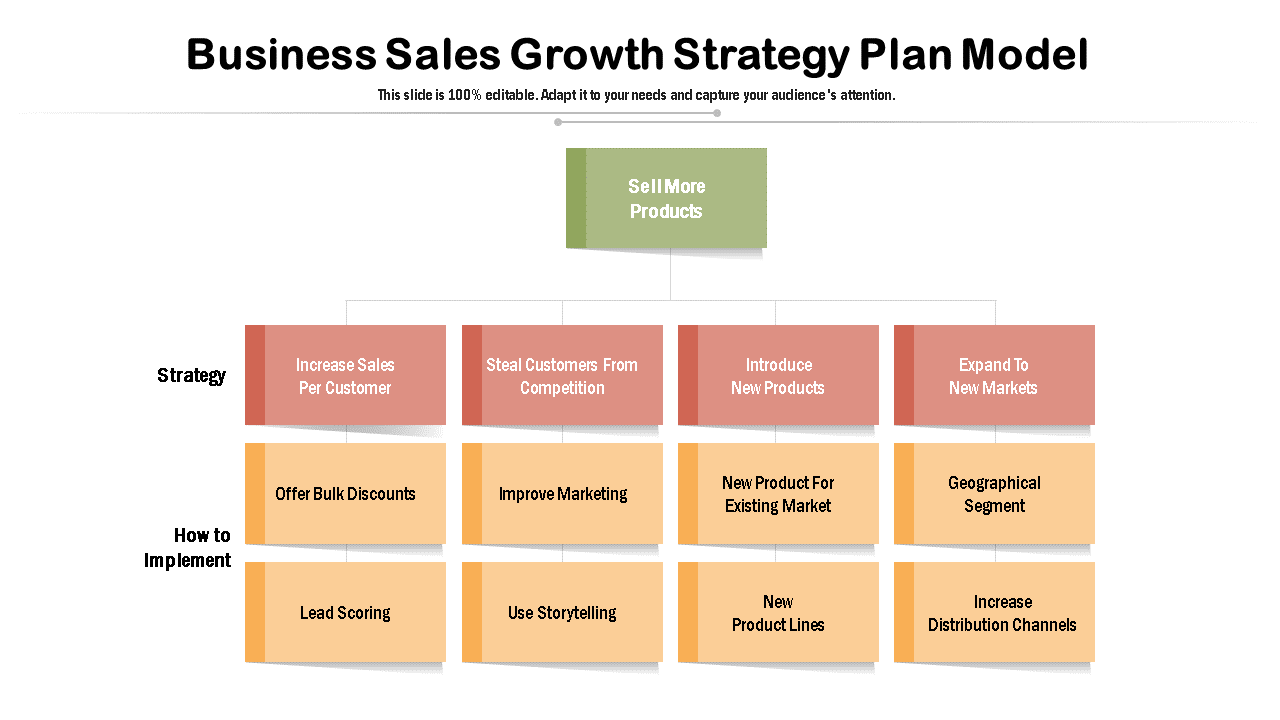
Template 6: Sales Strategy of Business Plan PPT
This is a content-ready PowerPoint template exhibiting six-stage process to optimize your sales approach. With visually captivating graphics and intuitive design, showcase different stages of sales, including its process and strategy, market knowledge, science metrics, sales excellence and performance, sales skills, and customer knowledge. This actionable PPT slide empowers you to present your sales strategy with precision and impact. Enhance your presentations today and achieve sales success by deploying this PPT.

Template 7: Sales Strategy Business Plan Template
Designed by our experts, this professional and visually appealing template offers a streamlined six-stage process to guide you through your sales strategy. Whether you're focusing on marketing, channels, advertising, collateral, or training, this template has got you covered. Its clean & modern design makes it perfect for showcasing your business plan to your clients or team members. Grab this powerful PPT today.
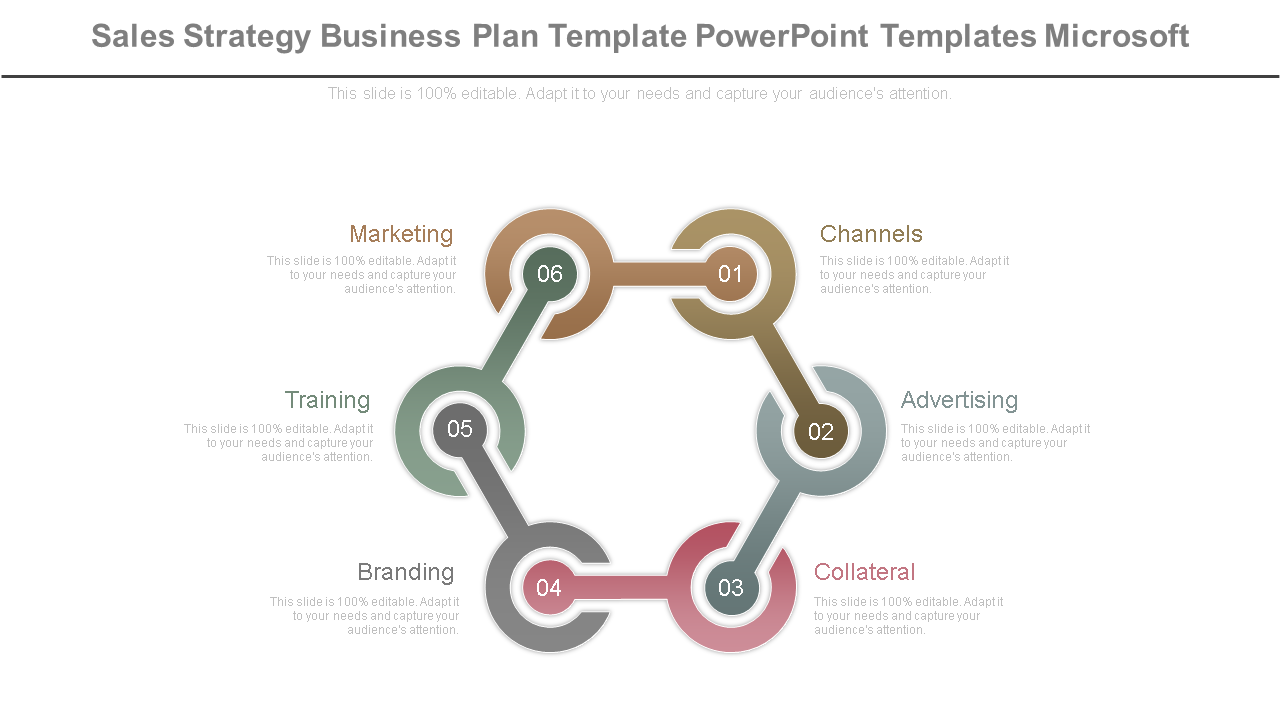
Template 8: Strategic Sales Growth Action Plan PPT
This comprehensive presentation showcases a roadmap for success, emphasizing the key components necessary to reach new customers and expand into untapped markets. With estimated cost analysis, projected sales figures, actionable steps, and achievable targets, this PPT provides you the blueprint for sales growth. Deploy this PowerPoint slide now to to unleash your organization's potential for unparalleled success. It's time to seize opportunities and fuel exponential growth in the competitive business landscape.
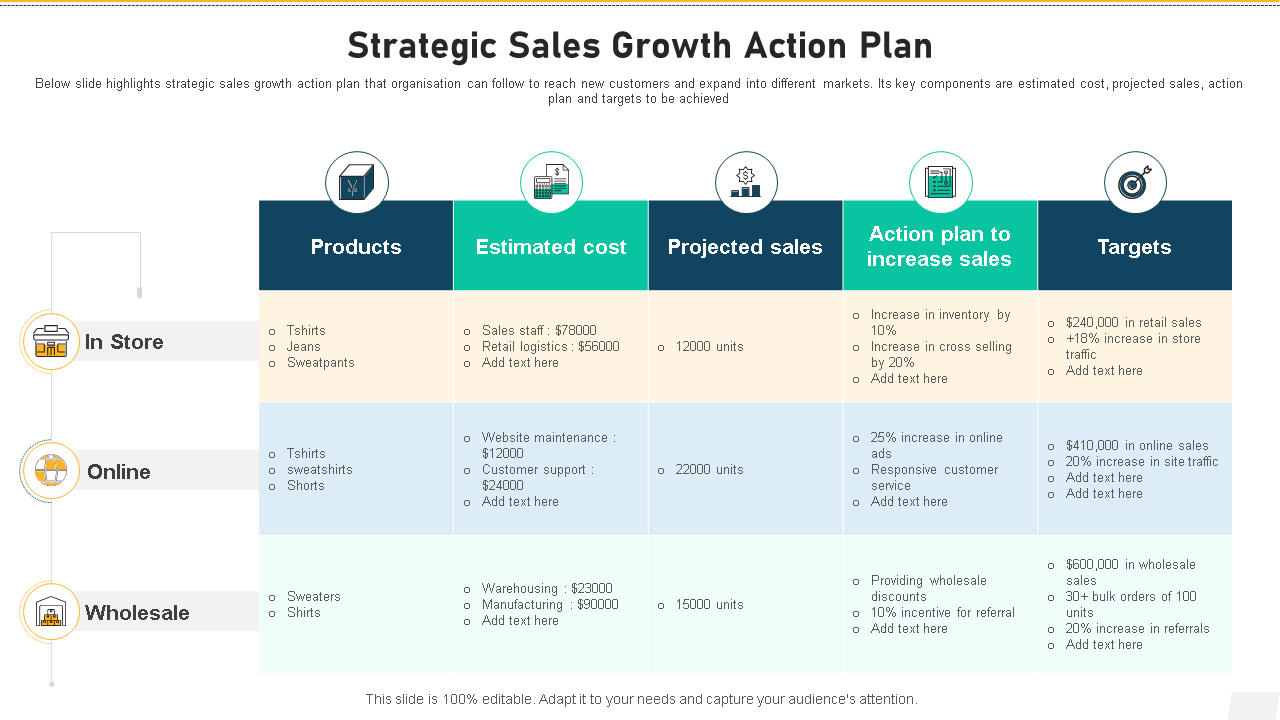
Template 9: Framework of Business Plan for Sales Growth PPT
Achieving substantial sales growth requires a well-structured business plan. This content-ready PowerPoint presentation outlines critical components essential for success. It covers vital topics, such as, business strategy, sales strategy, resource development, technology, and sales operations. Discover strategic approaches to optimize your business's growth potential and enhance sales effectiveness. Unlock valuable insights and actionable steps to drive revenue and maximize profitability. To access this informative presentation, download it now.
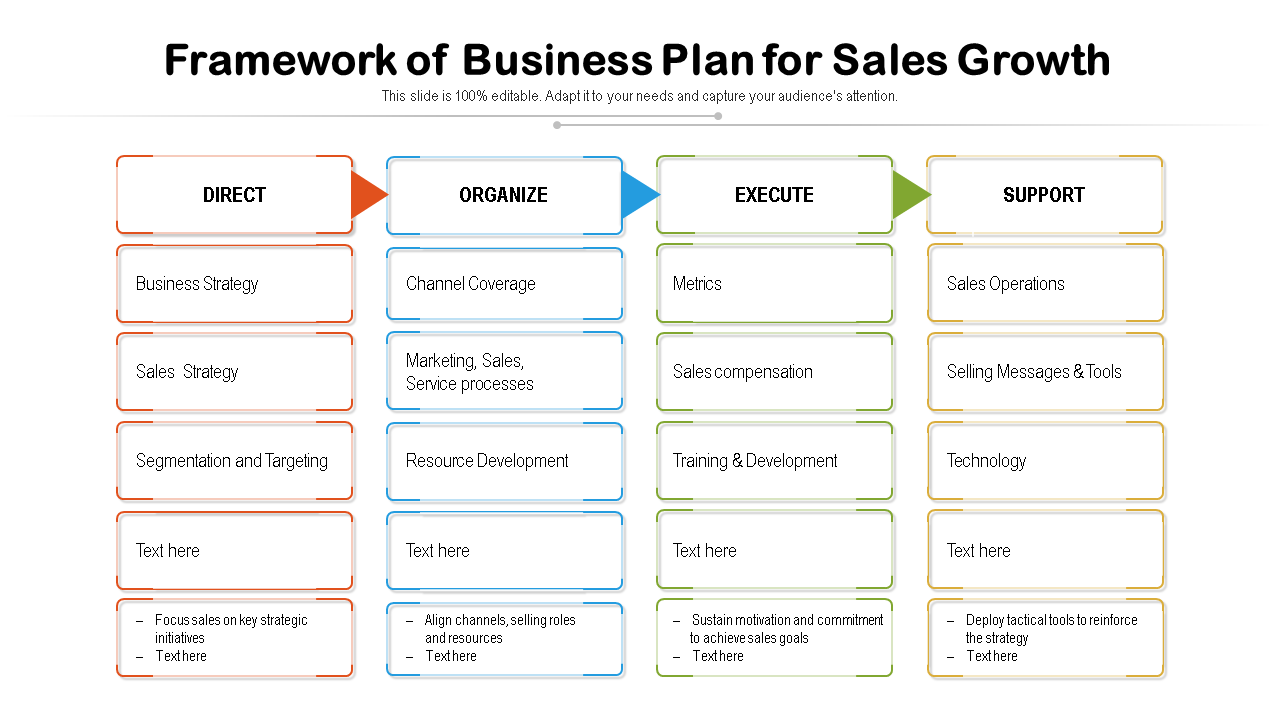
Template 10: Key Sales Action Plans for Business Growth Template
This ready to use template is designed to help you drive success and achieve exponential growth. Focusing on strengthening and developing your sales strategies covers essential stages such as planning, budgeting, expenses, and revenues. Harness the well-crafted sales plan and unlock your business's full potential. Download this invaluable resource to transform your sales approach and propel your organization toward unprecedented success.
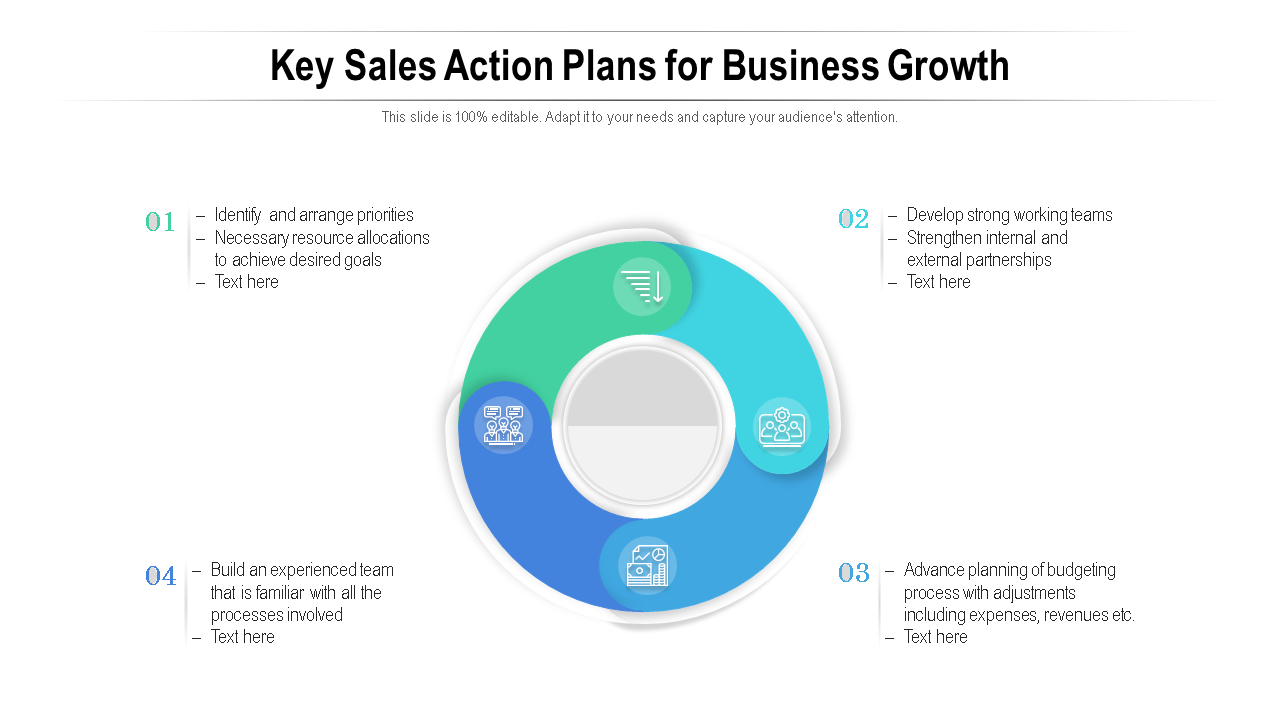
A well-crafted sales business plan is a critical component for any organization looking to thrive in the market. By outlining clear objectives, strategies, and tactics, it provides a roadmap for success and empowers businesses to effectively navigate challenges, capitalize on opportunities, and achieve sustainable growth. Therefore, SlideTeam brings you a collection of content-ready and custom-made PPT templates as a valuable tool for organizations seeking to achieve their revenue targets and drive growth. Deploy these premium slides for setting goals, defining strategies, and implementing effective sales tactics. With careful execution and adaptation, the sales business plan template becomes a roadmap to sustainable sales success.
FAQs on Sales Plan
What is a sales business plan.
A sales business plan is a strategic document that outlines the objectives, strategies, and tactics a company will employ to achieve its sales targets and generate revenue. It serves as a roadmap for the sales team, providing a clear direction and structure to follow. A well-crafted sales business plan includes thorough market analysis, target customer identification, sales goals, budgeting, and sales forecasting. It also outlines the sales strategies, such as pricing, promotional activities, distribution channels, and customer relationship management. A sales business plan is a blueprint for success, helping businesses align their efforts and maximize their sales potential.
How Do I Write a Sales Business Plan?
Writing a sales business plan requires careful consideration and attention to detail. Here are essential steps to guide you:
- Define objectives: Clearly state your sales goals and desired outcomes.
- Conduct market analysis: Understand your target market, competitors, and industry trends.
- Identify target customers: Define your ideal customers and their needs.
- Develop sales strategies: Outline lead generation, customer acquisition, and retention tactics.
- Set sales targets: Establish measurable and achievable sales objectives.
- Create a budget: Allocate resources for sales activities, marketing, and sales team development.
- Develop a sales forecast: Estimate sales projections based on market analysis and historical data.
- Define sales processes: Detail the steps involved in the sales cycle and align them with the customer journey.
- Monitor and evaluate: Establish key performance indicators and review progress regularly.
- Adapt and refine: Continuously refine your plan based on feedback and market dynamics.
What are the 4 Common Sales Strategies?
Four common sales strategies used by businesses are:
- Consultative Selling : This approach builds solid customer relationships and understands their needs. Salespeople act as consultants, providing personalized solutions and guidance.
- Solution Selling : This strategy involves identifying customer pain points and offering tailored solutions. It requires understanding the customer's business and aligning product/service features with their needs.
- Relationship Selling : This strategy centres around developing long-term relationships with customers. Salespeople focus on building trust, providing exceptional customer service, and nurturing ongoing partnerships.
- Social Selling : With the coming of social media, this strategy leverages platforms like LinkedIn and Twitter to connect with customers, share relevant content, and engage in conversations that can lead to sales opportunities.
Businesses can effectively engage customers, differentiate themselves, and drive revenue growth by employing these sales strategies.
Why is a Sales Plan Important?
A sales plan is crucial for the success of a business for several reasons. Firstly, it provides the sales team with a clear roadmap and direction, ensuring everyone is aligned and working towards common goals. It helps set realistic sales targets and objectives, allowing businesses to measure progress and make necessary adjustments. A sale plan also aids in identifying and understanding the target market and customers, enabling businesses to tailor their sales strategies and approaches accordingly. Moreover, it assists in allocating resources effectively, optimizing budgeting and forecasting, and maximizing sales opportunities. A well-defined sale plan ultimately increases the chances of achieving sales targets, driving revenue growth, and outperforming competitors.
Related posts:
- Top 7 Sales Activity Report Templates with Examples and Samples
- [Updated 2023] Top 10 Business Strategy Google Slides Templates To Empower Your Team
- Top 10 Performance Metrics Samples with Templates and Examples
- Top 7 Sales Projection Templates with Examples and Samples
Liked this blog? Please recommend us

Must-Have Sales Brochure Templates With Samples And Examples

Top 10 Sales Best Practices Playbook Templates with Samples and Examples
This form is protected by reCAPTCHA - the Google Privacy Policy and Terms of Service apply.

Digital revolution powerpoint presentation slides

Sales funnel results presentation layouts
3d men joinning circular jigsaw puzzles ppt graphics icons

Business Strategic Planning Template For Organizations Powerpoint Presentation Slides

Future plan powerpoint template slide

Project Management Team Powerpoint Presentation Slides

Brand marketing powerpoint presentation slides

Launching a new service powerpoint presentation with slides go to market

Agenda powerpoint slide show

Four key metrics donut chart with percentage

Engineering and technology ppt inspiration example introduction continuous process improvement

Meet our team representing in circular format

24 of My Favorite Sample Business Plans & Examples For Your Inspiration
Published: February 06, 2024
I believe that reading sample business plans is essential when writing your own.

hbspt.cta._relativeUrls=true;hbspt.cta.load(53, 'e9d2eacb-6b01-423a-bf7a-19d42ba77eaa', {"useNewLoader":"true","region":"na1"});
As you explore business plan examples from real companies and brands, it’s easier for you to learn how to write a good one.
But what does a good business plan look like? And how do you write one that’s both viable and convincing. I’ll walk you through the ideal business plan format along with some examples to help you get started.
Business Plan Format
Business plan types, sample business plan templates, top business plan examples.
Ask any successful sports coach how they win so many games, and they’ll tell you they have a unique plan for every single game. To me, the same logic applies to business.
If you want to build a thriving company that can pull ahead of the competition, you need to prepare for battle before breaking into a market.
Business plans guide you along the rocky journey of growing a company. And if your business plan is compelling enough, it can also convince investors to give you funding.
With so much at stake, I’m sure you’re wondering where to begin.
.webp)
Free Business Plan Template
The essential document for starting a business -- custom built for your needs.
- Outline your idea.
- Pitch to investors.
- Secure funding.
- Get to work!
You're all set!
Click this link to access this resource at any time.
Fill out the form to get your free template.
First, you’ll want to nail down your formatting. Most business plans include the following sections.
1. Executive Summary
I’d say the executive summary is the most important section of the entire business plan.
Why? Essentially, it's the overview or introduction, written in a way to grab readers' attention and guide them through the rest of the business plan. This is important, because a business plan can be dozens or hundreds of pages long.
There are two main elements I’d recommend including in your executive summary:
Company Description
This is the perfect space to highlight your company’s mission statement and goals, a brief overview of your history and leadership, and your top accomplishments as a business.
Tell potential investors who you are and why what you do matters. Naturally, they’re going to want to know who they’re getting into business with up front, and this is a great opportunity to showcase your impact.
Need some extra help firming up those business goals? Check out HubSpot Academy’s free course to help you set goals that matter — I’d highly recommend it
Products and Services
To piggyback off of the company description, be sure to incorporate an overview of your offerings. This doesn’t have to be extensive — just another chance to introduce your industry and overall purpose as a business.
In addition to the items above, I recommend including some information about your financial projections and competitive advantage here too.:
Keep in mind you'll cover many of these topics in more detail later on in the business plan. So, keep the executive summary clear and brief, and only include the most important takeaways.
Executive Summary Business Plan Examples
This example was created with HubSpot’s business plan template:

This executive summary is so good to me because it tells potential investors a short story while still covering all of the most important details.
.webp?width=500&height=418&name=executive-summary-business-plans-examples%20(1).webp)
Image Source
Tips for Writing Your Executive Summary
- Start with a strong introduction of your company, showcase your mission and impact, and outline the products and services you provide.
- Clearly define a problem, and explain how your product solves that problem, and show why the market needs your business.
- Be sure to highlight your value proposition, market opportunity, and growth potential.
- Keep it concise and support ideas with data.
- Customize your summary to your audience. For example, emphasize finances and return on investment for venture capitalists.
Check out our tips for writing an effective executive summary for more guidance.
2. Market Opportunity
This is where you'll detail the opportunity in the market.
The main question I’d ask myself here is this: Where is the gap in the current industry, and how will my product fill that gap?
More specifically, here’s what I’d include in this section:
- The size of the market
- Current or potential market share
- Trends in the industry and consumer behavior
- Where the gap is
- What caused the gap
- How you intend to fill it
To get a thorough understanding of the market opportunity, you'll want to conduct a TAM, SAM, and SOM analysis and perform market research on your industry.
You may also benefit from creating a SWOT analysis to get some of the insights for this section.
Market Opportunity Business Plan Example
I like this example because it uses critical data to underline the size of the potential market and what part of that market this service hopes to capture.

Tips for Writing Your Market Opportunity Section
- Focus on demand and potential for growth.
- Use market research, surveys, and industry trend data to support your market forecast and projections.
- Add a review of regulation shifts, tech advances, and consumer behavior changes.
- Refer to reliable sources.
- Showcase how your business can make the most of this opportunity.
3. Competitive Landscape
Since we’re already speaking of market share, you'll also need to create a section that shares details on who the top competitors are.
After all, your customers likely have more than one brand to choose from, and you'll want to understand exactly why they might choose one over another.
My favorite part of performing a competitive analysis is that it can help you uncover:
- Industry trends that other brands may not be utilizing
- Strengths in your competition that may be obstacles to handle
- Weaknesses in your competition that may help you develop selling points
- The unique proposition you bring to the market that may resonate with customers
Competitive Landscape Business Plan Example
I like how the competitive landscape section of this business plan below shows a clear outline of who the top competitors are.
.webp?width=500&height=405&name=competitive-landscape-business-plans-examples%20(1).webp)
It also highlights specific industry knowledge and the importance of location, which shows useful experience in this specific industry.
This can help build trust in your ability to execute your business plan.
Tips for Writing Your Competitive Landscape
- Complete in-depth research, then emphasize your most important findings.
- Compare your unique selling proposition (USP) to your direct and indirect competitors.
- Show a clear and realistic plan for product and brand differentiation.
- Look for specific advantages and barriers in the competitive landscape. Then, highlight how that information could impact your business.
- Outline growth opportunities from a competitive perspective.
- Add customer feedback and insights to support your competitive analysis.
4. Target Audience
Use this section to describe who your customer segments are in detail. What is the demographic and psychographic information of your audience?
If your immediate answer is "everyone," you'll need to dig deeper. Here are some questions I’d ask myself here:
- What demographics will most likely need/buy your product or service?
- What are the psychographics of this audience? (Desires, triggering events, etc.)
- Why are your offerings valuable to them?
I’d also recommend building a buyer persona to get in the mindset of your ideal customers and be clear on why you're targeting them.
Target Audience Business Plan Example
I like the example below because it uses in-depth research to draw conclusions about audience priorities. It also analyzes how to create the right content for this audience.

Tips for Writing Your Target Audience Section
- Include details on the size and growth potential of your target audience.
- Figure out and refine the pain points for your target audience , then show why your product is a useful solution.
- Describe your targeted customer acquisition strategy in detail.
- Share anticipated challenges your business may face in acquiring customers and how you plan to address them.
- Add case studies, testimonials, and other data to support your target audience ideas.
- Remember to consider niche audiences and segments of your target audience in your business plan.
5. Marketing Strategy
Here, you'll discuss how you'll acquire new customers with your marketing strategy. I’d suggest including information:
- Your brand positioning vision and how you'll cultivate it
- The goal targets you aim to achieve
- The metrics you'll use to measure success
- The channels and distribution tactics you'll use
I think it’s helpful to have a marketing plan built out in advance to make this part of your business plan easier.
Marketing Strategy Business Plan Example
This business plan example includes the marketing strategy for the town of Gawler.
In my opinion, it really works because it offers a comprehensive picture of how they plan to use digital marketing to promote the community.

Tips for Writing Your Marketing Strategy
- Include a section about how you believe your brand vision will appeal to customers.
- Add the budget and resources you'll need to put your plan in place.
- Outline strategies for specific marketing segments.
- Connect strategies to earlier sections like target audience and competitive analysis.
- Review how your marketing strategy will scale with the growth of your business.
- Cover a range of channels and tactics to highlight your ability to adapt your plan in the face of change.
6. Key Features and Benefits
At some point in your business plan, you'll need to review the key features and benefits of your products and/or services.
Laying these out can give readers an idea of how you're positioning yourself in the market and the messaging you're likely to use. It can even help them gain better insight into your business model.
Key Features and Benefits Business Plan Example
In my opinion, the example below does a great job outlining products and services for this business, along with why these qualities will attract the audience.

Tips for Writing Your Key Features and Benefits
- Emphasize why and how your product or service offers value to customers.
- Use metrics and testimonials to support the ideas in this section.
- Talk about how your products and services have the potential to scale.
- Think about including a product roadmap.
- Focus on customer needs, and how the features and benefits you are sharing meet those needs.
- Offer proof of concept for your ideas, like case studies or pilot program feedback.
- Proofread this section carefully, and remove any jargon or complex language.
7. Pricing and Revenue
This is where you'll discuss your cost structure and various revenue streams. Your pricing strategy must be solid enough to turn a profit while staying competitive in the industry.
For this reason, here’s what I’d might outline in this section:
- The specific pricing breakdowns per product or service
- Why your pricing is higher or lower than your competition's
- (If higher) Why customers would be willing to pay more
- (If lower) How you're able to offer your products or services at a lower cost
- When you expect to break even, what margins do you expect, etc?
Pricing and Revenue Business Plan Example
I like how this business plan example begins with an overview of the business revenue model, then shows proposed pricing for key products.

Tips for Writing Your Pricing and Revenue Section
- Get specific about your pricing strategy. Specifically, how you connect that strategy to customer needs and product value.
- If you are asking a premium price, share unique features or innovations that justify that price point.
- Show how you plan to communicate pricing to customers.
- Create an overview of every revenue stream for your business and how each stream adds to your business model as a whole.
- Share plans to develop new revenue streams in the future.
- Show how and whether pricing will vary by customer segment and how pricing aligns with marketing strategies.
- Restate your value proposition and explain how it aligns with your revenue model.
8. Financials
To me, this section is particularly informative for investors and leadership teams to figure out funding strategies, investment opportunities, and more.
According to Forbes , you'll want to include three main things:
- Profit/Loss Statement - This answers the question of whether your business is currently profitable.
- Cash Flow Statement - This details exactly how much cash is incoming and outgoing to give insight into how much cash a business has on hand.
- Balance Sheet - This outlines assets, liabilities, and equity, which gives insight into how much a business is worth.
While some business plans might include more or less information, these are the key details I’d include in this section.
Financials Business Plan Example
This balance sheet is a great example of level of detail you’ll need to include in the financials section of your business plan.

Tips for Writing Your Financials Section
- Growth potential is important in this section too. Using your data, create a forecast of financial performance in the next three to five years.
- Include any data that supports your projections to assure investors of the credibility of your proposal.
- Add a break-even analysis to show that your business plan is financially practical. This information can also help you pivot quickly as your business grows.
- Consider adding a section that reviews potential risks and how sensitive your plan is to changes in the market.
- Triple-check all financial information in your plan for accuracy.
- Show how any proposed funding needs align with your plans for growth.
As you create your business plan, keep in mind that each of these sections will be formatted differently. Some may be in paragraph format, while others could be charts or graphs.
The formats above apply to most types of business plans. That said, the format and structure of your plan will vary by your goals for that plan.
So, I’ve added a quick review of different business plan types. For a more detailed overview, check out this post .
1. Startups
Startup business plans are for proposing new business ideas.
If you’re planning to start a small business, preparing a business plan is crucial. The plan should include all the major factors of your business.
You can check out this guide for more detailed business plan inspiration .
2. Feasibility Studies
Feasibility business plans focus on that business's product or service. Feasibility plans are sometimes added to startup business plans. They can also be a new business plan for an already thriving organization.
3. Internal Use
You can use internal business plans to share goals, strategies, or performance updates with stakeholders. In my opinion, internal business plans are useful for alignment and building support for ambitious goals.
4. Strategic Initiatives
Another business plan that's often for sharing internally is a strategic business plan. This plan covers long-term business objectives that might not have been included in the startup business plan.
5. Business Acquisition or Repositioning
When a business is moving forward with an acquisition or repositioning, it may need extra structure and support. These types of business plans expand on a company's acquisition or repositioning strategy.
Growth sometimes just happens as a business continues operations. But more often, a business needs to create a structure with specific targets to meet set goals for expansion. This business plan type can help a business focus on short-term growth goals and align resources with those goals.
Now that you know what's included and how to format a business plan, let's review some of my favorite templates.
1. HubSpot's One-Page Business Plan
Download a free, editable one-page business plan template..
The business plan linked above was created here at HubSpot and is perfect for businesses of any size — no matter how many strategies we still have to develop.
Fields such as Company Description, Required Funding, and Implementation Timeline give this one-page business plan a framework for how to build your brand and what tasks to keep track of as you grow.
Then, as the business matures, you can expand on your original business plan with a new iteration of the above document.
Why I Like It
This one-page business plan is a fantastic choice for the new business owner who doesn’t have the time or resources to draft a full-blown business plan. It includes all the essential sections in an accessible, bullet-point-friendly format. That way, you can get the broad strokes down before honing in on the details.
2. HubSpot's Downloadable Business Plan Template

We also created a business plan template for entrepreneurs.
The template is designed as a guide and checklist for starting your own business. You’ll learn what to include in each section of your business plan and how to do it.
There’s also a list for you to check off when you finish each section of your business plan.
Strong game plans help coaches win games and help businesses rocket to the top of their industries. So if you dedicate the time and effort required to write a workable and convincing business plan, you’ll boost your chances of success and even dominance in your market.
This business plan kit is essential for the budding entrepreneur who needs a more extensive document to share with investors and other stakeholders.
It not only includes sections for your executive summary, product line, market analysis, marketing plan, and sales plan, but it also offers hands-on guidance for filling out those sections.
3. LiveFlow’s Financial Planning Template with built-in automation

This free template from LiveFlow aims to make it easy for businesses to create a financial plan and track their progress on a monthly basis.
The P&L Budget versus Actual format allows users to track their revenue, cost of sales, operating expenses, operating profit margin, net profit, and more.
The summary dashboard aggregates all of the data put into the financial plan sheet and will automatically update when changes are made.
Instead of wasting hours manually importing your data to your spreadsheet, LiveFlow can also help you to automatically connect your accounting and banking data directly to your spreadsheet, so your numbers are always up-to-date.
With the dashboard, you can view your runway, cash balance, burn rate, gross margins, and other metrics. Having a simple way to track everything in one place will make it easier to complete the financials section of your business plan.
This is a fantastic template to track performance and alignment internally and to create a dependable process for documenting financial information across the business. It’s highly versatile and beginner-friendly.
It’s especially useful if you don’t have an accountant on the team. (I always recommend you do, but for new businesses, having one might not be possible.)
4. ThoughtCo’s Sample Business Plan

If you want to reference an actual business plan while writing your own, ThoughtCo has got you covered. It created a fictional company called Acme Management Technology and wrote an entire business plan for it.
Using its sample business plan as a guide while filling out your own will help you catch and include small yet important details in your business plan that you otherwise might not have noticed.
This is a fantastic template for an existing business that’s strategically shifting directions. If your company has been around for a while, and you’re looking to improve your bottom line or revitalize your strategy, this is an excellent template to use and follow.
5. BPlan’s Free Business Plan Template
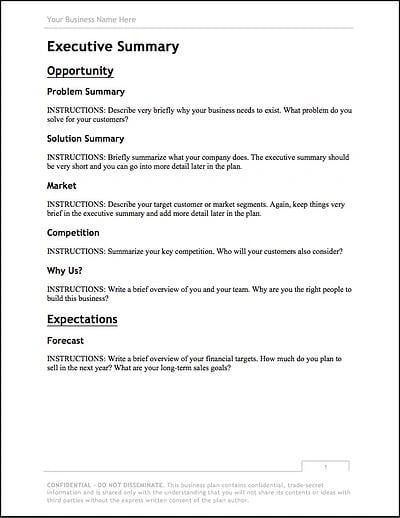
One of the more financially oriented sample business plans in this list, BPlan’s free business plan template dedicates many of its pages to your business’s financial plan and financial statements.
After filling this business plan out, your company will truly understand its financial health and the steps you need to take to maintain or improve it.
I absolutely love this business plan template because of its ease-of-use and hands-on instructions (in addition to its finance-centric components). If you feel overwhelmed by the thought of writing an entire business plan, consider using this template to help you with the process.
6. Harvard Business Review’s "How to Write a Winning Business Plan"
Most sample business plans teach you what to include in your business plan, but this Harvard Business Review article will take your business plan to the next level — it teaches you the why and how behind writing a business plan.
With the guidance of Stanley Rich and Richard Gumpert, co-authors of " Business Plans That Win: Lessons From the MIT Enterprise Forum ", you'll learn how to write a convincing business plan that emphasizes the market demand for your product or service.
You’ll also learn the financial benefits investors can reap from putting money into your venture rather than trying to sell them on how great your product or service is.
This business plan guide focuses less on the individual parts of a business plan, and more on the overarching goal of writing one. For that reason, it’s one of my favorites to supplement any template you choose to use. Harvard Business Review’s guide is instrumental for both new and seasoned business owners.
7. HubSpot’s Complete Guide to Starting a Business
If you’re an entrepreneur, you know writing a business plan is one of the most challenging first steps to starting a business.
Fortunately, with HubSpot's comprehensive guide to starting a business, you'll learn how to map out all the details by understanding what to include in your business plan and why it’s important to include them. The guide also fleshes out an entire sample business plan for you.
If you need further guidance on starting a business, HubSpot's guide can teach you how to make your business legal, choose and register your business name, and fund your business. It will also give small business tax information and includes marketing, sales, and service tips.
This comprehensive guide will walk you through the process of starting a business, in addition to writing your business plan, with a high level of exactitude and detail. So if you’re in the midst of starting your business, this is an excellent guide for you.
It also offers other resources you might need, such as market analysis templates.
8. Panda Doc’s Free Business Plan Template

PandaDoc’s free business plan template is one of the more detailed and fleshed-out sample business plans on this list. It describes what you should include in each section, so you don't have to come up with everything from scratch.
Once you fill it out, you’ll fully understand your business’ nitty-gritty details and how all of its moving parts should work together to contribute to its success.
This template has two things I love: comprehensiveness and in-depth instructions. Plus, it’s synced with PandaDoc’s e-signature software so that you and other stakeholders can sign it with ease. For that reason, I especially love it for those starting a business with a partner or with a board of directors.
9. Small Business Administration Free Business Plan Template

The Small Business Administration (SBA) offers several free business plan templates that can be used to inspire your own plan.
Before you get started, you can decide what type of business plan you need — a traditional or lean start-up plan.
Then, you can review the format for both of those plans and view examples of what they might look like.
We love both of the SBA’s templates because of their versatility. You can choose between two options and use the existing content in the templates to flesh out your own plan. Plus, if needed, you can get a free business counselor to help you along the way.
I’ve compiled some completed business plan samples to help you get an idea of how to customize a plan for your business.
I chose different types of business plan ideas to expand your imagination. Some are extensive, while others are fairly simple.
Let’s take a look.
1. LiveFlow

One of the major business expenses is marketing. How you handle your marketing reflects your company’s revenue.
I included this business plan to show you how you can ensure your marketing team is aligned with your overall business plan to get results. The plan also shows you how to track even the smallest metrics of your campaigns, like ROI and payback periods instead of just focusing on big metrics like gross and revenue.
Fintech startup, LiveFlow, allows users to sync real-time data from its accounting services, payment platforms, and banks into custom reports. This eliminates the task of pulling reports together manually, saving teams time and helping automate workflows.
"Using this framework over a traditional marketing plan will help you set a profitable marketing strategy taking things like CAC, LTV, Payback period, and P&L into consideration," explains LiveFlow co-founder, Lasse Kalkar .
When it came to including marketing strategy in its business plan, LiveFlow created a separate marketing profit and loss statement (P&L) to track how well the company was doing with its marketing initiatives.
This is a great approach, allowing businesses to focus on where their marketing dollars are making the most impact. Having this information handy will enable you to build out your business plan’s marketing section with confidence. LiveFlow has shared the template here . You can test it for yourself.
2. Lula Body

Brooklyn Business owner and Pilates instructor, Tara Kashyap , saw a need in her community for a Pilates, tissue, and bodywork studio. In response, she opened Lula Body in Crown Heights.
Pictured above is a hypothetical pricing and revenue statement based on Lula Body’s business plan. As you can see, Kashyap breaks down the cost of classes, start-up expenses, monthly expenses, and her monthly sales projection.
Everything from equipment costs to loan interest is included in the expenses to give the most accurate picture of operating costs and revenue.
If you’re seeking outside funding for your business, you’ll want to make sure this section of your business plan is as thorough as possible.
This is a good business plan example for service-based businesses such as gyms, boxing classes, dancing studios, etc. For starters, the plan shows how to budget for the business loan and what to focus on buying first.
Everything is well presented, including what to charge the customers in different scenarios and the expected revenue. This is a good foundation from which business performance can be evaluated with time.
3. Patagonia

Sometimes all you need is a solid mission statement and core values to guide you on how to go about everything. You do this by creating a business plan revolving around how to fulfill your statement best.
For example, Patagonia is an eco-friendly company, so their plan discusses how to make the best environmentally friendly products without causing harm.
A good mission statement should not only resonate with consumers but should also serve as a core value compass for employees as well.
Patagonia has one of the most compelling mission statements I’ve seen:
"Together, let’s prioritise purpose over profit and protect this wondrous planet, our only home."
It reels you in from the start, and the environmentally friendly theme continues throughout the rest of the statement.
This mission goes on to explain that they are out to "Build the best product, cause no unnecessary harm, and use business to protect nature."
Their mission statement is compelling and detailed, with each section outlining how they will accomplish their goal.
4. Vesta Home Automation

This executive summary for a smart home device startup is part of a business plan created by students at Mount Royal University .
While it lacks some of the sleek visuals of the templates above, its executive summary does a great job of demonstrating how invested they are in the business.
Right away, they mention they’ve invested $200,000 into the company already, which shows investors they have skin in the game and aren’t just looking for someone else to foot the bill.
This is the kind of business plan you need when applying for business funds. It clearly illustrates the expected future of the company and how the business has been coming along over the years.
5. NALB Creative Center

This fictional business plan for an art supply store includes everything one might need in a business plan: an executive summary, a company summary, a list of services, a market analysis summary, and more.
One of its most notable sections is its market analysis summary, which includes an overview of the population growth in the business’ target geographical area, as well as a breakdown of the types of potential customers they expect to welcome at the store.
This sort of granular insight is essential for understanding and communicating your business’s growth potential. Plus, it lays a strong foundation for creating relevant and useful buyer personas .
It’s essential to keep this information up-to-date as your market and target buyer changes. For that reason, you should carry out market research as often as possible to ensure that you’re targeting the correct audience and sharing accurate information with your investors.
Due to its comprehensiveness, it’s an excellent example to follow if you’re opening a brick-and-mortar store and need to get external funding to start your business .
6. Curriculum Companion Suites (CSS)

If you’re looking for a SaaS business plan example, look no further than this business plan for a fictional educational software company called Curriculum Companion Suites.
Like the business plan for the NALB Creative Center, it includes plenty of information for prospective investors and other key stakeholders in the business.
One of the most notable features of this business plan is the executive summary, which includes an overview of the product, market, and mission.
The first two are essential for software companies because the product offering is so often at the forefront of the company’s strategy. Without that information being immediately available to investors and executives, then you risk writing an unfocused business plan.
It’s essential to front-load your company’s mission if it explains your "Why?" and this example does just that. In other words, why do you do what you do, and why should stakeholders care? This is an important section to include if you feel that your mission will drive interest in the business and its offerings.
7. Culina Sample Business Plan

Culina's sample business plan is an excellent example of how to lay out your business plan so that it flows naturally, engages readers, and provides the critical information investors and stakeholders need.
You can use this template as a guide while you're gathering important information for your own business plan. You'll have a better understanding of the data and research you need to do since Culina’s plan outlines these details so flawlessly for inspiration.
8. Plum Sample Business Plan

When creating your own business plan, make sure the pictures and design you use make sense for your branding. The images in this plan are cutting-edge, which makes sense for an innovative company like Plum.
This is one of my favorite sample business plans because you can see how implementing visuals can help tell your brand's story. Additionally, the financial charts included are an excellent guide if you're not sure what financial information to include.
9. LiveShopBuy Sample Business Plan

With this business plan, the focus is the investment opportunity. This is an excellent template to use if you're going to use your business plan to seek funding.
The investment opportunity section is placed right up front and is several pages long. Then, it goes into more detail about the company and its key services. Nice.
Get Started Writing Your Business Plan
When you're first getting started on your business plan, I know it can be daunting. The business world moves fast, and it’s full of ambitious companies scrambling to gain the majority of their industry’s market share.
That's why it's important to make sure you understand the value your business offers and can communicate that through a properly formatted business plan.
Editor's note: This post was originally published in November 2018 and has been updated for comprehensiveness. This article was written by a human, but our team uses AI in our editorial process. Check out our full disclosure to learn more about how we use AI.

Don't forget to share this post!
Related articles.
![sales plan in business plan sample How to Write a Powerful Executive Summary [+4 Top Examples]](https://blog.hubspot.com/hubfs/executive-summary-example_5.webp)
How to Write a Powerful Executive Summary [+4 Top Examples]

19 Best Sample Business Plans & Examples to Help You Write Your Own

What is a Business Plan? Definition, Tips, and Templates

Maximizing Your Social Media Strategy: The Top Aggregator Tools to Use

The Content Aggregator Guide for 2023
![sales plan in business plan sample 7 Gantt Chart Examples You'll Want to Copy [+ 5 Steps to Make One]](https://blog.hubspot.com/hubfs/gantt-chart-example.jpg)
7 Gantt Chart Examples You'll Want to Copy [+ 5 Steps to Make One]
![sales plan in business plan sample The 8 Best Free Flowchart Templates [+ Examples]](https://blog.hubspot.com/hubfs/flowchart%20templates.jpg)
The 8 Best Free Flowchart Templates [+ Examples]

16 Best Screen Recorders to Use for Collaboration

The 25 Best Google Chrome Extensions for SEO

Professional Invoice Design: 28 Samples & Templates to Inspire You
2 Essential Templates For Starting Your Business
Marketing software that helps you drive revenue, save time and resources, and measure and optimize your investments — all on one easy-to-use platform

Sales Plan 101: Definition, Types, Template
Any business is all about sales. Whether a company practices B2B or B2C, the main goal is to receive revenue. Only a steady approach with a defined sales plan can guarantee a successful outcome.
A strategic sales plan is the map for business processes related to trading, dealing with customers, and organizing sales operations . In this article, you will learn the definition of a sales plan, its structure, and types. Moreover, you will get acquainted with a sales plan template and the basics of creating it.
Sales plan is the hub around which the entire operations of the company revolve around.
A sales plan is a business plan that features the development of the company’s sales activity with set objectives within a particular time frame.
In other words, it’s a strategic plan where one specifies sales goals, tactics, challenges, target market and steps you will take to execute the plan.
Setting goals and time frame to achieve them isn’t the only aim. Give the same importance to working out tactics and a precise sales strategy . This part includes analyzing all the resources, deciding on the amount to use, and describing the specific activities.
Download Free Sales Planning Template Now!

The Structure of a Sales Plan
Sales plan examples differ, depending on the exact type. But we will pay closer attention to this a bit later in the article. Generally, it includes nine areas of strategic business development. They are:
1) Executive summary
Executive summary is like laying the foundation bricks of your organization. State your company’s vision and mission. What is the ultimate sales goal ? To reach X million revenue by Q4 2021, or increase share price to X amount. In your executive summary, include background on your company’s founding story and how you got to where you are and where you want the company to be in X years.
2) Set business goals, including revenue targets
You can either set a revenue-based goal or a volume-based goal like having a target of $100 mn Annual Recurring Revenue or expanding product portfolio, or increasing customer base. Keep an achievable revenue or volume target; only then your sales plan can be achieved.
3) A brief analysis of the performance during the prior period
Give some context to your sales team on the previous year’s performance to know where they are and what needs to be done differently to get to where you want to.
4) Industry and market overview
Competitor analysis, swot analysis, industry trend reports and market research go a long way in understanding your market position. Having a keen eye for this in your sales planning helps craft your sales plan better.
5) Description of strategies, tactics
For instance, if your goal is to achieve 100 mn revenue, what is the sales strategy to achieve this number? Then your sales plan should include the following tactics-
- Introduce aggressive selling strategies
- Tap new markets
- Give deep discounts
- Retarget customers
- Cross-sell products to existing customers
6) Customer segments
Your entire sales team should have clarity on who they are selling to, always. Your sales plan should include target audience, target industries, and ideal customer profiles that your company caters to with its products and services.
7) Resources and team capabilities
If your sales team is tiny, how do you expand your team to meet sales targets and achieve the sales plan? Hiring guidance should also be included in the sales plan. If your outbound sales team is running thin, then your sales plan should state how many resources are required over a particular period and should have a sound outbound hiring strategy in place.
8) A detailed plan for a team and each member
Ensure clear delegation of roles and responsibilities and at each stage, there should be smooth handoffs and communication. Having a CRM can help bring visibility into the sales pipeline and process for all team members.
9) Budgets
An essential element of the sales plan is the budget for the year. How much are you willing to spend to achieve your goals? This would include salaries, bonuses, commissions, training costs, team building activity costs, resources spends, and miscellaneous costs.
Any sales plan sample consists of these sections. You can alter some of it if they are not necessary for your organization. You can tailor it to suit your organization’s culture and processes.

What Are the Benefits of a Sales Plan for Business
In pursuing high revenues, sales managers work out an exact sales plan, including determining strengths, weaknesses, opportunities, and risks – SWOT-analysis in the business language.
Having a sales plan helps to do this in terms of sales activities. Here is the list of benefits a company would reap if it has a well-structured sales plan:
1) Clear goals and revenue targets to achieve within a limited period
With an organized sales plan in place, every team member is clear on what they need to contribute to your organization’s success. For example, your sales goal could be to leverage $5,000 in five new deals within a month.
2) Specific ways of achieving the target
A sales plan lays out the tactics to achieve sales targets. Define the target audience, marketing tools, and techniques to use in your sales plan. For instance, some companies employ guerilla marketing tactics to achieve aggressive sales targets.
3) Unified labor policies that contribute to operations consistency
All procedures related to your sales teams, campaigns, employees, etc. form a part of your sales plan. Include compensation packages, commission rules, leave policies, in your sales plan, etc.
4) Deep understanding of the company’s strengths and weaknesses
Sales plan should gear your sales team to bring out the strengths of your company. Include competitive battle cards and SWOT analysis in your sales plan to focus on your product strengths.
5) Ability to effectively track progress
If an employee fails to meet the predetermined sales goals, rethink the sales approach or provide additional sales training.
6) Discipline and diligence
For instance, an employee is more task-oriented, once he knows he must close five deals per month.
Types of Sales Plans
There is no unified sample sales plan template. They differ according to the company’s purpose. Although most of the sales plans are rather similar, the following types can be distinguished:
- Annual/quarterly/weekly sales plan – It’s a traditional business sales plan that features revenue goals, tactics, and specific time period by when it should be accomplished.
- 30 60 90 sales plan – This milestone based sales plan specifies a goal to achieve within set milestones – 30, 60 or 90 days – and is ideal for new sales managers. Helps draw up strategic and tactical activities based on this plan.
- Sales budget plan – A sales plan that provides a forecast of factors that could influence revenue within a specific timeframe
- Sales tactics plan – This is a tactical sales plan that includes execution strategy, detailed daily or weekly plans such as email follow-up frequency, meeting appointments, and prescribed call sequences for different sales teams.
- Territory-based sales plan – It features tactics for sales teams across different territories, considering the working environment and market dynamics of a specific area.
- Sales focus area plan – This plan dives deep into different sales domains like sales compensation or sales training plan.

10 Steps to Create a Sales Plan
These ten steps will help to create a sales plan:
1) State Your Company’s Mission
The foremost step is to define the company’s mission, e.g., delivering the best user experience through innovation. Whether you sell a commercial retractable awning , groceries, or clothes, the operations should be consistent with brand values. According to the data from Lucidpress , brands with consistent presentation has increased the revenue by 33%.
2) Set Objectives and Timeframe
Define the objective and time within which a sales team has to achieve them. For example, drive $10,000 in revenue within a month.
3) Describe a Team
There are many types of sales teams. For example:
- The island: Involves an owner and sales representatives responsible for every step of the sales process (generating and qualifying leads, closing deals) on their own.
- The assembly line: A sales force is broken down by functions (e.g., a lead generation team, sales development representatives or prospectors, account executives, a customer success team). A customer moves to a new team as the sales process unfolds.
- The pod: A team consists of sales development representatives, account executives, and a customer success representative.
4) Define a Target Market
The target market is a starting point for working out further tactics.
Group your target audience by income groups, like high-net-worth individuals or middle-income groups. You can even group them based on B2B or B2C customers, and so on.
The core aspect is to describe the target audience precisely. For instance, for a women apparel store in NYC – women 18-40 years old live in NYC and its boroughs. Stating your ideal customer profile helps market a product with minimum costs and maximum effectiveness.
5) Evaluate the Resources
A company has to know its assets. In terms of a sales plan, businesses should analyze those which are related to the operations, e.g., the number of sales employees and the level of their expertise, the budget, the equipment (phones, marketing tools, computers, cars).
6) Make a Comparative Analysis with Competitors
Market overview and analysis are crucial in any business plan. It’s vital to know where business, its product, or service stands. One has to explain the distinguishing features that make the business stand out from others. For example, an innovative product, free delivery, convenient location, higher expertise, etc.
7) Set the Budget
Layout all the costs that you think you will incur to achieve those sales targets. Some of the expenses that are part of sales plans include salaries, commissions, sales tools , training, travel, printing costs, hiring costs, etc, which ultimately determine the budget. For example, according to your estimates, it will account for $5,000 per month. Consider this while setting revenue targets.
8) Define Company’s Marketing Strategy
This step implies describing pricing and promotions. It’s isn’t the final step, so some of the promotions a company included in the plan may change later. Also, one has to mention core actions a business is going to take in order to increase brand awareness and generate leads. For example, in the very beginning of Fortuna Visual we practiced a 20% discount for clients who will recommend us to others.
9) Work Out the Strategy
This stage is where a company states how the sales team must qualify the generated leads. Apart from the exact tactics, one has to determine the criteria for prospects to meet before sales representatives reach out. (e.g., a company operates for five years minimum, its annual income is $100,000).
10) Define an Action Plan
Summarizing the plan to reach each particular objective. For example, a sales goal, such as a 20% increase in referrals. Actions:
- Hold a referrals techniques workshop
- Run contest for referral sales
- Increase commission on referral sales by 5%.
There is no single plan that can fit your company perfectly. There will be hurdles along the way, and you can always mold the shape of your sales plan until you start seeing favorable results. Take your time to identify opportunities and ways to overcome challenges.

Related Posts
How to meet sales targets every quarter, inbound vs outbound sales: how doing both can maximize results, subscribe for blog updates.
Thank you for subscribing!
OOPS! something went wrong try after sometime
How to Write a Yoga Studio Business Plan + Free Sample Plan PDF
Elon Glucklich
6 min. read
Updated April 3, 2024
Free Download: Sample Yoga Studio Business Plan Template
Yoga’s popularity is surging. With more adults focused on personal wellness, the physical and mental benefits of yoga have attracted over 36 million people in the U.S. to practice yoga regularly. And the trend has created a growing market for dedicated yogis with an entrepreneurial streak to turn their passion into a thriving business.
But running a successful yoga studio requires more than knowledge of the craft. A business plan helps you document all the important decisions and key details you’ll need to cover to be successful. It organizes your research, and gets you to think strategically about the impact of everything from your studio location to class pricing.
It’s also crucial if you’re seeking a bank loan or other source of outside funding. Lenders and investors will want to see a clear plan before committing resources to your studio.
- What should you include in a yoga studio business plan?
No two yoga studios are alike. But there are a few sections we recommend including in your yoga studio business plan, no matter what your vision is:
Executive summary
Products and services, market analysis, marketing and sales plan.
- Financial plan
If you’re looking for a bank loan or investment to fund your studio, it’s a safe bet to follow a traditional structure when writing your business plan . Otherwise, just focus on the sections you feel are relevant.
The executive summary introduces your vision and sets the tone for the rest of your business plan. Your executive summary shouldn’t run over 1-2 pages and should be written last, since it summarizes the entire plan.
A reader should understand the essence of your business from this section alone. Does your yoga studio provide a haven for stressed urbanites of all ability levels? Do you cater to yoga enthusiasts by offering advanced classes? Briefly describe the problem you solve for clients.
Then, outline your studio’s focus. Describe any unique programs you offer, such as:
- Mindfulness programs
- Flexibility classes for athletes
- Restorative sessions for people recovering from injuries.
You should also briefly touch on who your target market is, and why your yoga studio is uniquely positioned to attract them.
The products and services section of your business plan lays out your revenue streams. Start with your core offerings: What yoga classes do you offer?
Besides the basics — Vinyasa, Gatha, restorative, etc. — emphasize the expertise of your instructors, as well as any specialties you offer, like beginner-focused or prenatal classes. You should also describe your class structure and pricing options, such as:
- Memberships
- Class packages
In addition to classes, look at related products or services you might be able to turn into revenue streams. They could include:
- Yoga apparel, equipment, and wellness products
- Workshops and teacher training
- Online classes and retreats
Understanding your customers is key to running a profitable business.
You need to create a portrait of your ideal client before you can develop effective strategies for reaching them. Your market analysis is where you document the demographic and behavioral traits of your target customers.
Your actual customer mix may vary, but do you generally envision serving:
- Young professionals
- Active seniors
What about location and income level? Based on where your studio is located and who your ideal clients are, do you emphasize affordability or a premium experience?
You should also consider the lifestyle factors, values, and motivations of your customers. What’s most important for your customers when they come into your studio? Is it:
- A strenuous workout
- Stress relief
- Spiritual well being
- Physical rehabilitation
You also need to size up your competition . Note the strengths and weaknesses of other yoga studios, gyms, meditation centers, and online classes. Compare their services and pricing to your own.
Understanding how you stack up will focus your market research and help you hone in on your competitive advantage as you develop your marketing strategy.
This section explains how you will spread the word about your studio, and turn potential customers into paying clients.
Your market research should have helped you create a picture of your ideal customer. Now, describe your marketing strategies for reaching them.
Social media is a powerful medium for connecting with your community of yoga enthusiasts. You can post inspiring messages and engaging videos to showcase your studio and classes on channels like Instagram, TikTok, and Facebook. Consider targeted social media ads as well.
Beyond social media, consider marketing tactics like:
- Posting engaging videos and inspiring messages on your social media channels
- Buying digital or print advertisements
- Writing blog posts and creating videos for your website to highlight your expertise
- Forming partnerships with local wellness-focused businesses
- Holding special promotions like free classes at community events
While your marketing strategy aims to increase awareness of your yoga studio, your sales plan describes how you will translate this attention into revenue for your business.
Explain in your plan how you enroll customers, and whether you offer flexible options like paying on a per-class basis, or require memberships. Describe whether you provide any special offers like free or discounted trial classes, or incentives for current members who refer friends.
It’s important to remember that none of these tactics should be set in stone. A business plan is meant to evolve with your business, and you should be testing your marketing and sales strategies, determine what’s working and adjust accordingly.
Financial Plan
The financial section of your business plan can seem daunting, but it’s not as complicated as it sounds. All businesses have to track their sales and expenses, and creating a financial plan involves using those figures to project how your business will perform, and whether you will be profitable.
Let’s break down the components of a financial plan.
Sales forecast : Project your revenue based on class attendance, memberships, retail sales, workshops, and any other income sources. Be realistic, especially in the beginning.
Expense Budget : List all of your costs, including:
- Rent and utilities
- Instructor pay
- Yoga supplies and equipment:
- Cleaning supplies
- Marketing expenses
Profit & Loss (P&L) : Your income after expenses are taken out, showing if you’re generating a profit.
Cash flow statement : Key for managing your yoga studio from day to day, it predicts how much cash you have on hand at any time to ensure you can pay instructors and bills.
Balance Sheet : An overview of your studip’s financial standing, listing assets (cash, equipment), liabilities (any loans), and the owner’s equity in the business.
Startup costs : If you’re writing a business plan because you’re seeking a bank loan to start or expand your yoga studio, detail expenses like studio build-out, equipment purchases, and initial marketing.
Be upfront about any predictions in your sales forecast, such as the number of clients you expect to serve and how much revenue you’ll bring in if you add classes or increase prices (researching financial data for yoga studios will be helpful here). Remember, these projections are basically educated guesses, and they’re meant to be updated over time as you run your business and get actual data.
- Download your free yoga studio sample business plan
Download our yoga studio sample business plan for free right now to help you beat writer’s block and get started on your own business plan. You can copy and paste sections from the sample plan and customize them for your business.
Check out our other fitness and beauty sample business plans as well, or browse from the full Bplans collection of over 550 sample business plans to get inspired.
See why 1.2 million entrepreneurs have written their business plans with LivePlan
Elon is a marketing specialist at Palo Alto Software, working with consultants, accountants, business instructors and others who use LivePlan at scale. He has a bachelor's degree in journalism and an MBA from the University of Oregon.

7 Min. Read
How to Write a Real Estate Investment Business Plan + Free Sample Plan PDF

6 Min. Read
How to Write a Law Firm Business Plan + Free Sample Plan PDF

How to Write a Fix-and-Flip Business Plan + Free Template PDF

How to Write a Bakery Business Plan + Sample
The Bplans Newsletter
The Bplans Weekly
Subscribe now for weekly advice and free downloadable resources to help start and grow your business.
We care about your privacy. See our privacy policy .
Tax Season Savings
Get 40% off LivePlan
The #1 rated business plan software
Transform Tax Season into Growth Season
Discover the world’s #1 plan building software

Your sales plan is a roadmap that outlines how you'll hit your revenue targets, who your target market is, the activities needed to achieve your goals and any roadblocks you may need to overcome. Many business leaders see their sales plan as an extension of the traditional business plan. The business plan contains strategic and revenue goals ...
Business Development Strategic Sales Plan. Download Now: Free Strategic Business Planning Template. A strategic sales plan for business development will focus on attracting new business to your company by networking with other companies, sponsoring events, and doing outreach. In your sales plan, you'll want to choose the right KPIs that best ...
Here's how to take it one step at a time. 1. Connect sales plan data with your CRM. It's important to build your sales plan in customer relationship management (CRM) software. When you have all your sales data in one central place, updated in real-time, real world changes show up as misalignments in the data.
Download as Word Doc. Download as Google Doc. 1. Establish Your Mission Statement. A mission statement summarizing why you're in business should be part of your action plan for sales. It should include a broad overview of your business' products or services and your brand's unique selling proposition.
Here's the point: Focus on value, not features in your sales plan template. Your competitive advantage will inform everything your company does moving forward, from marketing to product development. It's a great example of where sales can influence the development of a product and the direction of a business. 6.
2. Assess the current situation. The next step is to create an honest overview of your business situation in relation to the goal you set in the first step. Review your strengths and assets. Take ...
Goal 1: Increase sales across company's range of products and services. A better goal would look something like: Goal 1: Generate $500,000+ in revenue from new clients through purchases of X product by X date. 9. Action Plan. Now that you've laid out your goals, you need to explain how you will hit them.
Here is a snapshot of the winning sales business plan that helped shape Nimble into the industry leader it is today: Objectives- To provide a single, socially enriched system of record that helps businesses and small business teams cultivate relationships at scale. Customer Focus- Small business teams working primarily in small businesses ...
2. Organize the team and roles within the team. Part of the planning includes organizing a group of people that will work together to meet the goals laid out in the plan. Create a branded org chart visualizing team roles and responsibilities. Include this chart on a page in your sales plan; make it part of the process.
Here are a few helpful tips for creating your sales plan: 1. Gather sales data and search for trends. To create a sales plan, you need to plan for the present and future. And in order to do that, your sales leaders need to look at past performance to identify any impactful sales trends.
Number of new clients you want to convert; Number of existing customers you plan to nurture and retain; Sales goals around a new product or service you are offering. 2. Review of goals, tactics, and performance from a prior period. If you write an annual sales plan, you can briefly recap the previous year, its goals, scope of work, and results.
5. Take stock of resources. Once you collect the bulk of the data and get a general idea of what to accomplish with your sales plan, take inventory of your resources. Some tools you'll want to have throughout the process include: CRM software, integrations, and automations. Lead gen, prospecting, and outreach tools.
Take a look at our hand-picked selection of the best sales plan templates available today for Microsoft Word and sales enablement tools like ClickUp. 1. ClickUp Sales Plan Template. Create and organize tasks by team, deliverable type, priority, due dates, and approval state with the ClickUp Sales Plan Template.
Shifting the goalposts. Failing to ask for sound advice. Not having a feedback mechanism. 2. Have clear deadlines and milestones. You need to know if the assumptions you are making in your sales plan are close to your target. To do this, split that big plan into smaller goals (deliverables) with strict deadlines.
13 Sales Plan Template Examples. Remember that your company's strategic sales plan will be highly unique. It may take some time and tweaking to find the components and format that best meet the needs of your business. Here are 13 sales plan templates to help you get started. 1. Product Launch Plan Template.
To create an action plan, follow this simple process: Set an objective. List down the tasks that will help you accomplish the objective. 10. Budget. Lay out the costs that will come with hitting your sales goals. To make sure that your sales plan budget is accurate, compare it with your sales forecast.
1. Mission and Background. Begin your sales plan by stating your company mission and vision statements. And write up a brief history of the business — this will provide background information as ...
This Breaking Into Device template above is an example of the 30-60-90 plan in that it focuses on the long-term goal of change at the end of three months. In a typical 30-60-90 sales plan, you would state your goals, the action steps you will use to reach them, your target dates, and your metrics for success. 3.
A successful sales and marketing plan is based on the estimated market share and sales included in the business's original business plan. It requires research into the demographics of the intended customer base and an algorithm to determine pricing along with a well-defined budget tied to a particular time frame (quarterly, annually, etc.).
Template 4: Sales and Marketing Plan for Business Growth PPT. This PPT delves into crucial topics of sales such as, goals, targets, strategies, measurement, and tactics. This dynamic presentation provides you with a roadmap to propel your business toward success.
8. Panda Doc's Free Business Plan Template. PandaDoc's free business plan template is one of the more detailed and fleshed-out sample business plans on this list. It describes what you should include in each section, so you don't have to come up with everything from scratch.
A sales plan is a business plan that features the development of the company's sales activity with set objectives within a particular time frame. In other words, it's a strategic plan where one specifies sales goals, tactics, challenges, target market and steps you will take to execute the plan. Setting goals and time frame to achieve them ...
Follow these steps to successfully create a strong business plan: 1. Gather key documents. You should plan out your document before officially writing it by gathering key information to reference and detail. Collect sales data from the previous year or two and identify any key trends.
1. Regular reviews and updates. Markets shift, consumer behavior changes, and your business will grow. Your plan must evolve with these factors, which makes regular reviews and updates a must-do ...
Marketing and sales plan. This section explains how you will spread the word about your studio, and turn potential customers into paying clients. ... Download our yoga studio sample business plan for free right now to help you beat writer's block and get started on your own business plan. You can copy and paste sections from the sample plan ...

IMAGES
VIDEO
COMMENTS
As we briefly mentioned, Travel Trailers come in a large variety of styles and can be anywhere from 8 to 40 ft. in length. Depending on the specific model, Travel Trailers typically include living spaces, multiple sleeping areas, kitchens, and bathrooms. Smaller Travel Trailers will normally include dinettes, murphy beds, and many dual purpose ...
Make An Offer. General RV Ashland (888) 819-2215. Ashland, VA 23005. 90 miles away. Auction off your classic for only $29.95 for a limited time! Let the bidders drive up the price of your classic car to make more at auction! Get your $29.95 ad now.
Top Travel Trailers by Make. Airstream 4 Airstream RVs for sale. Carriage 1 Carriage RVs for sale. Chalet 1 Chalet RVs for sale. Coachmen 1 Coachmen RVs for sale. Dutchmen 1 Dutchmen RVs for sale. Forest River 18 Forest River RVs for sale. Grand Design 12 Grand Design RVs for sale. Heartland 2 Heartland RVs for sale.
Used Travel Trailer RVs for Sale. Used Travel Trailer RVs. for Sale. View Makes | View New | View States | About Travel Trailer RVs. View our entire inventory of Used rvs and even a few new non-current models on RVTrader.com. Top Makes. (648) Forest River. (127) Keystone. (79) Heartland.
2019 Cruiser Shadow Cruiser. Call for Price. Johnson RV Fife (844) 250-2309. Fife, WA 98424. 119 miles away. Auction off your classic for only $29.95 for a limited time! Let the bidders drive up the price of your classic car to make more at auction! Get your $29.95 ad now. Advertisement.
Sell Your RV. Millions of buyers are looking for their next RV on RV Trader this month. We're Fast! We're Safe! We're Affordable! Sell, search or shop online a wide variety of new and used recreational vehicles, motorhomes, travel trailers, fifth wheels, campers et al via RV Trader.
Find Campers for Sale in Moscow, ID on Oodle Classifieds. Join millions of people using Oodle to find unique used motorhomes, RVs, campers and travel trailers for sale, certified pre-owned motorhome listings, and new motor home and travel trailer classifieds. ... Campers for Sale in Moscow, ID (1 - 10 of 10) $19,950 Brand New 2021 Rockwood A ...
WE'LL HELP YOU FIND THE USED TRAVEL TRAILER THAT'S RIGHT FOR YOU. Our collection of used travel trailers for sale help you save money without cutting corners on quality and fun. Meet with Camping World RV sales' team of experts and find the used camper that checks everything off your list. Stop by one of our RV dealerships today or browse our ...
This towable camper provides all the comforts of home and is perfectly adaptable for weekend getaways, family vacations or full timing. With high-end luxury models as well as lite-weight teardrop models to choose from, prices range from $9,000 to $76,000. Find your perfect Travel Trailer rv for sale from the search results below.
TRAVEL TRAILERS For Sale. Camping World has more than 15,000 towable RVs available, including new and used Travel Trailers. These RVs have many floor plans available and range from small lightweight units under 20 feet weighing less than 2,500 pounds to large travel trailers of more than 40 feet. At Camping World, we want you to enjoy RV living with your significant other in a couples-only ...
Find great deals on new and used RVs, used campers, travel trailers, toy haulers, pop up campers and more on Facebook Marketplace.
Find trailers and RVs for sale near you. Select from over 150,000 trailers and recreational vehicles from Airstream, Jayco, Load Trail, PJ Trailers, Forest River, Coachmen, Travel Lite, Keystone, Big Tex, Aluma, Dutchmen, and hundreds of more brands.
Spacious Triple Slide Destination Travel Trailer, Two15,000 BTU AC's, 40,000 BTU Automatic Heater, Sliding Glass Patio Door,15ft Awning, Four Leveling Jacks, Rear Entertainment Center with Jensen Radio with Interior and Exterior Speakers a ... For Sale By Owner. Middlefield, OH. $35,695.00.
Renegade Verona 40VBH. 2022 | 28100 Miles. Glenwood, Maryland. $290,000. View Details. The best website to buy or sell used rvs for sale by owner. Find used motorhomes, used 5th wheels and for sale by owner trailers. List your used RV for sale for a one time listing fee until sold!
In 1938, it was granted town status. [citation needed]Administrative and municipal status. Within the framework of administrative divisions, it is incorporated as Elektrostal City Under Oblast Jurisdiction—an administrative unit with the status equal to that of the districts. As a municipal division, Elektrostal City Under Oblast Jurisdiction is incorporated as Elektrostal Urban Okrug.
Heartland 2 Heartland RVs for sale. Highland Ridge 1 Highland Ridge RVs for sale. Holiday Rambler 4 Holiday Rambler RVs for sale. Intech 1 Intech RVs for sale. Itasca 1 Itasca RVs for sale. JAYCO 8 JAYCO RVs for sale. Keystone 14 Keystone RVs for sale. KZ 1 KZ RVs for sale. Leisure Travel Vans 1 Leisure Travel Vans RVs for sale.
Search 42 Elektrostal' local handyman services to find the best handyman service for your project. See the top reviewed local handyman services in Elektrostal', Moscow Oblast, Russia on Houzz.
Search 3,027 Elektrostal' local furniture stores to find the best furniture and accessory company for your project. See the top reviewed local furniture stores and showrooms in Elektrostal', Moscow Oblast, Russia on Houzz.
Used RVs For Sale: 57,731 RVs Near Me - Find Used RVs on RV Trader.
SafariRVSource.com. Search safari rvs for sale, browse safari rvs by type, safari online classifieds a service of rvusa.com's rv classifieds. Used 2000 Safari Trek 2480. Used 2007
Available Colors. A Travel Trailer is an RV that is towed behind a vehicle that is used for recreational purposes. They are often known as "campers" and have become increasingly popular choices for RVers because they come in at a lower price point than Class A, B, or C models. Travel Trailers come in a variety of floor plans, sizes, and designs ...
With well over four decades of boatbuilding experience, Viking Yachts are some of the best known bluewater sportfishing yachts around. One particularly unique asset Viking possesses is the ability to build nearly every component of their boats in-house, which allows for the very best in quality control and semi-customization - about 90-percent of each Viking is formed, molded, or created .....
Disclaimers. Used RVs For Sale in Florida: 6,656 RVs - Find Used RVs on RV Trader.